-
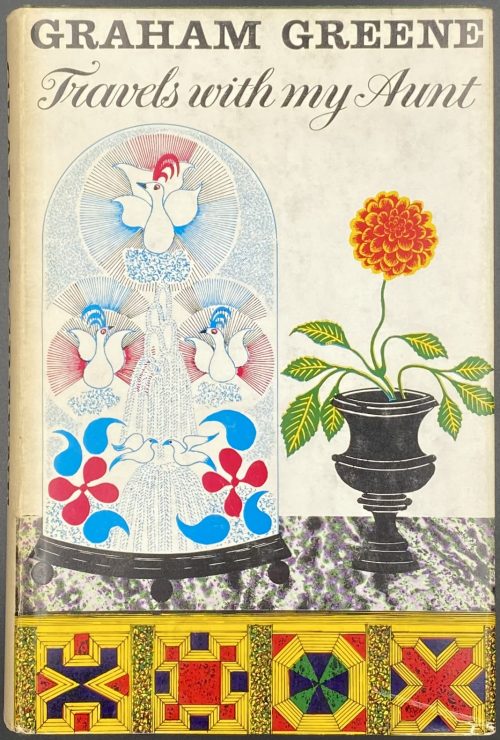 DJ: Graham Greene | Travels with my aunt || Title page: TRAVELS | WITH MY AUNT | A NOVEL | Graham Greene |{publisher’s device}| THE BODLEY HEAD | LONDON SYDNEY | TORONTO || Edition: 1st edition, 1st printing. Binding: 20.5 x 13.5 cm; publisher's green cloth, gilt lettering on spine, pictorial dust-jacket. Pagination: [1-8] 9 – 319 [320]. Collation: 16mo; [1]16, 2-1016 (total 160 leaves). Contributors: Graham Greene (British, 1904 – 1991) – author. Stephen Russ (British, 1919 – 1983) – DJ artist. The Bodley Head – publisher. William Clowes & Sons, Ltd. (Beccles) – printer.
DJ: Graham Greene | Travels with my aunt || Title page: TRAVELS | WITH MY AUNT | A NOVEL | Graham Greene |{publisher’s device}| THE BODLEY HEAD | LONDON SYDNEY | TORONTO || Edition: 1st edition, 1st printing. Binding: 20.5 x 13.5 cm; publisher's green cloth, gilt lettering on spine, pictorial dust-jacket. Pagination: [1-8] 9 – 319 [320]. Collation: 16mo; [1]16, 2-1016 (total 160 leaves). Contributors: Graham Greene (British, 1904 – 1991) – author. Stephen Russ (British, 1919 – 1983) – DJ artist. The Bodley Head – publisher. William Clowes & Sons, Ltd. (Beccles) – printer. -
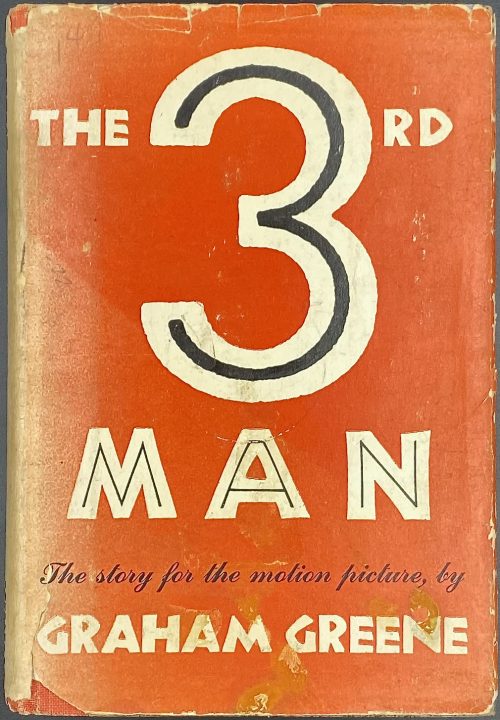 Title page: GRAHAM | GREENE | {vignette} | THE | THIRD MAN | NEW YORK • THE VIKING PRESS • 1950 || Title verso: COPYRIGHT 1949, 1950 BY GRAHAM GREENE | PUBLISHED BY THE VIKING PRESS IN MARCH 1950 | PUBLISHED ON THE SAME DAY IN THE DOMINION OF CANADA | BY THE MACMILLAN COMPANY OF CANADA LIMITED | A condensed version appeared | in The American Magazine, | {publisher’s device} | PRINTED IN U.S.A. BY THE COLONIAL PRESS INC. || Pagination: [1-6] 7-157 [158] [2] blank. Binding: quarter red cloth over grey cloth boards with black lettering to spine, pictorial dust jacket with lettering to front, back and spine, unclipped, $2.00 in the upper-right corner of the front flap. Size:19.5 x 13.5 cm. Edition: 1st American edition. Contributors: Henry Graham Greene (British, 1904 – 1991) – author. The Viking Press, NY (1925 – 1975) – publisher. The Colonial Press, Inc – printer.
Title page: GRAHAM | GREENE | {vignette} | THE | THIRD MAN | NEW YORK • THE VIKING PRESS • 1950 || Title verso: COPYRIGHT 1949, 1950 BY GRAHAM GREENE | PUBLISHED BY THE VIKING PRESS IN MARCH 1950 | PUBLISHED ON THE SAME DAY IN THE DOMINION OF CANADA | BY THE MACMILLAN COMPANY OF CANADA LIMITED | A condensed version appeared | in The American Magazine, | {publisher’s device} | PRINTED IN U.S.A. BY THE COLONIAL PRESS INC. || Pagination: [1-6] 7-157 [158] [2] blank. Binding: quarter red cloth over grey cloth boards with black lettering to spine, pictorial dust jacket with lettering to front, back and spine, unclipped, $2.00 in the upper-right corner of the front flap. Size:19.5 x 13.5 cm. Edition: 1st American edition. Contributors: Henry Graham Greene (British, 1904 – 1991) – author. The Viking Press, NY (1925 – 1975) – publisher. The Colonial Press, Inc – printer. -
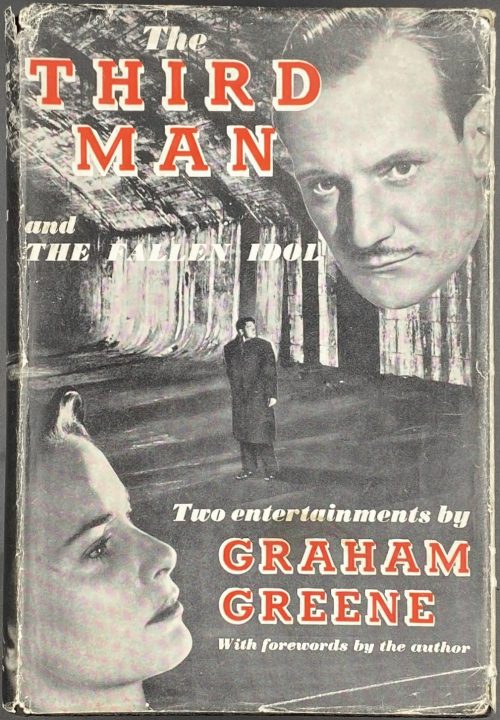 Title page: THE THIRD MAN | and | THE FALLEN IDOL | by | GRAHAM GREENE | {publisher’s device with lettering} |WILLIAM HEINEMANN LTD | MELBOURNE : : LONDON : : TORONTO || Title verso: FIRST PUBLISHED 1950 | PRINTED IN GREAT BRITAIN | AT THE WINDMILL PRESS | KINGSWOOD, SURREY || Pagination:[6] [1, 2] 3-188 [2] blank. Binding: publisher’s black cloth, silver lettering to spine, blind-stamped publisher’s device to back cover in the lower-right corner without lettering; publisher's pictorial dust jacket with lettering (white and read on b/w photo): The | THIRD | MAN | and | THE FALLEN IDOL | The entertainments by | GRAHAM | GREENE | With forewords by the author ||, price clipped. Size: 19 x 13 cm. Edition: 1st edition, 1st printing. Contributors: Graham Greene (British, 1904 – 1991) – author. William Henry Heinemann (British-Jewish, 1863 – 1920); William Heinemann Limited – publisher. The Windmill Press (Kingswood, Surrey) – printer.
Title page: THE THIRD MAN | and | THE FALLEN IDOL | by | GRAHAM GREENE | {publisher’s device with lettering} |WILLIAM HEINEMANN LTD | MELBOURNE : : LONDON : : TORONTO || Title verso: FIRST PUBLISHED 1950 | PRINTED IN GREAT BRITAIN | AT THE WINDMILL PRESS | KINGSWOOD, SURREY || Pagination:[6] [1, 2] 3-188 [2] blank. Binding: publisher’s black cloth, silver lettering to spine, blind-stamped publisher’s device to back cover in the lower-right corner without lettering; publisher's pictorial dust jacket with lettering (white and read on b/w photo): The | THIRD | MAN | and | THE FALLEN IDOL | The entertainments by | GRAHAM | GREENE | With forewords by the author ||, price clipped. Size: 19 x 13 cm. Edition: 1st edition, 1st printing. Contributors: Graham Greene (British, 1904 – 1991) – author. William Henry Heinemann (British-Jewish, 1863 – 1920); William Heinemann Limited – publisher. The Windmill Press (Kingswood, Surrey) – printer. -
 Description: 16mo, 20.2 x 13.5 cm, bound in blue buckram with gilt lettering to spine, in dust jacket lettered to front, spine, back, and flaps, price 13s6d net uncut; front has red letters “BGS” in the bottom right (probably stands for Book Grading Service); 1st edition. Title-page: THE | QUIET AMERICAN | by | GRAHAM GREENE | {publisher’s device} |—| WILLIAM HEINEMANN LTD | MELBOURNE :: LONDON :: TORONTO || T.p. verso: FIRST PUBLISHED 1955 | PRINTED IN GREAT BRITAIN | AT THE WINDMILL PRESS | KINGSWOOD, SURREY || Collation: [A]-H16; total 128 leaves. Pagination: [8] [2] 3-247 [248]; total 256 pages. Contributors: Graham Greene (British, 1904 – 1991) William Henry Heinemann (Jewish-British, 1863 – 1920)
Description: 16mo, 20.2 x 13.5 cm, bound in blue buckram with gilt lettering to spine, in dust jacket lettered to front, spine, back, and flaps, price 13s6d net uncut; front has red letters “BGS” in the bottom right (probably stands for Book Grading Service); 1st edition. Title-page: THE | QUIET AMERICAN | by | GRAHAM GREENE | {publisher’s device} |—| WILLIAM HEINEMANN LTD | MELBOURNE :: LONDON :: TORONTO || T.p. verso: FIRST PUBLISHED 1955 | PRINTED IN GREAT BRITAIN | AT THE WINDMILL PRESS | KINGSWOOD, SURREY || Collation: [A]-H16; total 128 leaves. Pagination: [8] [2] 3-247 [248]; total 256 pages. Contributors: Graham Greene (British, 1904 – 1991) William Henry Heinemann (Jewish-British, 1863 – 1920) -
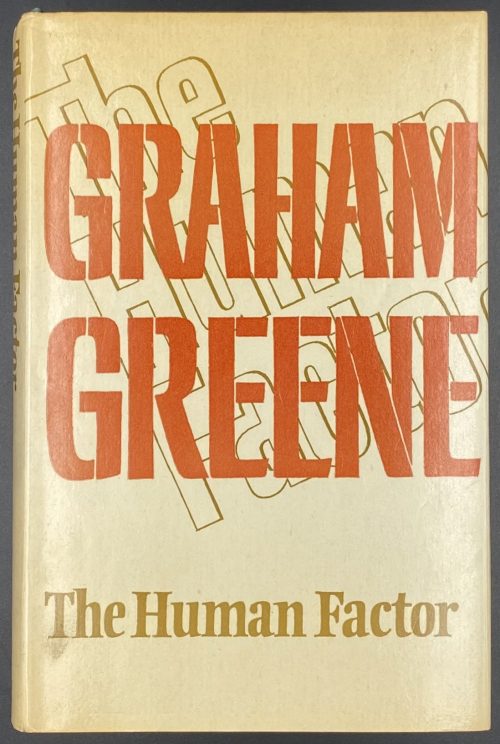 Title-page: THE HUMAN | FACTOR | Graham Greene | {citation from Joseph Conrad, 3 lines} | {publisher’s device} | THE BODLEY HEAD | LONDON SYDNEY | TORONTO || Green publisher’s cloth with gilt lettering to spine, cream dust jacket, lettered on front, back and spine, designed by Michael Harvey, unclipped (£4.50 NET | IN U.K. ONLY), [1-8] 9-338 [339] [340 blank]. Previous owners' inscriptions to FFEP. Printed by William Clowes & Sons Ltd. (Beccles). © Graham Greene 1978. Graham Greene (British, 1904 – 1991).
Title-page: THE HUMAN | FACTOR | Graham Greene | {citation from Joseph Conrad, 3 lines} | {publisher’s device} | THE BODLEY HEAD | LONDON SYDNEY | TORONTO || Green publisher’s cloth with gilt lettering to spine, cream dust jacket, lettered on front, back and spine, designed by Michael Harvey, unclipped (£4.50 NET | IN U.K. ONLY), [1-8] 9-338 [339] [340 blank]. Previous owners' inscriptions to FFEP. Printed by William Clowes & Sons Ltd. (Beccles). © Graham Greene 1978. Graham Greene (British, 1904 – 1991). -
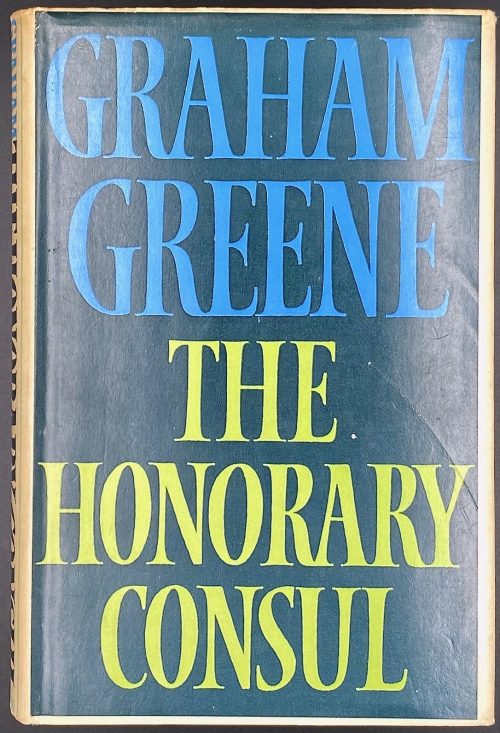 Hardcover, 20.2 x 13.6 cm, green cloth, gilt lettering to spine, in unclipped dust jacket, pp.: [1-8] 9-334 [2]. Title-page: THE HONORARY CONSUL | GRAHAM GREENE | {4 line citation} | {publisher’s device} | THE BODLEY HEAD | LONDON SYDNEY | TORONTO || © Graham Greene 1973. Printed by: William Clowes & Sons Ltd. (Beccles). Graham Greene (British, 1904 – 1991).
Hardcover, 20.2 x 13.6 cm, green cloth, gilt lettering to spine, in unclipped dust jacket, pp.: [1-8] 9-334 [2]. Title-page: THE HONORARY CONSUL | GRAHAM GREENE | {4 line citation} | {publisher’s device} | THE BODLEY HEAD | LONDON SYDNEY | TORONTO || © Graham Greene 1973. Printed by: William Clowes & Sons Ltd. (Beccles). Graham Greene (British, 1904 – 1991). -
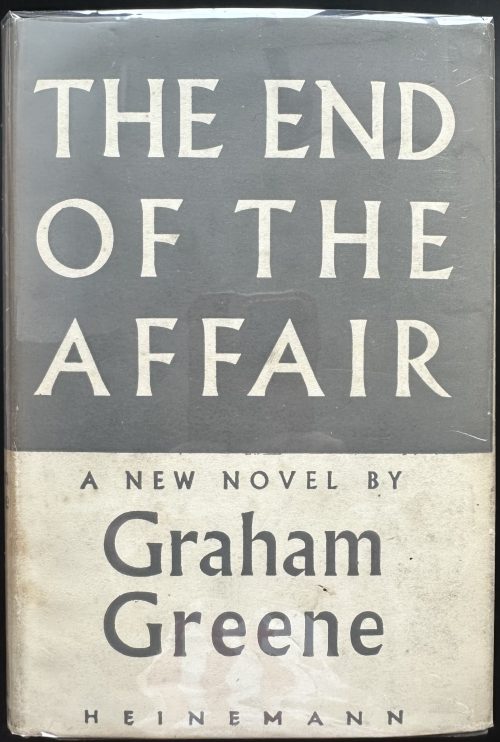 Hardcover volume, 19 x 13 cm, grey cloth with gilt lettering to spine, grey/cream dust jacket lettered throughout, price “10s 6d | NET” unclipped. Covers rubbed, dust jacket has a purple ink stain on the back bottom. Black ink inscription to recto ffl. Collation: a-o8 p10, total 122 leaves; pp.: [6] 1-237 [238]. 1st edition, 1st issue / Great Britain. Title-page: THE END OF THE | AFFAIR | by | GRAHAM GREENE | {publisher’s device} | — | WILLIAM HEINEMANN LTD | MELBOURNE :: LONDON :: TORONTO || Imprint: FIRST PUBLISHED 1951 | PRINTED IN GREAT BRITAIN | AT THE WINDMILL PRESS | KINGSWOOD, SURREY || Dedication: To C. (Catherine Walston, nee Crompton, American, 1925 – 1978) Contributors: Graham Greene (British, 1904 – 1991) William Henry Heinemann (Jewish-British, 1863 – 1920)
Hardcover volume, 19 x 13 cm, grey cloth with gilt lettering to spine, grey/cream dust jacket lettered throughout, price “10s 6d | NET” unclipped. Covers rubbed, dust jacket has a purple ink stain on the back bottom. Black ink inscription to recto ffl. Collation: a-o8 p10, total 122 leaves; pp.: [6] 1-237 [238]. 1st edition, 1st issue / Great Britain. Title-page: THE END OF THE | AFFAIR | by | GRAHAM GREENE | {publisher’s device} | — | WILLIAM HEINEMANN LTD | MELBOURNE :: LONDON :: TORONTO || Imprint: FIRST PUBLISHED 1951 | PRINTED IN GREAT BRITAIN | AT THE WINDMILL PRESS | KINGSWOOD, SURREY || Dedication: To C. (Catherine Walston, nee Crompton, American, 1925 – 1978) Contributors: Graham Greene (British, 1904 – 1991) William Henry Heinemann (Jewish-British, 1863 – 1920) -
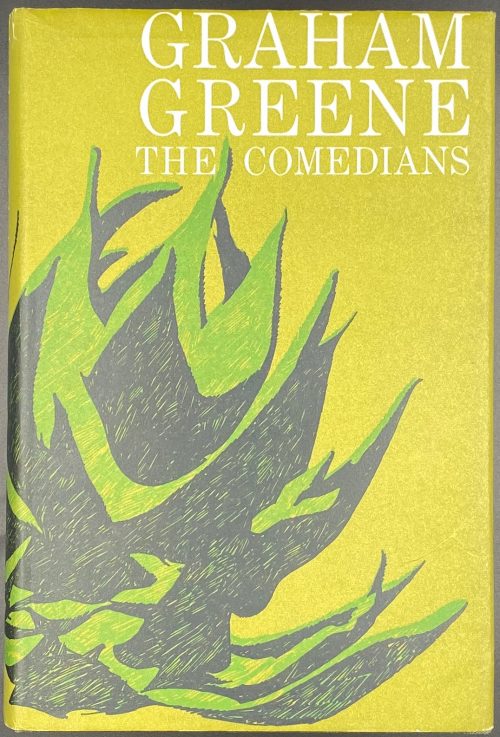 DJ: Graham Greene | THE COMEDIANS || Title page: THE COMEDIANS | Graham Greene | {four lines citation from Thomas Hardy} | {publisher’s device} | THE BODLEY HEAD| LONDON || Edition: 1st edition, 1st printing. Binding: bound in green cloth, 20.5 x 13.5 cm, with gilt lettering to spine, in green pictorial dust jacket with white lettering, price clipped; gift autograph to fep: “To. | Richard | From: gig | Xmas 1964.” (sic., the book was published in 1966!) Pagination: [1-4] 5-313 [314 blank] [6] blanks (total 320 pages). Collation: 16mo; [A]4 B-K16 L12 (total 160 leaves).
DJ: Graham Greene | THE COMEDIANS || Title page: THE COMEDIANS | Graham Greene | {four lines citation from Thomas Hardy} | {publisher’s device} | THE BODLEY HEAD| LONDON || Edition: 1st edition, 1st printing. Binding: bound in green cloth, 20.5 x 13.5 cm, with gilt lettering to spine, in green pictorial dust jacket with white lettering, price clipped; gift autograph to fep: “To. | Richard | From: gig | Xmas 1964.” (sic., the book was published in 1966!) Pagination: [1-4] 5-313 [314 blank] [6] blanks (total 320 pages). Collation: 16mo; [A]4 B-K16 L12 (total 160 leaves). -
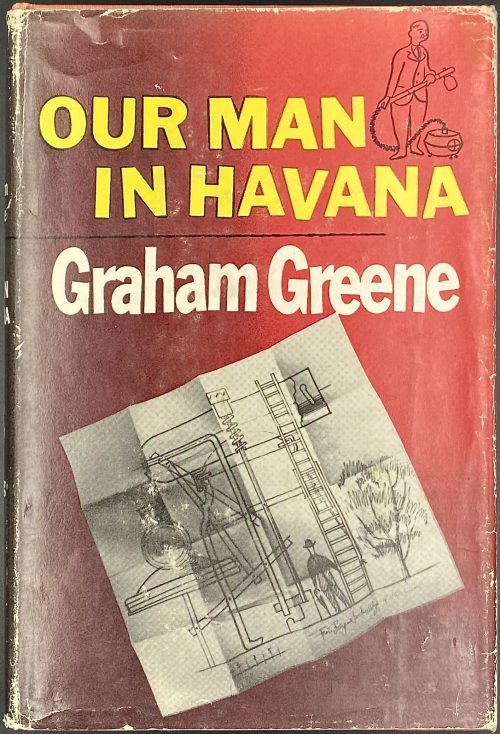 Title page: GRAHAM GREENE | {double rule} | Our Man | in Havana | AN ENTERTAINMENT | {citation: “And the sad man is cock of all his jests.” | — GEORGE HERBERT } | 1958 | THE VIKING PRESS • NEW YORK || Title verso: (top) COPYRIGHT © BY WILLIAM HEINEMANN LIMITED | PUBLISHED IN 1958 BY THE VIKING PRESS, INC. | 625 MADISON AVENUE, NEW YORK 22, N. Y. | (bottom) {publisher’s device} | LIBRARY OF CONGRESS CATALOGUE CARD NUMBER: 58.11735 | PRINTED IN THE U. S. A. BY | AMERICAN BOOK – STRATFORD PRESS || Pagination: [6] [1, 2] 3-273 [274]. Binding: 21 x 14 cm, publisher’s pink cloth, black lettering to spine: {double rule} | GRAHAM GREENE | Our | Man | in | Havana | VIKING | {double rule} ||; black vignette to front cover in the lower-right corner; original pictorial dust jacket designed by Bill English, unclipped, $3.50 in the upper-right corner of the front flap, advertisement “Also by Graham Greene” on the back flap. Edition: 1st American edition. Contributors: Henry Graham Greene (British, 1904 – 1991) – author. Bill English (British, b. 1931) – artist. The Viking Press, NY (1925 – 1975) – publisher. American Book-Stratford Press, Inc. – printer.
Title page: GRAHAM GREENE | {double rule} | Our Man | in Havana | AN ENTERTAINMENT | {citation: “And the sad man is cock of all his jests.” | — GEORGE HERBERT } | 1958 | THE VIKING PRESS • NEW YORK || Title verso: (top) COPYRIGHT © BY WILLIAM HEINEMANN LIMITED | PUBLISHED IN 1958 BY THE VIKING PRESS, INC. | 625 MADISON AVENUE, NEW YORK 22, N. Y. | (bottom) {publisher’s device} | LIBRARY OF CONGRESS CATALOGUE CARD NUMBER: 58.11735 | PRINTED IN THE U. S. A. BY | AMERICAN BOOK – STRATFORD PRESS || Pagination: [6] [1, 2] 3-273 [274]. Binding: 21 x 14 cm, publisher’s pink cloth, black lettering to spine: {double rule} | GRAHAM GREENE | Our | Man | in | Havana | VIKING | {double rule} ||; black vignette to front cover in the lower-right corner; original pictorial dust jacket designed by Bill English, unclipped, $3.50 in the upper-right corner of the front flap, advertisement “Also by Graham Greene” on the back flap. Edition: 1st American edition. Contributors: Henry Graham Greene (British, 1904 – 1991) – author. Bill English (British, b. 1931) – artist. The Viking Press, NY (1925 – 1975) – publisher. American Book-Stratford Press, Inc. – printer. -
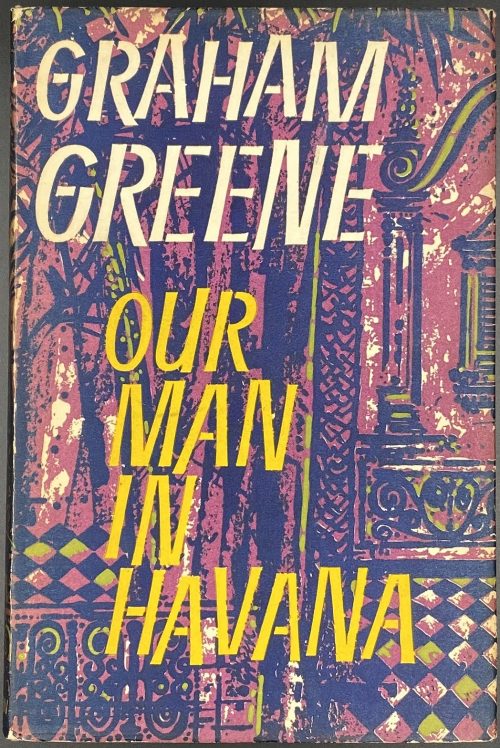 Title page: GRAHAM GREENE | {double rule} | Our Man in Havana | AN ENTERTAINMENT | {publisher’s device: windmill among the hills, letters W and H} | HEINEMANN | LONDON MELBOURNE TORONTO || Title verso: William Heinemann Ltd | LONDON MELBOURNE TORONTO | CAPE TOWN AUCKLAND | THE HAGUE | First published 1958 | © by William Heinemann Limited 1958 | All rights reserved | Printed in Great Britain | at The Windmill Press | Kingswood, Surrey || Pagination: [6] [1, 2] 3-273 [274]. Binding: 20.2 x 13.5 cm, publisher’s blue cloth, gilt lettering to spine (top): OUR | MAN | IN | HAVANA | {double rule} | GRAHAM GREENE | (bottom): HEINEMANN ||; blind-stamped publisher’s device to back cover in the lower-right corner without lettering; pp. 1-122 and 253-274 darker, than the middle pages; original dust jacket designed by Donald Green, unclipped, 15s NET in the lower-right corner of the front flap, advertisement of The quiet American on the back. Edition: 1st edition, 1st printing. Contributors: Graham Greene (British, 1904 – 1991) – author. Donald Green (British, 1919 – 1983) – DJ artist. William Henry Heinemann (British-Jewish, 1863 – 1920); William Heinemann Limited – publisher. The Windmill Press (Kingswood, Surrey) – printer.
Title page: GRAHAM GREENE | {double rule} | Our Man in Havana | AN ENTERTAINMENT | {publisher’s device: windmill among the hills, letters W and H} | HEINEMANN | LONDON MELBOURNE TORONTO || Title verso: William Heinemann Ltd | LONDON MELBOURNE TORONTO | CAPE TOWN AUCKLAND | THE HAGUE | First published 1958 | © by William Heinemann Limited 1958 | All rights reserved | Printed in Great Britain | at The Windmill Press | Kingswood, Surrey || Pagination: [6] [1, 2] 3-273 [274]. Binding: 20.2 x 13.5 cm, publisher’s blue cloth, gilt lettering to spine (top): OUR | MAN | IN | HAVANA | {double rule} | GRAHAM GREENE | (bottom): HEINEMANN ||; blind-stamped publisher’s device to back cover in the lower-right corner without lettering; pp. 1-122 and 253-274 darker, than the middle pages; original dust jacket designed by Donald Green, unclipped, 15s NET in the lower-right corner of the front flap, advertisement of The quiet American on the back. Edition: 1st edition, 1st printing. Contributors: Graham Greene (British, 1904 – 1991) – author. Donald Green (British, 1919 – 1983) – DJ artist. William Henry Heinemann (British-Jewish, 1863 – 1920); William Heinemann Limited – publisher. The Windmill Press (Kingswood, Surrey) – printer. -
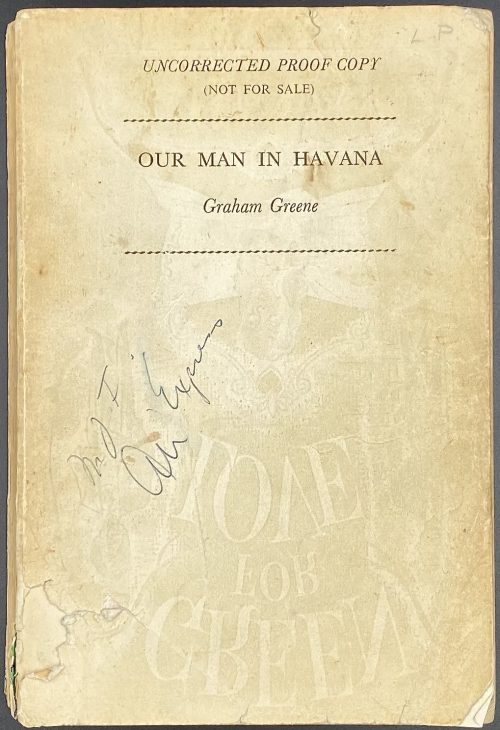 Front cover: UNCORRECTED PROOF COPY | (NOT FOR SALE) | {rule} | OUR MAN IN HAVANA | Graham Greene | {rule} || Half-title: Our Man in Havana ||; stamp on top: LAURENCE POLLINGER LTD. | 18 MADDOX STREET, LONDON, W.1. Title page: {double rule} | Our Man in Havana | AN ENTERTAINMENT | GRAHAM GREENE | {Heinemann’s device} | HEINEMANN | LONDON MELBOURNE TORONTO || Title verso: William Heinemann Ltd | LONDON MELBOURNE TORONTO | CAPE TOWN AUCKLAND | THE HAGUE | First published 1958 | © by Graham Greene 1958 | All rights reserved | Printed in Great Britain | at The Windmill Press | Kingswood, Surrey || Pagination: [6] [1, 2] 3-273 [274]. Binding: 19.5 x 13 cm, cream wrappers with black lettering to front and spine; Cover is verso of the cover for Anne Piper’s Green for Love, a book published by Fletcher & Son in 1954. Edition: Advance copy / Uncorrected proof. Contributors: Henry Graham Greene (British, 1904 – 1991) – author. William Henry Heinemann (British-Jewish, 1863 – 1920); William Heinemann Limited – publisher. Laurence Pollinger Ltd. (London) – literary agent.
Front cover: UNCORRECTED PROOF COPY | (NOT FOR SALE) | {rule} | OUR MAN IN HAVANA | Graham Greene | {rule} || Half-title: Our Man in Havana ||; stamp on top: LAURENCE POLLINGER LTD. | 18 MADDOX STREET, LONDON, W.1. Title page: {double rule} | Our Man in Havana | AN ENTERTAINMENT | GRAHAM GREENE | {Heinemann’s device} | HEINEMANN | LONDON MELBOURNE TORONTO || Title verso: William Heinemann Ltd | LONDON MELBOURNE TORONTO | CAPE TOWN AUCKLAND | THE HAGUE | First published 1958 | © by Graham Greene 1958 | All rights reserved | Printed in Great Britain | at The Windmill Press | Kingswood, Surrey || Pagination: [6] [1, 2] 3-273 [274]. Binding: 19.5 x 13 cm, cream wrappers with black lettering to front and spine; Cover is verso of the cover for Anne Piper’s Green for Love, a book published by Fletcher & Son in 1954. Edition: Advance copy / Uncorrected proof. Contributors: Henry Graham Greene (British, 1904 – 1991) – author. William Henry Heinemann (British-Jewish, 1863 – 1920); William Heinemann Limited – publisher. Laurence Pollinger Ltd. (London) – literary agent. -
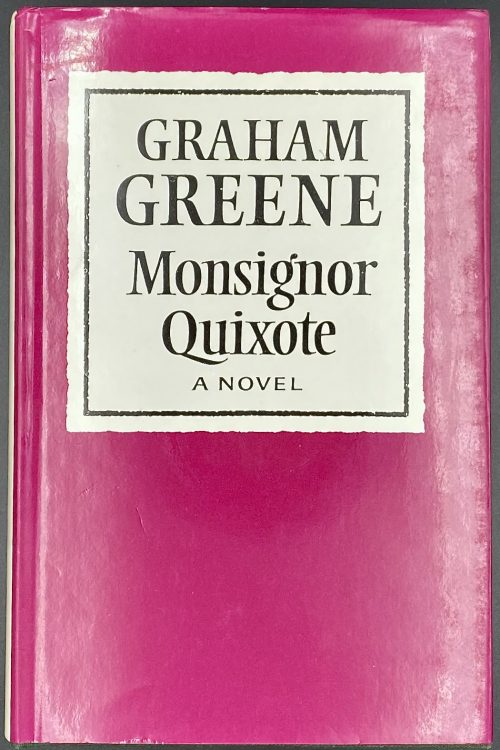 Title-page: Graham Greene | Monsignor Quixote | {citation from Shakespeare, 3 lines} | {publisher’s device} | THE BODLEY HEAD | LONDON SYDNEY || Green publisher’s cloth with silver lettering to spine, purple glossy dust jacket, lettered on front, back and spine, designed by Michael Harvey, unclipped (£9.95 NET | IN U.K. ONLY), [1-10] 11-220 [221 text /2 blank] + 1 blank leaf. © Graham Greene 1982. Printed by: William Clowes Ltd. (Beccles) Graham Greene (British, 1904 – 1991).
Title-page: Graham Greene | Monsignor Quixote | {citation from Shakespeare, 3 lines} | {publisher’s device} | THE BODLEY HEAD | LONDON SYDNEY || Green publisher’s cloth with silver lettering to spine, purple glossy dust jacket, lettered on front, back and spine, designed by Michael Harvey, unclipped (£9.95 NET | IN U.K. ONLY), [1-10] 11-220 [221 text /2 blank] + 1 blank leaf. © Graham Greene 1982. Printed by: William Clowes Ltd. (Beccles) Graham Greene (British, 1904 – 1991). -
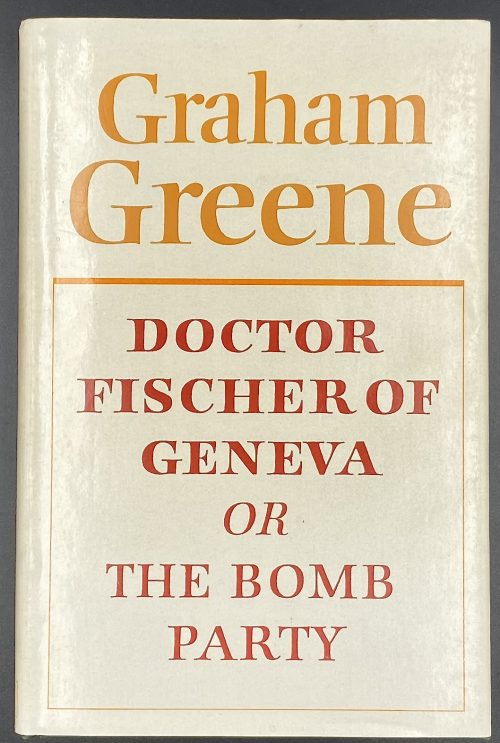 Title-page: GRAHAM GREENE | DOCTOR FISCHER | OF GENEVA | or | THE BOMB | PARTY | {publisher’s device} | THE BODLEY HEAD | LONDON SYDNEY | TORONTO || Green publisher’s cloth with gilt lettering to spine, cream dust jacket, lettered on front, back and spine, unclipped (£4.50 NET | IN U.K. ONLY), [1-8] 9-139 [140] + 2 blank leaves. Printed by Clowes Ltd. (Beccles). © Graham Greene 1980. Dust jacket design by Michael Harvey. Graham Greene (British, 1904 – 1991).
Title-page: GRAHAM GREENE | DOCTOR FISCHER | OF GENEVA | or | THE BOMB | PARTY | {publisher’s device} | THE BODLEY HEAD | LONDON SYDNEY | TORONTO || Green publisher’s cloth with gilt lettering to spine, cream dust jacket, lettered on front, back and spine, unclipped (£4.50 NET | IN U.K. ONLY), [1-8] 9-139 [140] + 2 blank leaves. Printed by Clowes Ltd. (Beccles). © Graham Greene 1980. Dust jacket design by Michael Harvey. Graham Greene (British, 1904 – 1991). -
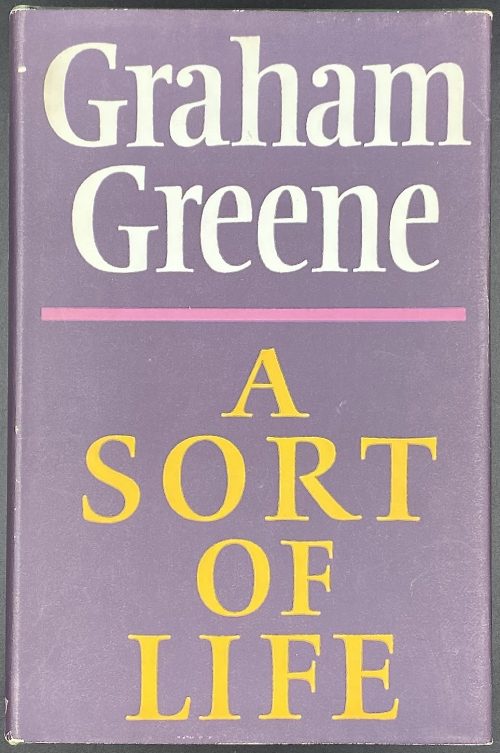 Title-page: A SORT OF LIFE | — | Graham Greene | — | {publisher’s device} | THE BODLEY HEAD | LONDON SYDNEY | TORONTO || Green publisher’s cloth with silver lettering to spine, aubergine dust jacket, lettered on front and spine, designed by Michael Harvey, unclipped (£1.80 NET | IN U.K. ONLY), [1-8] 9-215 [216] + 2 blank leaves. © Graham Greene 1971. Printed by: William Clowes & Sons Ltd. (Beccles). Graham Greene (British, 1904 – 1991).
Title-page: A SORT OF LIFE | — | Graham Greene | — | {publisher’s device} | THE BODLEY HEAD | LONDON SYDNEY | TORONTO || Green publisher’s cloth with silver lettering to spine, aubergine dust jacket, lettered on front and spine, designed by Michael Harvey, unclipped (£1.80 NET | IN U.K. ONLY), [1-8] 9-215 [216] + 2 blank leaves. © Graham Greene 1971. Printed by: William Clowes & Sons Ltd. (Beccles). Graham Greene (British, 1904 – 1991). -
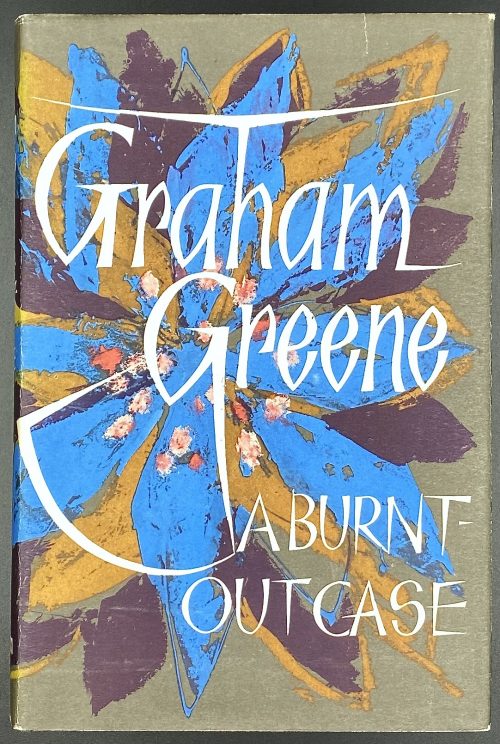 Title-page: GRAHAM GREENE | — | A Burnt Out Case | {publisher's device} | HEINEMANN | LONDON MELBURNE TORONTO || Black buckram with silver lettering to spine, green pictorial dust jacket, unclipped (16s | NET), [2] h.t. / books by GG, [2] t.p. / copyright, [2] quotations / blank, [2] dedication to Doctor Michel Lechat; [1, 2] d.t.p. Part I / blank, 3-256. Total 264 pages. Publisher: William Heinemann Ltd. Printer: Windmill Press Ltd., Kingswood, Surrey. Copyright: © Graham Greene 1960, 1961. Wrapper design: Lacey Everett. Graham Greene (British, 1904 – 1991) William Henry Heinemann (Jewish-British, 1863 – 1920) Michel Lechat (Belgian, 1927 – 2014)
Title-page: GRAHAM GREENE | — | A Burnt Out Case | {publisher's device} | HEINEMANN | LONDON MELBURNE TORONTO || Black buckram with silver lettering to spine, green pictorial dust jacket, unclipped (16s | NET), [2] h.t. / books by GG, [2] t.p. / copyright, [2] quotations / blank, [2] dedication to Doctor Michel Lechat; [1, 2] d.t.p. Part I / blank, 3-256. Total 264 pages. Publisher: William Heinemann Ltd. Printer: Windmill Press Ltd., Kingswood, Surrey. Copyright: © Graham Greene 1960, 1961. Wrapper design: Lacey Everett. Graham Greene (British, 1904 – 1991) William Henry Heinemann (Jewish-British, 1863 – 1920) Michel Lechat (Belgian, 1927 – 2014) -
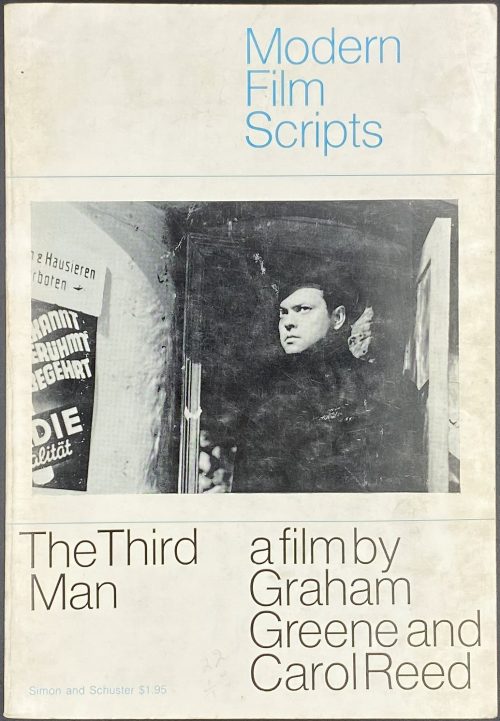 Title page: MODERN | FILM | SCRIPTS | THE THIRD MAN | a film by | Graham Greene | and Carol Reed | Simon and Schuster, New York. Pagination: [1-4] 5-134 [2] blank. Binding: publisher’s pictorial wrappers with the film still and lettering in blue and black to front, back, and spine. Size: 20.2 x 14 cm. The Third Man is a 1949 British film directed by Carol Reed, written by Graham Greene and starring Joseph Cotten, Alida Valli, Orson Welles, and Trevor Howard. Contributors: Graham Greene (British, 1904 – 1991) – author. Carol Reed (British, 1906 – 1976) – film director. Simon & Schuster (NY) – publisher. Villiers Publications, Ltd. (London) – printer.
Title page: MODERN | FILM | SCRIPTS | THE THIRD MAN | a film by | Graham Greene | and Carol Reed | Simon and Schuster, New York. Pagination: [1-4] 5-134 [2] blank. Binding: publisher’s pictorial wrappers with the film still and lettering in blue and black to front, back, and spine. Size: 20.2 x 14 cm. The Third Man is a 1949 British film directed by Carol Reed, written by Graham Greene and starring Joseph Cotten, Alida Valli, Orson Welles, and Trevor Howard. Contributors: Graham Greene (British, 1904 – 1991) – author. Carol Reed (British, 1906 – 1976) – film director. Simon & Schuster (NY) – publisher. Villiers Publications, Ltd. (London) – printer. -
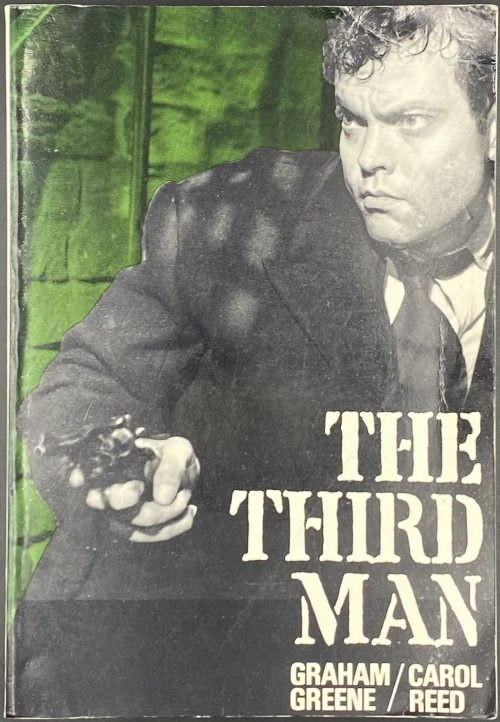 Title page: Title page: MODERN | FILM | SCRIPTS | THE THIRD MAN | a film by | Graham Greene | and Carol Reed | Lorrimer, London. Pagination: [1-4] 5-134 [2] blank; pasted into the last page: The film The Third Man is owned and distributed by British | Lion Films Ltd. Binding: publisher’s pictorial wrappers with the film still and lettering in white to front, and in black to back, and spine. Size: 20.2 x 14 cm. The Third Man is a 1949 British film directed by Carol Reed, written by Graham Greene and starring Joseph Cotten, Alida Valli, Orson Welles, and Trevor Howard. Contributors: Graham Greene (British, 1904 – 1991) – author. Carol Reed (British, 1906 – 1976) – film director. Lorrimer Publishing Limited (London) – publisher. Villiers Publications, Ltd. (London) – printer.
Title page: Title page: MODERN | FILM | SCRIPTS | THE THIRD MAN | a film by | Graham Greene | and Carol Reed | Lorrimer, London. Pagination: [1-4] 5-134 [2] blank; pasted into the last page: The film The Third Man is owned and distributed by British | Lion Films Ltd. Binding: publisher’s pictorial wrappers with the film still and lettering in white to front, and in black to back, and spine. Size: 20.2 x 14 cm. The Third Man is a 1949 British film directed by Carol Reed, written by Graham Greene and starring Joseph Cotten, Alida Valli, Orson Welles, and Trevor Howard. Contributors: Graham Greene (British, 1904 – 1991) – author. Carol Reed (British, 1906 – 1976) – film director. Lorrimer Publishing Limited (London) – publisher. Villiers Publications, Ltd. (London) – printer. -
![Gordon N. Ray. The Art of the French Illustrated Book 1700 to 1914 (2 vol. set). — NY, London: The Pierpont Morgan Library; Cornell University Press, 1982. — pp.: vol.1: [8] ix-xxxii, [2] 3-245 [3]; vol.2: [8] 247-557 [5], illustr.](https://varshavskycollection.com/wp-content/uploads/2021/02/LIB-2424.2020-500x2190.jpeg) Title page: The Art of the | French Illustrated Book | 1700 to 1914 | VOLUME I (II) | Gordon N. Ray | The Pierpont Morgan Library | Cornell University Press || Pagination: vol.1: [8] ix-xxxii, [2] 3-245 [3], illustr.; vol.2: [8] 247-557 [5], illustr. Both volumes paginater through out. Binding: 30.5 x 23.5 cm, two volumes uniformly bound in red cloth, gilt vignette to front cover, gilt lettering to spine; bookplate to front pastedown, ex-lib (Sweet Briar College Library) Contributors: Ray, Gordon Norton (American, 1915 – 1986) – author. Lange, Thomas V. – formal bibliographical description. Passela, Charles V. – photography. The Pierpont Morgan Library – Copyright © 1982
Title page: The Art of the | French Illustrated Book | 1700 to 1914 | VOLUME I (II) | Gordon N. Ray | The Pierpont Morgan Library | Cornell University Press || Pagination: vol.1: [8] ix-xxxii, [2] 3-245 [3], illustr.; vol.2: [8] 247-557 [5], illustr. Both volumes paginater through out. Binding: 30.5 x 23.5 cm, two volumes uniformly bound in red cloth, gilt vignette to front cover, gilt lettering to spine; bookplate to front pastedown, ex-lib (Sweet Briar College Library) Contributors: Ray, Gordon Norton (American, 1915 – 1986) – author. Lange, Thomas V. – formal bibliographical description. Passela, Charles V. – photography. The Pierpont Morgan Library – Copyright © 1982 -
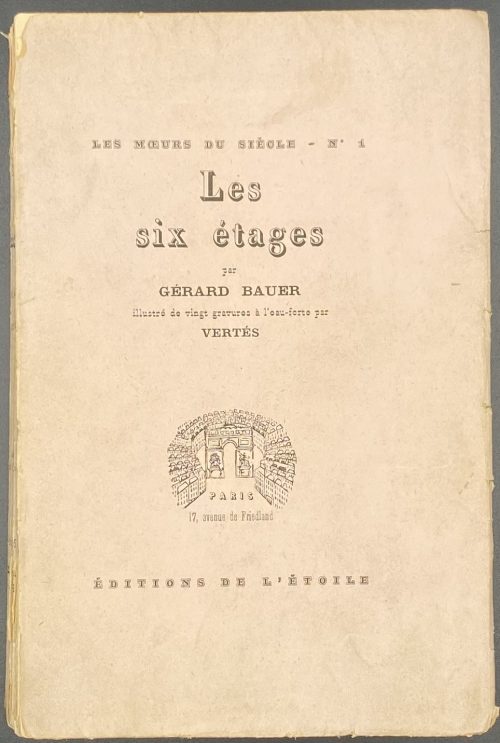 Front wrapper: LES MŒURS DU SIECLE - № 1 | Les | six étages | par | GERARD BAUER | illustré de vingt gravures à l’eau-forte | par VERTÈS | {publisher’s device, “PARIS | 17, avenue de Friedland”} | ÉDITIONS DE L’ÉTOILE || Title-page: essais pour servir a1 l’histoire contemporaine | de la galanterie et du plaisir | I | Les six étages | par | GERARD BAUER | illustré de vingt gravures à l’eau-forte | par VERTÈS | | {publisher’s device, “ÉDITIONS DE L’ÉTOILE | 17, avenue de Friedland”} | PARIS […] MCMXXV || Pagination: front wrapper with lettering, [1-8] incl. 1st bank leaf, h.t. / limitation, t.p. / blank, dedication to Abel Hermant / blank, 9-169 [170] [6] incl. table, colophon, and last blank leaf, 17 etchings by Vertès within pagination; advert. of the other books of the series to the back wrapper. Edition: 15 copies on Japon Impérial (№ 1-15), 35 on Hollande Van Gelder Zonen (№ 16-50), 400 on Vélin de Rives BFK (№ 51-450) and 3 on blue paper not for sale. This copy is № 369. Printed on November 10, 1925 by L. Petitbarat in Saint-Ouen-l’Aumône (text) and by Vernant in Paris (etchings). Edition directed by Roger Allard. Binding: 19 x 12.5 cm, French flapped pink wrappers, lettered to front, back, and spine. Contributors: Gérard Bauër (French, 1888 – 1967) – author. Marcel Vertès [Marcell Vértes] (Jewish-Hungarian-French, 1895 – 1961) – artist. Abel Hermant (French, 1862 – 1950) – dedicatee. Roger Allard (French, 1885 – 1961) – editor. L. Petitbarat (Saint-Ouen-l’Aumône) – printer. Éditions de l’Étoile (Paris) – publisher. Other names: Marcel Vertès, Marcel Vertes, Marcell Vértes
Front wrapper: LES MŒURS DU SIECLE - № 1 | Les | six étages | par | GERARD BAUER | illustré de vingt gravures à l’eau-forte | par VERTÈS | {publisher’s device, “PARIS | 17, avenue de Friedland”} | ÉDITIONS DE L’ÉTOILE || Title-page: essais pour servir a1 l’histoire contemporaine | de la galanterie et du plaisir | I | Les six étages | par | GERARD BAUER | illustré de vingt gravures à l’eau-forte | par VERTÈS | | {publisher’s device, “ÉDITIONS DE L’ÉTOILE | 17, avenue de Friedland”} | PARIS […] MCMXXV || Pagination: front wrapper with lettering, [1-8] incl. 1st bank leaf, h.t. / limitation, t.p. / blank, dedication to Abel Hermant / blank, 9-169 [170] [6] incl. table, colophon, and last blank leaf, 17 etchings by Vertès within pagination; advert. of the other books of the series to the back wrapper. Edition: 15 copies on Japon Impérial (№ 1-15), 35 on Hollande Van Gelder Zonen (№ 16-50), 400 on Vélin de Rives BFK (№ 51-450) and 3 on blue paper not for sale. This copy is № 369. Printed on November 10, 1925 by L. Petitbarat in Saint-Ouen-l’Aumône (text) and by Vernant in Paris (etchings). Edition directed by Roger Allard. Binding: 19 x 12.5 cm, French flapped pink wrappers, lettered to front, back, and spine. Contributors: Gérard Bauër (French, 1888 – 1967) – author. Marcel Vertès [Marcell Vértes] (Jewish-Hungarian-French, 1895 – 1961) – artist. Abel Hermant (French, 1862 – 1950) – dedicatee. Roger Allard (French, 1885 – 1961) – editor. L. Petitbarat (Saint-Ouen-l’Aumône) – printer. Éditions de l’Étoile (Paris) – publisher. Other names: Marcel Vertès, Marcel Vertes, Marcell Vértes -
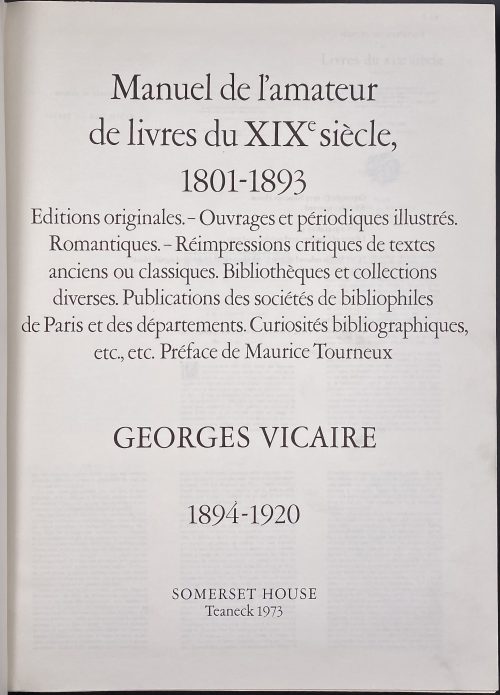 Title-page: Manuel de l'amateur | de livres du XIXe siècle, | 1801 - 1893 | Editions originales – Ouvrages et périodiques illustrés. | Romantiques – Réimpressions critiques de textes | anciens ou classiques. Bibliothèques et collections | diverses. Publications des sociétés de bibliophiles | de Paris et des départements. Curiosités bibliographiques, | etc., etc. Préface de Maurice Tourneux. | GEORGES VICAIRE | 1894-1920 | SOMERSET HOUSE | Teaneck 1973 || Photographically reduced reprint in one volume of the original edition by A. Rouquette (Paris) in 8 volumes, 9 pages to a page. Vol. 1: xix, 990; Vol. 2: 1098; Vol. 3: 1188; Vol. 4: 1362; Vol. 5: 1324; Vol. 6: 1240; Vol. 7: 1232; Vol. 8: Index of titles – 646; 4,559 original physical pages total (two numbers for one physical page). Binding: Green cloth, glit lettering to spine, 36 x 26 cm. Contributors: Georges Vicaire (French, 1853 – 1921) Maurice Tourneux (French, 1849 – 1917)
Title-page: Manuel de l'amateur | de livres du XIXe siècle, | 1801 - 1893 | Editions originales – Ouvrages et périodiques illustrés. | Romantiques – Réimpressions critiques de textes | anciens ou classiques. Bibliothèques et collections | diverses. Publications des sociétés de bibliophiles | de Paris et des départements. Curiosités bibliographiques, | etc., etc. Préface de Maurice Tourneux. | GEORGES VICAIRE | 1894-1920 | SOMERSET HOUSE | Teaneck 1973 || Photographically reduced reprint in one volume of the original edition by A. Rouquette (Paris) in 8 volumes, 9 pages to a page. Vol. 1: xix, 990; Vol. 2: 1098; Vol. 3: 1188; Vol. 4: 1362; Vol. 5: 1324; Vol. 6: 1240; Vol. 7: 1232; Vol. 8: Index of titles – 646; 4,559 original physical pages total (two numbers for one physical page). Binding: Green cloth, glit lettering to spine, 36 x 26 cm. Contributors: Georges Vicaire (French, 1853 – 1921) Maurice Tourneux (French, 1849 – 1917) -
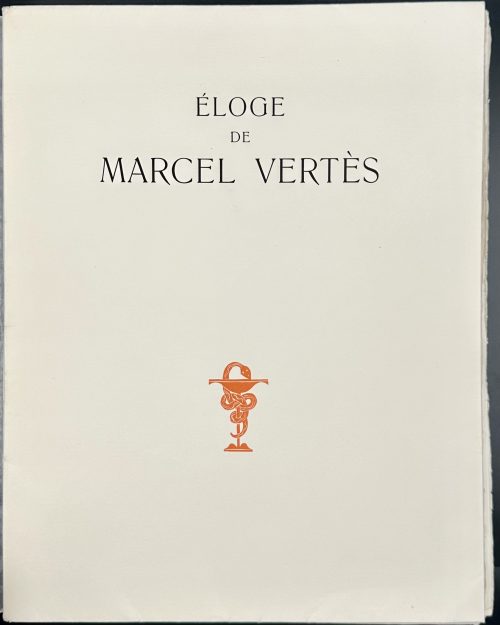 Softcover, 325 x 253 mm, publisher’s French flapped wrappers in glassine dust cover, 15 leaves folio folded in half, making 30 in-2o leaves 321 x 250 mm, with two leaves within the wrappers, [1] t.p., [2] Vertès’ blue ink inscription “À Alexaner Sternberg frère Nicolas qui est un garçon charmant et un bon artiste. Vertès.” and drawing, [3] frontispiece, [4-26] text with six full-page, one head- and one tailpiece in dry point technique, with guard tissues, [27] list of plates, [28] colophon, [29] blank; some page numbers manually scripted in pencil to the bottom right corners by a previous owner. Paper watermarked “BFK Rives”. Title-page (in orange and black): ÉLOGE | DE | MARCEL VERTÈS | PAR | GEORGES HUISMAN | ORNÉ | DE GRAVURES ORIGINALES | {publisher’s device} | MANUEL BRUKER ÉDITEUR || Colophon: CET OUVRAGE A ÉTÉ ACHEVÉ D'IMPRIMER SUR LES PRESSES DE L'IMPRIMERIE DARAGNÈS LE 30 OCTOBRE 1951 A 200 EXEMPLAIRES NUMÉROTÉS DONT 20 SUR VÉLIN 'ARCHES DE 1 A 20 AUXQUELS IL A ÉTÉ JOINT UNE SUITE DES GRAVURES SUR JAPON NACRÉ ET 180 SUR VÉLIN BLANC DE RIVES DE 21 A 200. ON A TIRÉ EN OUTRE 20 SUITES SUR MALACCA DES PLANCHES REFUSÉES. EXEMPLAIRE N° 93. Limitation: 200 copies printed on October 30, 1951, at Daragnès press: 20 (№№ 1-20) on Arches vellum paper with a suite of plates on Japon Nacré and 180 (№№ 21-200) Vélin Blanc by Rives. This is copy № 93. Tipped in: (1) photo of Vertès (and one more) in front of his murals, with the blue ballpoint pen inscription “À Alex Sternberg, frère de Nicola, excellent ami, excellent artiste et voyez, quel photographe!!! Vertès”; (2) postcard with a signed invitation to Vertès' exhibition by Librairie M.-P. Tremois: “Carte Postale | Paris, le 2 mars [19]28 | Monsieur, | Du 6 au 24 mars, | de 2 heures à 6h30, aura | lieu à la Librairie M.-P. Trémois | 43 avenue Rapp, 7e, une | exposition de dessins et | aquarelles de Vertès, ayant | servi à l’illustration de livres. | Nous espérons que vous | voudrez bien nous honorer | de votre visite. M.-P. Trémois.” The drypoint technique is confirmed by the presence of a white line in the middle of the black printed line on the micro photo:
Softcover, 325 x 253 mm, publisher’s French flapped wrappers in glassine dust cover, 15 leaves folio folded in half, making 30 in-2o leaves 321 x 250 mm, with two leaves within the wrappers, [1] t.p., [2] Vertès’ blue ink inscription “À Alexaner Sternberg frère Nicolas qui est un garçon charmant et un bon artiste. Vertès.” and drawing, [3] frontispiece, [4-26] text with six full-page, one head- and one tailpiece in dry point technique, with guard tissues, [27] list of plates, [28] colophon, [29] blank; some page numbers manually scripted in pencil to the bottom right corners by a previous owner. Paper watermarked “BFK Rives”. Title-page (in orange and black): ÉLOGE | DE | MARCEL VERTÈS | PAR | GEORGES HUISMAN | ORNÉ | DE GRAVURES ORIGINALES | {publisher’s device} | MANUEL BRUKER ÉDITEUR || Colophon: CET OUVRAGE A ÉTÉ ACHEVÉ D'IMPRIMER SUR LES PRESSES DE L'IMPRIMERIE DARAGNÈS LE 30 OCTOBRE 1951 A 200 EXEMPLAIRES NUMÉROTÉS DONT 20 SUR VÉLIN 'ARCHES DE 1 A 20 AUXQUELS IL A ÉTÉ JOINT UNE SUITE DES GRAVURES SUR JAPON NACRÉ ET 180 SUR VÉLIN BLANC DE RIVES DE 21 A 200. ON A TIRÉ EN OUTRE 20 SUITES SUR MALACCA DES PLANCHES REFUSÉES. EXEMPLAIRE N° 93. Limitation: 200 copies printed on October 30, 1951, at Daragnès press: 20 (№№ 1-20) on Arches vellum paper with a suite of plates on Japon Nacré and 180 (№№ 21-200) Vélin Blanc by Rives. This is copy № 93. Tipped in: (1) photo of Vertès (and one more) in front of his murals, with the blue ballpoint pen inscription “À Alex Sternberg, frère de Nicola, excellent ami, excellent artiste et voyez, quel photographe!!! Vertès”; (2) postcard with a signed invitation to Vertès' exhibition by Librairie M.-P. Tremois: “Carte Postale | Paris, le 2 mars [19]28 | Monsieur, | Du 6 au 24 mars, | de 2 heures à 6h30, aura | lieu à la Librairie M.-P. Trémois | 43 avenue Rapp, 7e, une | exposition de dessins et | aquarelles de Vertès, ayant | servi à l’illustration de livres. | Nous espérons que vous | voudrez bien nous honorer | de votre visite. M.-P. Trémois.” The drypoint technique is confirmed by the presence of a white line in the middle of the black printed line on the micro photo: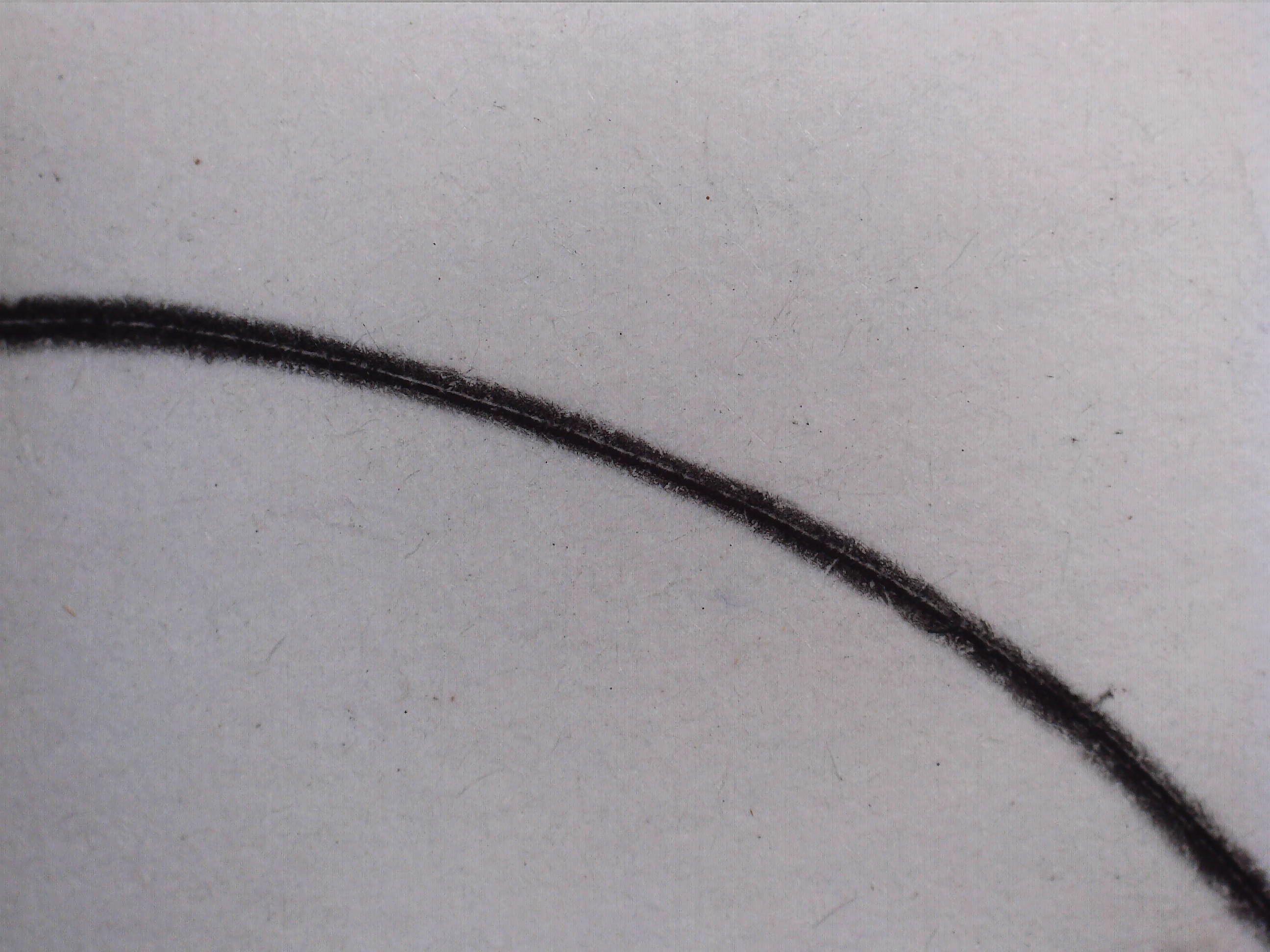 Catalogue raisonné: Vokaer № 52.
Contributors:
Georges Huisman (French, 1889 – 1957) – author.
Marcel Vertès [Marcell Vértes] (Jewish-Hungarian-French, 1895 – 1961) – character/artist.
Manuel Bruker (French, 1891 – 1979) – publisher.
Jean-Gabriel Daragnès (French, 1886 – 1950) – printer.
Nicolas Sternberg (Hungarian-French, 1902 –1960)
Librairie M.-P. Trémois (1925 – 1953)
Catalogue raisonné: Vokaer № 52.
Contributors:
Georges Huisman (French, 1889 – 1957) – author.
Marcel Vertès [Marcell Vértes] (Jewish-Hungarian-French, 1895 – 1961) – character/artist.
Manuel Bruker (French, 1891 – 1979) – publisher.
Jean-Gabriel Daragnès (French, 1886 – 1950) – printer.
Nicolas Sternberg (Hungarian-French, 1902 –1960)
Librairie M.-P. Trémois (1925 – 1953) -
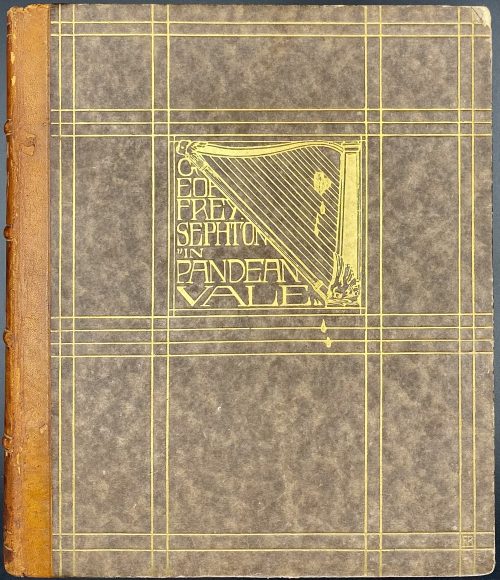 Description: one volume 25.5 x 22 cm, quarter calf with raised bands and gilt lettering over gilt-decorated boards, text within decorated borders printed on wove paper, with 8 mounted colour plates, 16 x 14 cm, photomechanical reproductions after Franz von Bayros, with lettered tissue guards, t.e.g. Title-page (in decorated border): INPANDEANVALE | PICTURED {} IN COLOUR | BY THE MAR {} QUIS F.BAYROS {vignette} | AMALTHEA PUBLISHING OFFICEZURICH || Pagination: [2 blank] [1-6] 7-156 [2 blank], total 80 leaves, incl. 8 colour plates with lettered tissue guards. Limitation: Copyright by Amalthea Publishing Office, Vienna. Printed by Adolf Holzhauzen in Vienna. Bound by Karl Scheibe, Vienna. Edition A: №№ I-V, full leather signed by von Bayros; Edition B: №№ 1-495 in half-leather. This copy is № 130, signed by the author. Contributors: Geoffrey Sephton – author, nothing is known. Franz von Bayros (Austrian, 1866 – 1924) – artist. Adolf Holzhausen the Younger (Austrian, 1868 – 1931) – printer. Karl Scheibe (Austrian) – bookbinder.
Description: one volume 25.5 x 22 cm, quarter calf with raised bands and gilt lettering over gilt-decorated boards, text within decorated borders printed on wove paper, with 8 mounted colour plates, 16 x 14 cm, photomechanical reproductions after Franz von Bayros, with lettered tissue guards, t.e.g. Title-page (in decorated border): INPANDEANVALE | PICTURED {} IN COLOUR | BY THE MAR {} QUIS F.BAYROS {vignette} | AMALTHEA PUBLISHING OFFICEZURICH || Pagination: [2 blank] [1-6] 7-156 [2 blank], total 80 leaves, incl. 8 colour plates with lettered tissue guards. Limitation: Copyright by Amalthea Publishing Office, Vienna. Printed by Adolf Holzhauzen in Vienna. Bound by Karl Scheibe, Vienna. Edition A: №№ I-V, full leather signed by von Bayros; Edition B: №№ 1-495 in half-leather. This copy is № 130, signed by the author. Contributors: Geoffrey Sephton – author, nothing is known. Franz von Bayros (Austrian, 1866 – 1924) – artist. Adolf Holzhausen the Younger (Austrian, 1868 – 1931) – printer. Karl Scheibe (Austrian) – bookbinder. -
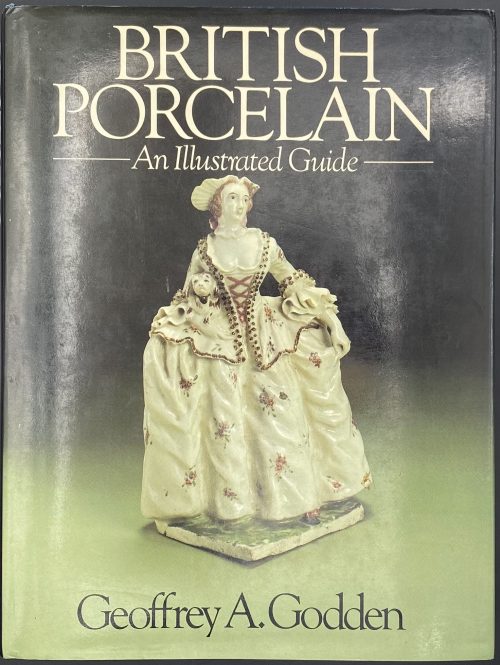 Hardcover in blue cloth with gilt lettering to spine, pictorial dust jacket, 25.5 x 19.5 cm, pp.: [1-4] 5-452, +12 colour plates; 576 b/w plates within the pagination.
Hardcover in blue cloth with gilt lettering to spine, pictorial dust jacket, 25.5 x 19.5 cm, pp.: [1-4] 5-452, +12 colour plates; 576 b/w plates within the pagination. -
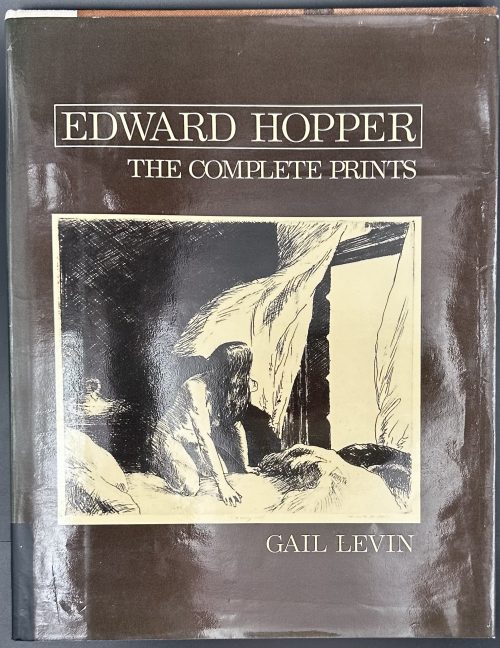 Hardcover volume, 28.6 x 22.4 cm, tan cloth over brown cloth boards, black lettering to spine, blind-stamped lettering in frame to front, in a black pictorial dust jacket, price unclipped; pp.: [1-ix] x-xi [xii blank], [1-4] 5-36 [4], 64 pages with 109 b/w plates, 12 pages with chronology, bibliography, credits; total 128 pp. Title-page: EDWARD HOPPER (in frame)| THE COMPLETE PRINTS | GAIL LEVIN | W • W • NORTON & COMPANY • NEW YORK • LONDON | IN ASSOCIATION WITH THE | WHITNEY MUSEUM OF AMERICAN ART || Contributors: Gail Levin (American, b. 1948) – author. Edward Hopper (American, 1882 – 1967) – artist. W. W. Norton & Company (f. 1923) – publisher. Whitney Museum of American Art (NY) – publisher.
Hardcover volume, 28.6 x 22.4 cm, tan cloth over brown cloth boards, black lettering to spine, blind-stamped lettering in frame to front, in a black pictorial dust jacket, price unclipped; pp.: [1-ix] x-xi [xii blank], [1-4] 5-36 [4], 64 pages with 109 b/w plates, 12 pages with chronology, bibliography, credits; total 128 pp. Title-page: EDWARD HOPPER (in frame)| THE COMPLETE PRINTS | GAIL LEVIN | W • W • NORTON & COMPANY • NEW YORK • LONDON | IN ASSOCIATION WITH THE | WHITNEY MUSEUM OF AMERICAN ART || Contributors: Gail Levin (American, b. 1948) – author. Edward Hopper (American, 1882 – 1967) – artist. W. W. Norton & Company (f. 1923) – publisher. Whitney Museum of American Art (NY) – publisher. -
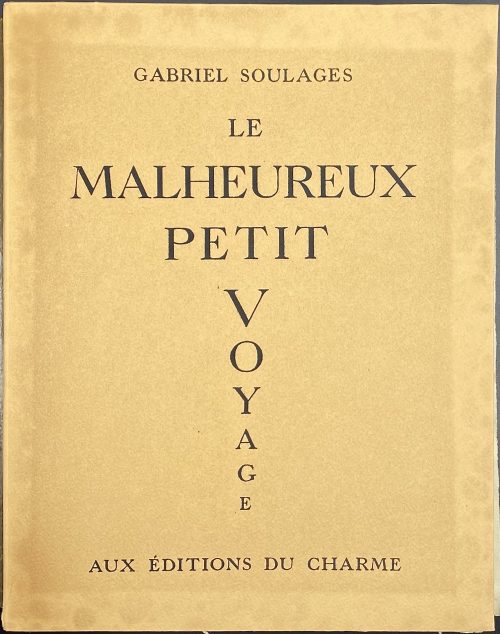 Description: Softcover 4to volume 25 x 19.7 cm in publisher’s French flapped tan wrappers, in glassine DJ, lettering to front. Printed on watermarked “Arches” laid paper, margins untrimmed, pages uncut. Illustrated with 24 in-text coloured etchings, and 59 vignettes, initials, and tailpieces engraved on wood by Gilbert Poilliot after Maurice Leroy. Front wrapper: GABRIEL SOULAGES | LE | MALHEUREUX | PETIT | VOYAGE {vertical} | AUX ÉDITIONS DU CHARME || Title-page (red and black): GABRIEL SOULAGES | LE MALHEUREUX | PETIT VOYAGE | Illustrations de MAURICE LEROY | {fleuron} | ÉDITIONS DU CHARME | PARIS – 1942 || Pagination: [1-8] (leaf in wrapper, t.p., dedication, d.t.p.) 9-187 [188] [4] (table, colophon, leaf in wrapper), total 192 pages , incl. in wrappers. Limitation: Limited to 750 copies, 25 copies (№ 1-25) on Vélin d’Arches with the original drawings and several suites of plates, 59 copies (№ 26-84) on Vélin d’Arches with the original drawings and several suites of plates, 100 copies (№ 85-184) on Vélin d’Arches with one suite of woodcuts and one of the etchings, 216 copies (№ 185-400) on Vélin d’Arches without enrichment, 350 copies (401-750) on Vélin des Papeteries Lana (Docelles); besides there are 10 copies numbered I-X for the artist and collaborators. This copy is № 266. Edition made under the direction of Sven Nielsen and Robert Meiffrédy; printed on April 29, 1942, at Dumoulin under the direction of H. Barthélemy. Etchings were printed at La Tradition under the direction of H. Durupt and the artist. Gabriel Soulages (French, 1876 – 1930?) – author. Maurice Leroy (French, 1885 – 1973) – artist. Gilbert Poilliot (French, fl. 1938 – 1952) – wood engraver. Sven Nielsen (Danish, 1901 – 1976) – publisher. Robert Meiffrédy (French, 20th century) – publisher.
Description: Softcover 4to volume 25 x 19.7 cm in publisher’s French flapped tan wrappers, in glassine DJ, lettering to front. Printed on watermarked “Arches” laid paper, margins untrimmed, pages uncut. Illustrated with 24 in-text coloured etchings, and 59 vignettes, initials, and tailpieces engraved on wood by Gilbert Poilliot after Maurice Leroy. Front wrapper: GABRIEL SOULAGES | LE | MALHEUREUX | PETIT | VOYAGE {vertical} | AUX ÉDITIONS DU CHARME || Title-page (red and black): GABRIEL SOULAGES | LE MALHEUREUX | PETIT VOYAGE | Illustrations de MAURICE LEROY | {fleuron} | ÉDITIONS DU CHARME | PARIS – 1942 || Pagination: [1-8] (leaf in wrapper, t.p., dedication, d.t.p.) 9-187 [188] [4] (table, colophon, leaf in wrapper), total 192 pages , incl. in wrappers. Limitation: Limited to 750 copies, 25 copies (№ 1-25) on Vélin d’Arches with the original drawings and several suites of plates, 59 copies (№ 26-84) on Vélin d’Arches with the original drawings and several suites of plates, 100 copies (№ 85-184) on Vélin d’Arches with one suite of woodcuts and one of the etchings, 216 copies (№ 185-400) on Vélin d’Arches without enrichment, 350 copies (401-750) on Vélin des Papeteries Lana (Docelles); besides there are 10 copies numbered I-X for the artist and collaborators. This copy is № 266. Edition made under the direction of Sven Nielsen and Robert Meiffrédy; printed on April 29, 1942, at Dumoulin under the direction of H. Barthélemy. Etchings were printed at La Tradition under the direction of H. Durupt and the artist. Gabriel Soulages (French, 1876 – 1930?) – author. Maurice Leroy (French, 1885 – 1973) – artist. Gilbert Poilliot (French, fl. 1938 – 1952) – wood engraver. Sven Nielsen (Danish, 1901 – 1976) – publisher. Robert Meiffrédy (French, 20th century) – publisher. -
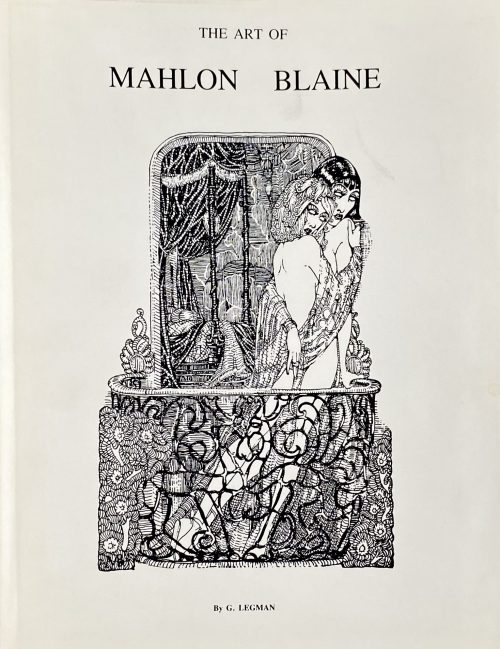 Title page: THE ART OF | MAHLON BLAINE | A Reminiscence | by G. Legman | with a Mahlon Blaine bibliography | compiled by Roland Trenary | {Blaine’s fac-simile} | Peregrine Books | 1982 || Pagination: [1-4] 5-26 + 84 pp. of illustrations, unpaginated. Collation: 13 leaves of text, 40 leaves of b/w plates, and 2 leaves of colour plates, 55 leaves total. Binding: 29 x 22.5 cm; publisher’s black cloth, silver lettering to spine, pictorial endpapers, pictorial dust jacket. Edition: Limited edition of 100 copies (this is №100), signed by Gelman, Trenary, and Arrington. Contributors: Blaine, Mahlon (American, 1894 – 1969) – illustrator. Legman, Gershon (American, 1917 – 1999) – author. Arrington, Robert L. (American, 1984 – 2015) – author, introduction. Trenary, Roland (American) – author, compiler. Peregrine Books (East Lansing, MI) – publisher.
Title page: THE ART OF | MAHLON BLAINE | A Reminiscence | by G. Legman | with a Mahlon Blaine bibliography | compiled by Roland Trenary | {Blaine’s fac-simile} | Peregrine Books | 1982 || Pagination: [1-4] 5-26 + 84 pp. of illustrations, unpaginated. Collation: 13 leaves of text, 40 leaves of b/w plates, and 2 leaves of colour plates, 55 leaves total. Binding: 29 x 22.5 cm; publisher’s black cloth, silver lettering to spine, pictorial endpapers, pictorial dust jacket. Edition: Limited edition of 100 copies (this is №100), signed by Gelman, Trenary, and Arrington. Contributors: Blaine, Mahlon (American, 1894 – 1969) – illustrator. Legman, Gershon (American, 1917 – 1999) – author. Arrington, Robert L. (American, 1984 – 2015) – author, introduction. Trenary, Roland (American) – author, compiler. Peregrine Books (East Lansing, MI) – publisher. -
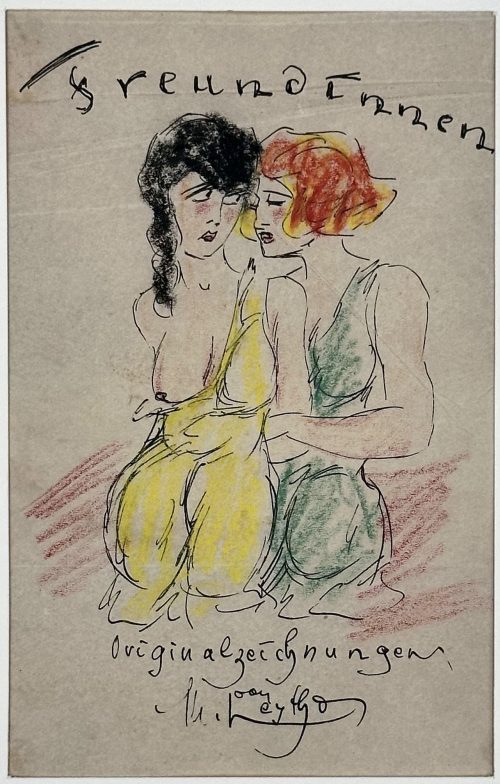 Seven pen and ink and colour crayon drawings on thin wove paper approx. 140 x 100 mm, each attached to a sheet 310 x 240 mm and mounted in a passepartout, placed in an aubergine cardboard folder 310 x 250 mm with a tan vellum spine and paper flaps inside; olive label with double border and gilt lettering to front cover "Dessins" [Drawings]. The first sheet is a title-page lettered in manuscript: Freundinnen | {vignette} | Originalzeichnungen | M. Leytho || [Girlfriends. Original drawings]. Information about the artist at www.honesterotica.com: "Mitja Leytho, almost certainly a pseudonym, is yet another mediocre yet fascinating amateur artist from the Germany of the 1920s about whom we know absolutely nothing beyond the four portfolios which bear the ‘Leytho’ signature". We shall notice that this set of drawings was produced by a talented professional, not an amateur.
Seven pen and ink and colour crayon drawings on thin wove paper approx. 140 x 100 mm, each attached to a sheet 310 x 240 mm and mounted in a passepartout, placed in an aubergine cardboard folder 310 x 250 mm with a tan vellum spine and paper flaps inside; olive label with double border and gilt lettering to front cover "Dessins" [Drawings]. The first sheet is a title-page lettered in manuscript: Freundinnen | {vignette} | Originalzeichnungen | M. Leytho || [Girlfriends. Original drawings]. Information about the artist at www.honesterotica.com: "Mitja Leytho, almost certainly a pseudonym, is yet another mediocre yet fascinating amateur artist from the Germany of the 1920s about whom we know absolutely nothing beyond the four portfolios which bear the ‘Leytho’ signature". We shall notice that this set of drawings was produced by a talented professional, not an amateur. -
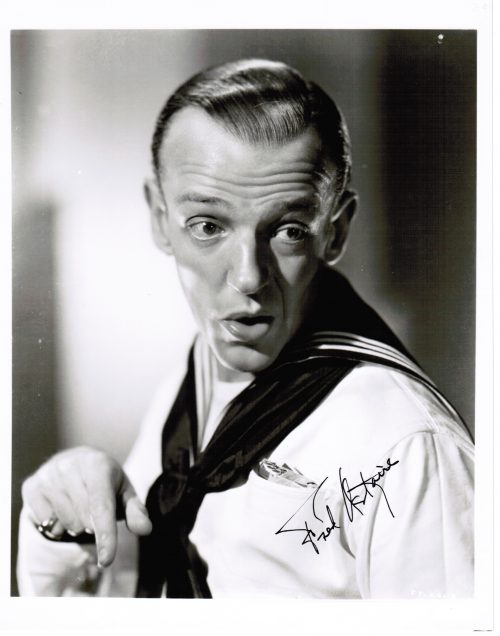 Black and white photographic half-length portrait of Fred Astaire [Frederick Austerlitz] (American, 1899 – 1987) in sailor's uniform, signed "Fred Astaire" in black ink. Probably, from "Following the Fleet", a 1936 American RKO musical comedy. Size: 26.2 x 20.6 cm sheet; 23.3. x 19.3 cm image. Certificate of authenticity from John Reznikoff, University Archives.
Black and white photographic half-length portrait of Fred Astaire [Frederick Austerlitz] (American, 1899 – 1987) in sailor's uniform, signed "Fred Astaire" in black ink. Probably, from "Following the Fleet", a 1936 American RKO musical comedy. Size: 26.2 x 20.6 cm sheet; 23.3. x 19.3 cm image. Certificate of authenticity from John Reznikoff, University Archives. -
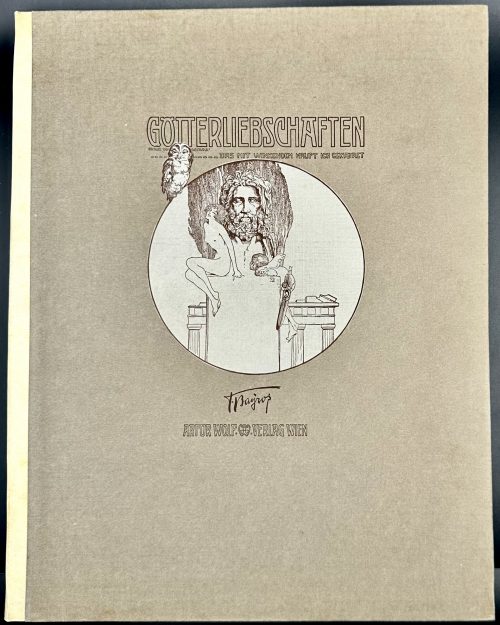 Letterpress title-page, engraved title-page, and 10 sheets of collotype plates printed on india paper mounted on thick wove paper, with captioned guard sheets, loose in a vellum-backed cardboard portfolio with cloth-mounted flaps; floral diaper design inside throughout; bookseller's label to front board verso; limited edition of 550 copies of which this is copy № 103. Dimensions: 338 x 268 mm portfolio; 325 x 260 mm sheet, 225 x 195 mm image. Front board with lettering and vignette: GÖTTERLIEBSCHAFTEN | DAS MIT WINKENDEM HAUPT ICH GEWAHRET | {vignette} | {signature} | ARTUR WOLF / VERLAG WIEN || Letterpress title-page: FRANZ VON BAYROS | “GÖTTERLIEBSCHAFTEN” | ARTUR WOLF / VERLAG WIEN | 1914 || Verso to letterpress t.p. VERZEICHNIS DER TAFELN.
Letterpress title-page, engraved title-page, and 10 sheets of collotype plates printed on india paper mounted on thick wove paper, with captioned guard sheets, loose in a vellum-backed cardboard portfolio with cloth-mounted flaps; floral diaper design inside throughout; bookseller's label to front board verso; limited edition of 550 copies of which this is copy № 103. Dimensions: 338 x 268 mm portfolio; 325 x 260 mm sheet, 225 x 195 mm image. Front board with lettering and vignette: GÖTTERLIEBSCHAFTEN | DAS MIT WINKENDEM HAUPT ICH GEWAHRET | {vignette} | {signature} | ARTUR WOLF / VERLAG WIEN || Letterpress title-page: FRANZ VON BAYROS | “GÖTTERLIEBSCHAFTEN” | ARTUR WOLF / VERLAG WIEN | 1914 || Verso to letterpress t.p. VERZEICHNIS DER TAFELN.- Europa und der Stier
- Leda und die Schildkröte
- Sterope und Herkules
- Herodikos und die Turnerinnen
- Phoroneus und die Hirtin
- Minos und Persipeia
- Phryne und Mutter
- Pytalos und Demeter
- Kirke und die Ferkel
- Putiphar
-
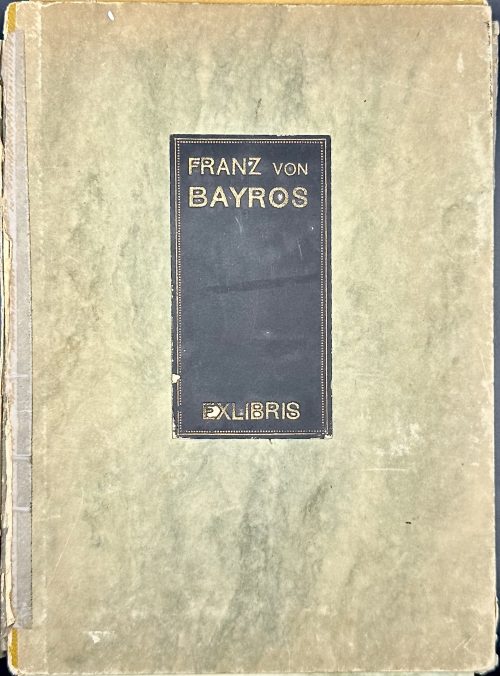 A set of 49 prints, heliogravures and etchings, tipped-in on 285 x 257 mm grey cards, in a green marbled folder with a gilt-lettered black label to the front. No publisher, no place, no year (s.l., s.n., s.d.), printed in circa 1910.
A set of 49 prints, heliogravures and etchings, tipped-in on 285 x 257 mm grey cards, in a green marbled folder with a gilt-lettered black label to the front. No publisher, no place, no year (s.l., s.n., s.d.), printed in circa 1910.- Vlastimil Blažek (Czech, 1878 – 1950): heliogravure, sheet 180 x 137 mm, plate 152 x 114 mm; laid paper, black sepia ink; unsigned.
- Ex libris Gerhard Wunderlich (architect in Dresden): heliogravure, sheet 205 x 150 mm, plate 158 x 115 mm; wove paper, brown sepia ink; inscription: heliogravure, sheet 180 x 137 mm, plate 152 x 114 mm; laid paper, sepia ink; inscription to top “Es ist alles so eng”; signed “F (backwards). Bayros”.
- Ex libris William Lipka: heliogravure, sheet 140 x 125 mm, plate 112 x 98 mm; laid paper, black sepia ink; signature hardly legible.
- Nikolaus Schindler (amateur photographer in Vienna): heliogravure, sheet 142 x 150 mm, plate 110 x 117 mm; laid paper, black sepia ink; unsigned.
- Sussy de Coiquard: heliogravure, sheet 160 x 140 mm, plate 128 x 110 mm; laid paper, black sepia ink; unsigned.
- Illegible, looks like “Vielluer Febréy”: heliogravure, sheet 120 x 109 mm, plate 93 x 85 mm; laid paper, black, sepia ink; signed “F (backwards). Bayros:”.
- Ex libris Erich Liebermann-Rosswiese (Greman-Jewish, 1886 – 1942): heliogravure, sheet 180 x 139 mm, plate 118 x 88 mm; wove paper, black sepia ink; unsigned.
- Ex libris Dr. phil. Rudolf Ludwig: before letters, heliogravure, sheet 150 x 132 mm, plate 120 x 110 mm; laid paper, black sepia ink; unsigned. See [LIB-3258.2023] John Cleland. Die Memoiren der Fanny Hill. — Paphos [i.e. Vienna]: C. W. Stern, 1906.
- Unidentified: before letters, heliogravure, sheet 150 x 115 mm, plate 113 x 88 mm; laid paper, black sepia ink; signed “F. Bayros” in the manuscript. Circumstantial evidence tells that this bookplate belongs to someone A.W.(Artur Wolf). See №22.
- Lulu. Monachia. Gest. v. Ritter Dialekt und Junker Erich: heliogravure, sheet 204 x 152 mm, plate 160 x 118 mm; wove paper, black sepia ink; unsigned. See №20.
- Kellner Jstván: (István): heliogravure, sheet 118 x 100 mm, plate 85 x 70 mm; laid paper, black sepia ink; signed “Franz Bayros” in the script (hardly legible).
- Adyton: heliogravure, sheet 170 x 130 mm, plate 113 x 85 mm; wove paper, black, sepia ink; signed “F (backwards). Bayros”.
- 13.Ex libris George Arthur Buhl (American, 1883 – 1959): heliogravure, sheet 166 x 140 mm, plate 120 x 92 mm; wove paper, black sepia ink; inscription “!I will! | !And I can!”; bust inscribed “T. Carlyle”; signed “F (backwards). Bayros” (hardly legible).
- Ex-Libris Heinrich und Lise Fuhrmann: heliogravure, sheet 165 x 149 mm, plate 120 x 103 mm; wove paper, black sepia ink; signed “F (backward). Bayros”; inscription “So schaff ich am sausenden Webstuhl der Zeit und wirke der Gottheit lebendiges Kleid” (from ‘Faust’ by Goethe).
- Ex libris Gerhard Wunderlich (architect in Dresden): heliogravure, sheet 165 x 137 mm, plate 135 x 105 mm; laid paper, black, sepia ink; signed “F (backwards). Bayros”.
- Ex Libris Walther u. Amelia Fahrenhorst; Walter Fahrenhorst (German, 1871 – 1938): heliogravure, sheet 165 x 140 mm, plate 128 x 95 mm; wove paper, black sepia ink; signed “F. Bayros” in the manuscript. The inscription behind the strings: NITOR (lat. beauty, glamour).
- Ex Libris Margot Lewknecht; heliogravure, sheet 145 x 140 mm, plate 128 x 118 mm; laid paper, black sepia ink; signed “F. Bayros”.
- Ex Libris Walther Heinisch (publisher in Carlsbad); heliogravure, sheet 185 x 145 mm, plate 140 x 110 mm; wove paper, sanguine; male bust with an inscription to the base: “Arnold Boeklin” / Arnold Böcklin (Swiss, 1827 – 1901); inscription: “mit gêru scal man geba infâhan” – a line from Hildebrandslied, the earliest poetic text in German. Unsigned.
- Bookplate with music score GGDBGC; heliogravure, sheet 125 x 135 mm, plate 100 x 110 mm, with monogram «HCJ»; laid paper, brown sepia ink; signed “F. Bayros”.
- Bookplate with inscription: Lulu aus Praga | Gest v. Ritter Dialekt / Monachia / Monachia / und Junker Erich; heliogravure, sheet 182 x 147 mm, plate 160 x 120 mm, image 122 x 105 mm; wove paper, bluish-black sepia ink; unsigned. See №10.
- Bookplate, no inscription; heliogravure, laid paper, sepia ink, sheet 148 x 127 mm, image 84 x 79 mm; signed F. Bayros in the manuscript beneath the image.
- Ex libris Artur Wolf: heliogravure, laid paper, sepia ink, sheet 170 x 150 mm, image 120 x 105 mm; signed F. Bayros in the manuscript to the frame of the image. See №9.
- Ex Libris E. K. Weigl: heliogravure, laid paper, sepia ink, sheet 139 x 121 mm, plate 112 x 97 mm; unsigned; inscription above male portrait: “LEONARDO”.
- Ex libris Dr. A. Bergmann: heliogravure, wove paper, sepia ink; sheet 180 x 140 mm, plate 130 x 105 mm; signed F. Bayros in the manuscript.
- Grete Cäcilie (monogram “PS”): heliogravure, laid paper, sepia ink, sheet 161 x 130 mm, plate 128 x 103 mm, signature illegible.
- Emma Steigleder: heliogravure, laid paper, black ink, sheet 181 x 141 mm, plate 158 x 117 mm, signed F. Bayros in the manuscript. Inscription “Si vis amari, ama! Seneca” [If you want to be loved, love] to the attic of the arch.
- Bruno Fischer: heliogravure, laid paper, sepia ink, sheet 186 x 145 mm, plate 155 x 116 mm, signed “F (backward). Bayros”. Inscription to bottom “Gehl Weck’ ihn nicht auf seien wir froh dass er einmal schläft!”
- Harnasch: heliogravure, wove paper, sepia ink; unsigned; sheet 140 x 132 mm, plate 100 x 85 mm; unsigned.
- Eduard Klampfl: heliogravure, laid paper, sepia ink, sheet 165 x 145 mm, plate 135 x 110 mm, signed “F (backwards). Bayros”; portrait bust of the composer Richard Wagner (German, 1813 –1883).
- Jorge Monsalvatje: heliogravure, wove paper, sepia ink; sheet 189 x 160 mm, plate 150 x 115 mm; signed F. Bayros in the manuscript.
- E. K. W.: wove paper, sepia ink; sheet 150 x 120 mm; signed “Bayros”.
- Unidentified bookplate: wove paper, sepia ink; sheet 150 x 120 mm; signed “F. Bayros 09” in the manuscript.
- Ex-Libris Helene and Emil Lemberger: heliogravure (or soft ground etching), laid paper, sepia ink, sheet 180 x 163 mm, plate 150 x 130 mm, signed “F. Bayros” in the manuscript.
- M. Z.: wove paper, sepia ink; sheet 130 x 170 mm, plate 90 x 120 mm; signed “F (backwards) Bayros”.
- Ex libris Frankl Frigyes Vilmos: heliogravure (or soft ground etching), laid paper, sepia ink, sheet 140 x 148 mm, unsigned. Frigyes Frankl, born in Tejfalu, Szlovákia, died in 1943.
- Ex libris Anton Bürck: heliogravure, wove paper, sepia ink; sheet 170 x 137 mm, plate 123 x 104 mm; unsigned. Anton Burck (German,1881 – 1951) of Palatinate, Bavaria.
- Aus den büchern A. W.: heliogravure, laid paper, sepia ink, sheet 152 x 136 mm, plate 120 x 105 mm, signed “F. Bayros” in the manuscript.
- Ex libris Hans Hickl: heliogravure, laid paper, sepia ink, sheet 150 x 125 mm, plate 115 x 95 mm, signed “Ω”.
- Ex libris Karl Wehle: soft ground etching, laid paper, brown sepia ink, sheet 107 x 90 mm, plate 80 x 65 mm, inscription “Gut!” in the centre; unsigned. Karl Wehle (Austrian, 1901 – 1933)
- Ex libris Dr. Paul Berger: etching, laid paper, black ink, sheet 140 x 115 mm, plate 115 x 85 mm, signed “F (backwards). Bayros”.
- Unidentified bookplate: etching, laid paper, black ink, sheet 145 x 115 mm, plate 85 x 70 mm, unsigned.
- Ex Bibliotheca Erotica Carl Georg von Maassen: soft ground etching, india paper, black ink, sheet 76 x 78 mm, signed “FB”.
- Ex Bibliotheca Erotica Carl Georg von Maassen: soft ground etching, india paper, black ink, sheet 79 x 79 mm, signed “F. von Bayros”.
- Paul Mixa: soft ground etching, laid paper, sanguine ink, sheet 122 x 111 mm, plate 90 x 85 mm, inscription: “Gerne hör’ich wenn du singest und ich horche wenn du schweigest” [I like to hear when you sing and I listen when you are silent].
- Ex libris Drs Q. M. Vyskocil.: etching, laid paper, sanguine ink, sheet 141 x 115 mm, plate 115 x 75 mm, inscription: “MIT REINEN HAENDEN” [with pure hands], signed “F. Bayros” in the manuscript.
- Ex libris Andrée Bearn de Riquer: soft ground etching, laid paper, sanguine ink, sheet 136 x 88 mm, plate 100 x 62 mm, signed “F (backwards). Bayros”. Andrée Béarn [Marguerite Laborde] (French, 1880 – 1973), spouse of Alexandre de Riquer (Catalan, 1856 – 1920).
- Ex musicis Drs Blažek VL: etching, wove paper, sanguine ink, sheet 141 x 116 mm, plate 115 x 90 mm, inscription: “MIT REINEN HAENDEN” [with pure hands], signed “F. Bayros” in the manuscript. See Vlastimil Blažek (Czech, 1878 – 1950) № 1 in this series.
- Ex libris Paul Lindenberg: etching, wove paper, sanguine ink, sheet 130 x 114 mm, plate 95 x 90 mm, image 80 x 72 mm, inscription: “ad pios usus” (for pious uses); signed with monogram “F (backwards). B”.
- Unidentified bookplate: heliogravure, laid paper, sanguine ink, sheet 150 x 131 mm, plate 120 x 100 mm, signed “F. Bayros” in the manuscript.
-
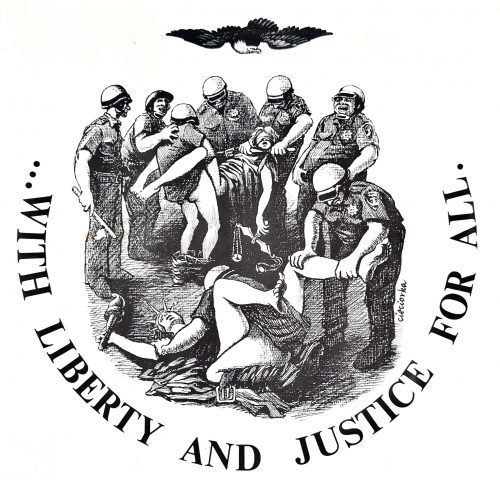 Offset lithography in back ink on paper, 448 x 448 mm, description by OMCA COLLECTIONS (Oakland Museum of California): The top edge of the poster has a stylized drawing of an eagle. Below, the poster has a drawing with eight male police officers and two female figures: one with the crown and torch of the Statue of Liberty, the other holding scales and wearing a blindfold in the style of personifications of justice. In the foreground of the drawing, one of the police officers is holding the liberty figure on the ground and raping her while a second officer holds one of her legs. In the background, the justice figure is being held up and raped by two officers. The rest of the police officers look at this scene and laugh or pat one another on the back. The bottom of the drawing is bordered by a semicircle of text that reads: "...WITH LIBERTY AND JUSTICE FOR ALL." [...] This provocative poster was described at a 1968 House Un-American Activities Committee (HUAC) hearing as "one of the most vile, obscene pieces of literature that I have seen disseminated in San Francisco" by San Francisco Examiner reporter Edward S. Montgomery. Contributors: Frank Cieciorka (American, 1939 – 2008) – artist.
Offset lithography in back ink on paper, 448 x 448 mm, description by OMCA COLLECTIONS (Oakland Museum of California): The top edge of the poster has a stylized drawing of an eagle. Below, the poster has a drawing with eight male police officers and two female figures: one with the crown and torch of the Statue of Liberty, the other holding scales and wearing a blindfold in the style of personifications of justice. In the foreground of the drawing, one of the police officers is holding the liberty figure on the ground and raping her while a second officer holds one of her legs. In the background, the justice figure is being held up and raped by two officers. The rest of the police officers look at this scene and laugh or pat one another on the back. The bottom of the drawing is bordered by a semicircle of text that reads: "...WITH LIBERTY AND JUSTICE FOR ALL." [...] This provocative poster was described at a 1968 House Un-American Activities Committee (HUAC) hearing as "one of the most vile, obscene pieces of literature that I have seen disseminated in San Francisco" by San Francisco Examiner reporter Edward S. Montgomery. Contributors: Frank Cieciorka (American, 1939 – 2008) – artist. -
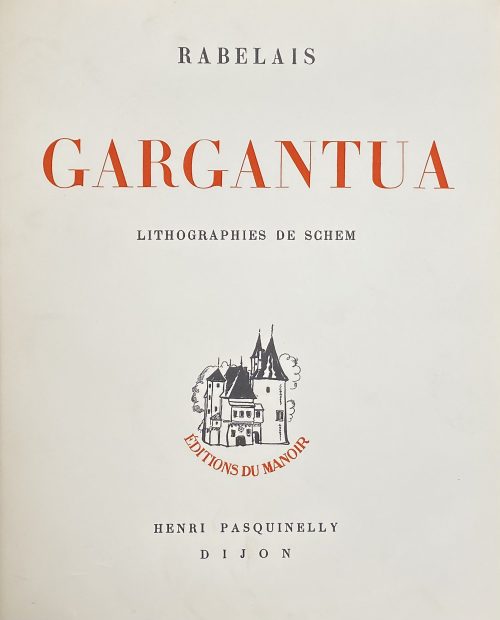 Description: One volume bound in green morocco, sunned spine with raised bands and gilt lettering, collated 8vo, 28.3 x 23 cm, original wrappers and spine preserved, top margin gilt; numerous in-text woodcuts, 30 full-page plates and one plate tipped-in. Front wrapper (red and black): RABELAIS | GARGANTUA | LITHOGRAPHIES DE SCHEM | {publisher’s device lettered in red “ÉDITIONS DU MANOIR”} | HENRI PASQUINELLY | DIJON || Half-title: LA VIE TRESHORRIFIQUE | DU | GRAND GARGANTUA | PERE DE PANTAGRUEL | JADIS COMPOSÉE | PAR MAISTRE ALCOFRIBAS | ABSTRACTEUR DE QUINTE ESSENCE | — | LIVRE PLEIN DE PANTAGRUELISME || Title-page (red and black): RABELAIS | GARGANTUA | LITHOGRAPHIES DE SCHEM | AVEC UNE PRÉFACE ET DES RÉSUMÉS EXPLICATIFS PAR | PIERRE HUGUENIN | UN GLOSSAIRE ET DES NOTES DE | LOUIS PERCEAU | {publisher’s device lettered in red “ÉDITIONS DU MANOIR”} | HENRI PASQUINELLY | DIJON || Collation: 2 blanks, front wrapper, [1] 2-118, spine, back wrapper, 2 blanks, total 88 leaves between the wrappers plus 30 plates incl. frontispiece, two of which are double-page, extraneous to collation with lettered tissue guards, and one cancelled plate with lettered tissue guard tipped-in. Pagination: [1-7] 8-171 [172] [2 colophon] [2 blank], total 176 pages, ils. Printed on February 20, 1937, at Imprimerie Darantière (Dijon), lithographs were printed by Desjobert (Paris). Limitation: The print run of 3,335 copies, of which 10 (№ I-X) on Japon Impérial, 300 copies (№ 1-300) on Vélin de Rives, 3000 copies (№ 301-3,300) on Bouffant Dauphinois, and 25 copies (A-Z ) on Vélin de Rives for collaborators. This is copy № 45 on Vélin de Rives, enriched with one cancelled plate (see image below).Collaborators: François Rabelais [Alcofribas Nasier] (French, c. 1494 – 1553) – author. Pierre Huguenin (French, 1874 – 1937) – author. Louis Perceau (French, 1883 – 1942) – author. Raoul Serres [Schem] (French, 1881– 1971) – artist. Éditions du manoir; Henri Pasquinelly [Pasquinelli] (French, 20th century) – publisher. Imprimerie Darantière (Dijon) – printer. Edmond Desjobert (French, 1888 – 1963); Edmond et Jacques Desjobert – lithography printer.
Description: One volume bound in green morocco, sunned spine with raised bands and gilt lettering, collated 8vo, 28.3 x 23 cm, original wrappers and spine preserved, top margin gilt; numerous in-text woodcuts, 30 full-page plates and one plate tipped-in. Front wrapper (red and black): RABELAIS | GARGANTUA | LITHOGRAPHIES DE SCHEM | {publisher’s device lettered in red “ÉDITIONS DU MANOIR”} | HENRI PASQUINELLY | DIJON || Half-title: LA VIE TRESHORRIFIQUE | DU | GRAND GARGANTUA | PERE DE PANTAGRUEL | JADIS COMPOSÉE | PAR MAISTRE ALCOFRIBAS | ABSTRACTEUR DE QUINTE ESSENCE | — | LIVRE PLEIN DE PANTAGRUELISME || Title-page (red and black): RABELAIS | GARGANTUA | LITHOGRAPHIES DE SCHEM | AVEC UNE PRÉFACE ET DES RÉSUMÉS EXPLICATIFS PAR | PIERRE HUGUENIN | UN GLOSSAIRE ET DES NOTES DE | LOUIS PERCEAU | {publisher’s device lettered in red “ÉDITIONS DU MANOIR”} | HENRI PASQUINELLY | DIJON || Collation: 2 blanks, front wrapper, [1] 2-118, spine, back wrapper, 2 blanks, total 88 leaves between the wrappers plus 30 plates incl. frontispiece, two of which are double-page, extraneous to collation with lettered tissue guards, and one cancelled plate with lettered tissue guard tipped-in. Pagination: [1-7] 8-171 [172] [2 colophon] [2 blank], total 176 pages, ils. Printed on February 20, 1937, at Imprimerie Darantière (Dijon), lithographs were printed by Desjobert (Paris). Limitation: The print run of 3,335 copies, of which 10 (№ I-X) on Japon Impérial, 300 copies (№ 1-300) on Vélin de Rives, 3000 copies (№ 301-3,300) on Bouffant Dauphinois, and 25 copies (A-Z ) on Vélin de Rives for collaborators. This is copy № 45 on Vélin de Rives, enriched with one cancelled plate (see image below).Collaborators: François Rabelais [Alcofribas Nasier] (French, c. 1494 – 1553) – author. Pierre Huguenin (French, 1874 – 1937) – author. Louis Perceau (French, 1883 – 1942) – author. Raoul Serres [Schem] (French, 1881– 1971) – artist. Éditions du manoir; Henri Pasquinelly [Pasquinelli] (French, 20th century) – publisher. Imprimerie Darantière (Dijon) – printer. Edmond Desjobert (French, 1888 – 1963); Edmond et Jacques Desjobert – lithography printer.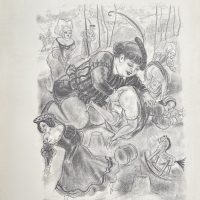
Ce petit paillard tousjours tastonnoyt ses gouvernantes cen dessus dessous, cen devant darriere.
-
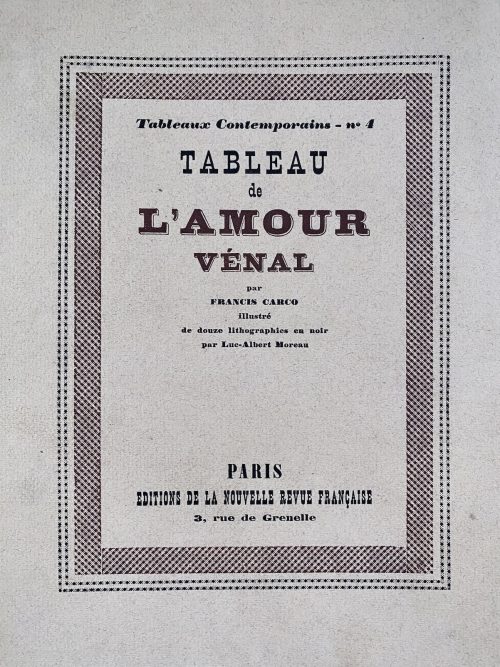 Description: Softcover, French flapped wrappers, lettered front, back (advert.) and spine, collated in-4to, 24.3 x 20.2 cm, printed on thick wove paper Vélin pur fil Lafuma-Navarre, print run limited to 335 copies from which this is copy № 219; outer margin untrimmed, some leaves uncut, glassine DJ. Limitation: 1 copy (A) on Japon Impérial + double suite of plates + suite of original drawings, 4 copies (B-E) on Japon Impérial + double suite of plates, 15 copies on on Japon Impérial + suite of plates on Vieux Japon teinté (F-T), 315 copies on Vélin pur fil Lafuma-Navarre, of which 15 (I-XV) not for sale. Copyright: Libraire Gallimard, 1924. Printed: March 10, 1924 – text by Coulouma (Argenteuil) under direction of H. Barthélemy, lithographs printed by Marchizet (Paris). Front wrapper (in letterpress two-colour border): Tableaux Contemporains – no 4 | . TABLEAU | de | L'AMOUR | VÉNAL | par | FRANCIS CARCO | Illustré | de douze lithographies en noir | par Luc-Albert Moreau | PARIS | ÉDITIONS DE LA NOUVELLE REVUE FRANÇAISE | 3, rue de Grenelle || Title-page: Same, without a frame, in black, L'AMOUR | VÉNAL in brown. Collation: 4to; 14 a4 2-164, total 68 leaves with wrappers included in collation plus 12 plates, incl. frontispiece, extraneous to collation. Pagination: [2 wrapper] [6] [i] ii-vii [viii blank] [9] 10-122 [2 colophon] [2 blank] [2 wrapper]; total 136 pages incl. wrappers, plus ils. Contributors: Francis Carco [François Carcopino-Tusoli] (French, 1886 – 1958) – author. Luc-Albert Moreau (French, 1882 – 1948) – artist. La Nouvelle Revue Française (nrf) (Paris)– publisher. Gaston Gallimard (French, 1881 – 1975) – publisher.
Description: Softcover, French flapped wrappers, lettered front, back (advert.) and spine, collated in-4to, 24.3 x 20.2 cm, printed on thick wove paper Vélin pur fil Lafuma-Navarre, print run limited to 335 copies from which this is copy № 219; outer margin untrimmed, some leaves uncut, glassine DJ. Limitation: 1 copy (A) on Japon Impérial + double suite of plates + suite of original drawings, 4 copies (B-E) on Japon Impérial + double suite of plates, 15 copies on on Japon Impérial + suite of plates on Vieux Japon teinté (F-T), 315 copies on Vélin pur fil Lafuma-Navarre, of which 15 (I-XV) not for sale. Copyright: Libraire Gallimard, 1924. Printed: March 10, 1924 – text by Coulouma (Argenteuil) under direction of H. Barthélemy, lithographs printed by Marchizet (Paris). Front wrapper (in letterpress two-colour border): Tableaux Contemporains – no 4 | . TABLEAU | de | L'AMOUR | VÉNAL | par | FRANCIS CARCO | Illustré | de douze lithographies en noir | par Luc-Albert Moreau | PARIS | ÉDITIONS DE LA NOUVELLE REVUE FRANÇAISE | 3, rue de Grenelle || Title-page: Same, without a frame, in black, L'AMOUR | VÉNAL in brown. Collation: 4to; 14 a4 2-164, total 68 leaves with wrappers included in collation plus 12 plates, incl. frontispiece, extraneous to collation. Pagination: [2 wrapper] [6] [i] ii-vii [viii blank] [9] 10-122 [2 colophon] [2 blank] [2 wrapper]; total 136 pages incl. wrappers, plus ils. Contributors: Francis Carco [François Carcopino-Tusoli] (French, 1886 – 1958) – author. Luc-Albert Moreau (French, 1882 – 1948) – artist. La Nouvelle Revue Française (nrf) (Paris)– publisher. Gaston Gallimard (French, 1881 – 1975) – publisher. -
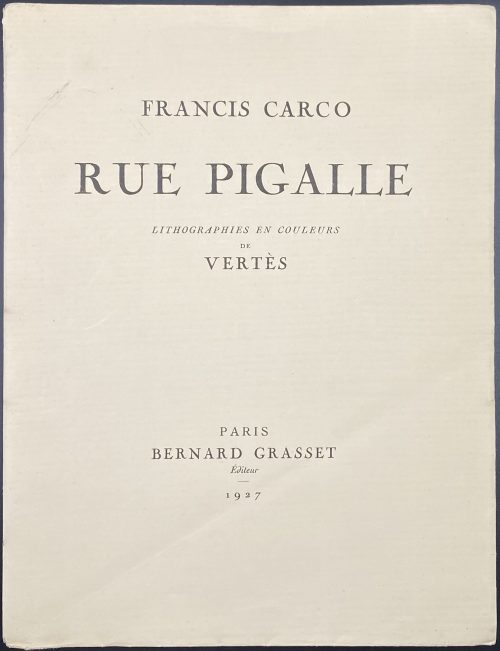 Title-page: FRANCIS CARCO | RUE PIGALLE | LITHOGRAPHIES EN COULEURS | DE | VERTÈS | PARIS | BERNARD GRASSET | Éditeur | 1927 || Description: 25.7 x 19.5 cm, French flapped cream wrappers with black lettering similar to title, lettering to spine, [2] 1st blank leaf, [2] h.t. / blank, plate / blank, [2] t.p. /blank, dedication “A | FRED ANTOINE ANGERMAYER” / blank, [1-2] d.t.p. “CHAPITRE | PREMIER” / blank, [3] 4-124, [2] limitation / blank, [2] last blank leaf; collation: 4to; π4 1-164; total 68 leaves and 14 plates printed by Frères Mourlot after watercolours by Marcel Vertès. Printing : September 15, 1927 by Coulouma in Argenteuil (H. Barthélemy, director); plates printed by Frères Mourlot in Paris; Edition: print run limited to 338 copies of which 22 on Japon Impérial (numbered Japon 1-15 and I-VII) enriched with one original watercolour drawing, one suite in black and one in colour, etc.; 43 copies on Hollande van Gelder (Hollande 1-33 and I-X) with additional suites in black and in colour; 270 copies on Vélin d’Arches (Arches 1-250 and I-XX); and 3 “special” copies. This copy is numbered Arches № 162. Contributors: Francis Carco [François Carcopino-Tusoli] (French, 1886 – 1958) – author. Marcel Vertès [Marcell Vértes] (Jewish-Hungarian-French, 1895 – 1961) – artist. Frères Mourlot – lithographer. Robert Coulouma (French, 1887 – 1976) – printer. Bernard Grasset (French, 1881 – 1955) – publisher. Fred Antoine Angermayer (German, 1889 –1951) – dedicatee. Other names: Marcel Vertès, Marcel Vertes, Marcell Vértes
Title-page: FRANCIS CARCO | RUE PIGALLE | LITHOGRAPHIES EN COULEURS | DE | VERTÈS | PARIS | BERNARD GRASSET | Éditeur | 1927 || Description: 25.7 x 19.5 cm, French flapped cream wrappers with black lettering similar to title, lettering to spine, [2] 1st blank leaf, [2] h.t. / blank, plate / blank, [2] t.p. /blank, dedication “A | FRED ANTOINE ANGERMAYER” / blank, [1-2] d.t.p. “CHAPITRE | PREMIER” / blank, [3] 4-124, [2] limitation / blank, [2] last blank leaf; collation: 4to; π4 1-164; total 68 leaves and 14 plates printed by Frères Mourlot after watercolours by Marcel Vertès. Printing : September 15, 1927 by Coulouma in Argenteuil (H. Barthélemy, director); plates printed by Frères Mourlot in Paris; Edition: print run limited to 338 copies of which 22 on Japon Impérial (numbered Japon 1-15 and I-VII) enriched with one original watercolour drawing, one suite in black and one in colour, etc.; 43 copies on Hollande van Gelder (Hollande 1-33 and I-X) with additional suites in black and in colour; 270 copies on Vélin d’Arches (Arches 1-250 and I-XX); and 3 “special” copies. This copy is numbered Arches № 162. Contributors: Francis Carco [François Carcopino-Tusoli] (French, 1886 – 1958) – author. Marcel Vertès [Marcell Vértes] (Jewish-Hungarian-French, 1895 – 1961) – artist. Frères Mourlot – lithographer. Robert Coulouma (French, 1887 – 1976) – printer. Bernard Grasset (French, 1881 – 1955) – publisher. Fred Antoine Angermayer (German, 1889 –1951) – dedicatee. Other names: Marcel Vertès, Marcel Vertes, Marcell Vértes -
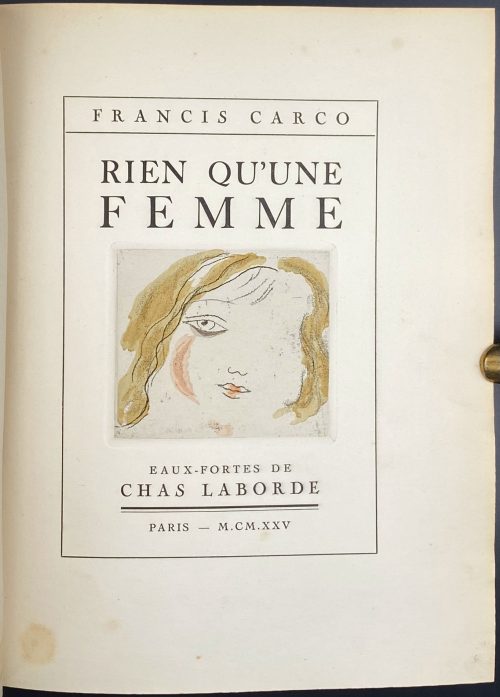 Title-page (text in frame): FRANCIS CARCO | RIEN QU'UNE | FEMME | {vignette} | EAUX-FORTES DE | CHAS LABORDE | — | PARIS — M.CM.XXV || Description: 4to, 24.5 x 20 cm, owner’s red cloth, yellow leather label with gilt lettering to spine, original wrappers bound in, woodcut bookplate “ИЗ КНИГ Ф.РОЖАНКОВСКАГО” to front pastedown; chapter titles and initials printed in pink. Collation: fep, 2 blanks before front wrapper, front wrapper with a black lettered pink label, 2 blanks, h.t., t.p., dedication, 1-204 212,2 blanks, rear wrapper, 2 blanks, rep; total 89 leaves within wrappers, plus 15 plates with tissue guards, incl. frontispiece – hand-coloured etchings by Chas [Charles] Laborde, extraneous to collation. In some copies, there are two additional plates. Pagination: [10] [1] 2-162 [2 colophon/blank] [4], total 178 pages. Limitation: Date of printing: September 15, 1925. Printer: Imprimeur Coulouma (Argenteuil) Print run: 267 copies of which 1 copy on Japon Ancien (№1), 15 on Japon Impérial (№№ 2-16), 60 on Hollande (№№ 17-76), and 200 copies on Vélin de Rives (№№ 77-276) ; this is copy № 82. Etchings printed on BFK Rives paper (embossed). Provenance: Rojankovsky, Feodor [Rojan; Рожанковский, Фёдор Степанович] (Russian-American, 1891 – 1970). Contributors: Francis Carco [François Carcopino-Tusoli] (French, 1886 – 1958) – author. Chas Laborde [Charles Laborde] (French, 1886 – 1941) – artist. Roger Lacourière (French, 1892 – 1966) – engraver.
Title-page (text in frame): FRANCIS CARCO | RIEN QU'UNE | FEMME | {vignette} | EAUX-FORTES DE | CHAS LABORDE | — | PARIS — M.CM.XXV || Description: 4to, 24.5 x 20 cm, owner’s red cloth, yellow leather label with gilt lettering to spine, original wrappers bound in, woodcut bookplate “ИЗ КНИГ Ф.РОЖАНКОВСКАГО” to front pastedown; chapter titles and initials printed in pink. Collation: fep, 2 blanks before front wrapper, front wrapper with a black lettered pink label, 2 blanks, h.t., t.p., dedication, 1-204 212,2 blanks, rear wrapper, 2 blanks, rep; total 89 leaves within wrappers, plus 15 plates with tissue guards, incl. frontispiece – hand-coloured etchings by Chas [Charles] Laborde, extraneous to collation. In some copies, there are two additional plates. Pagination: [10] [1] 2-162 [2 colophon/blank] [4], total 178 pages. Limitation: Date of printing: September 15, 1925. Printer: Imprimeur Coulouma (Argenteuil) Print run: 267 copies of which 1 copy on Japon Ancien (№1), 15 on Japon Impérial (№№ 2-16), 60 on Hollande (№№ 17-76), and 200 copies on Vélin de Rives (№№ 77-276) ; this is copy № 82. Etchings printed on BFK Rives paper (embossed). Provenance: Rojankovsky, Feodor [Rojan; Рожанковский, Фёдор Степанович] (Russian-American, 1891 – 1970). Contributors: Francis Carco [François Carcopino-Tusoli] (French, 1886 – 1958) – author. Chas Laborde [Charles Laborde] (French, 1886 – 1941) – artist. Roger Lacourière (French, 1892 – 1966) – engraver. -
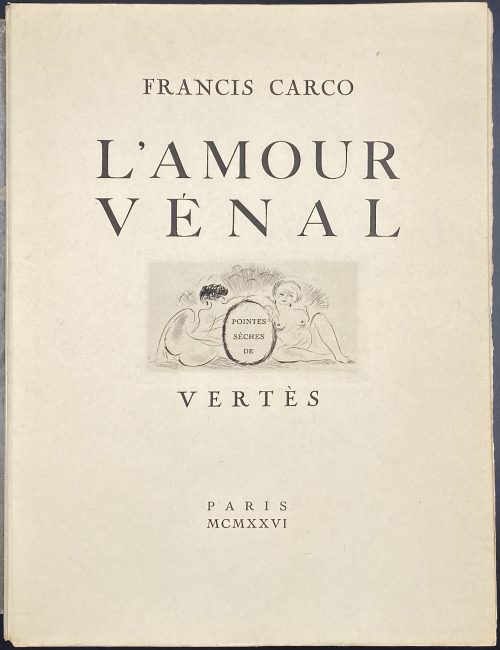 Description: One volume, publisher’s original tan French flapped wrappers with engraved vignette, in glassine DJ, unbound, 25.5 x 19.5 cm, collated in-4to, bottom and outer margins untrimmed, some pages uncut, printed on laid watermarked Van Gelder Zonen paper, illustrated with 15 full-page drypoint plates, some with tissue guard; front wrapper, t.p. and table vignettes, numerous head- and tailpieces by R. Lacourière after drawings by Marcel Vertès, enriched with two cancelled images printed on different laid papers in different states, three of each image. Printed on June 10, 1926 by Coulouma (Argenteuil) under the direction of H. Barthélemy, drypoints by Roger Lacourière (Paris). Limitation: 95 copies of which № 1 on Japon Ancien, № № 2-26 on Japon Impérial, and №№ 27-95 on Hollande. This is copy № 78. Front wrapper: FRANCIS CARCO | L'AMOUR | VÉNAL | {vignette with inscription in oval tablet «POINTES | SÈCHES | DE» } | VERTÈS | PARIS | MCMXXVI || Title-page: FRANCIS CARCO | L'AMOUR | VÉNAL | {vignette} | POINTES SÈCHES DE | VERTÈS | PARIS | MCMXXVI || Collation: 2 leaves in wrapper, π4 (fac-simile of Carco a.l.s., h.t., t.p., authorship) a4 (preface), 1-164 [17]4, 2 leaves in wrapper; total without the wrapper 76 leaves plus 15 plates, plus 6 plates of enrichment plates. Pagination: [8] [i] [ii-viii] [1] 2-128 [8], total 152 pages, ils. Note: The edition is not in Dutel, not in Pia (Enfer); Fekete (2014): № 215, p. 117; Vokaer (1967): № 15, p.10. According to both sources, it is a 2-volume edition, with text in vol. 1 and plates in vol. 2. Vokaer attributes publishing to La Roseraie (Paris) and provides for 45 drypoints of which 18 full-page plates in the second volume. Fekete (Christie’s) provides for 15 full-page plates and 25 illustrations in text. Contributors: Francis Carco [François Carcopino-Tusoli] (French, 1886 – 1958) – author. Marcel Vertès [Marcell Vértes] (Jewish-Hungarian-French, 1895 – 1961) – artist. Roger Lacourière (French, 1892 – 1966) – engraver, printer.
Description: One volume, publisher’s original tan French flapped wrappers with engraved vignette, in glassine DJ, unbound, 25.5 x 19.5 cm, collated in-4to, bottom and outer margins untrimmed, some pages uncut, printed on laid watermarked Van Gelder Zonen paper, illustrated with 15 full-page drypoint plates, some with tissue guard; front wrapper, t.p. and table vignettes, numerous head- and tailpieces by R. Lacourière after drawings by Marcel Vertès, enriched with two cancelled images printed on different laid papers in different states, three of each image. Printed on June 10, 1926 by Coulouma (Argenteuil) under the direction of H. Barthélemy, drypoints by Roger Lacourière (Paris). Limitation: 95 copies of which № 1 on Japon Ancien, № № 2-26 on Japon Impérial, and №№ 27-95 on Hollande. This is copy № 78. Front wrapper: FRANCIS CARCO | L'AMOUR | VÉNAL | {vignette with inscription in oval tablet «POINTES | SÈCHES | DE» } | VERTÈS | PARIS | MCMXXVI || Title-page: FRANCIS CARCO | L'AMOUR | VÉNAL | {vignette} | POINTES SÈCHES DE | VERTÈS | PARIS | MCMXXVI || Collation: 2 leaves in wrapper, π4 (fac-simile of Carco a.l.s., h.t., t.p., authorship) a4 (preface), 1-164 [17]4, 2 leaves in wrapper; total without the wrapper 76 leaves plus 15 plates, plus 6 plates of enrichment plates. Pagination: [8] [i] [ii-viii] [1] 2-128 [8], total 152 pages, ils. Note: The edition is not in Dutel, not in Pia (Enfer); Fekete (2014): № 215, p. 117; Vokaer (1967): № 15, p.10. According to both sources, it is a 2-volume edition, with text in vol. 1 and plates in vol. 2. Vokaer attributes publishing to La Roseraie (Paris) and provides for 45 drypoints of which 18 full-page plates in the second volume. Fekete (Christie’s) provides for 15 full-page plates and 25 illustrations in text. Contributors: Francis Carco [François Carcopino-Tusoli] (French, 1886 – 1958) – author. Marcel Vertès [Marcell Vértes] (Jewish-Hungarian-French, 1895 – 1961) – artist. Roger Lacourière (French, 1892 – 1966) – engraver, printer. -
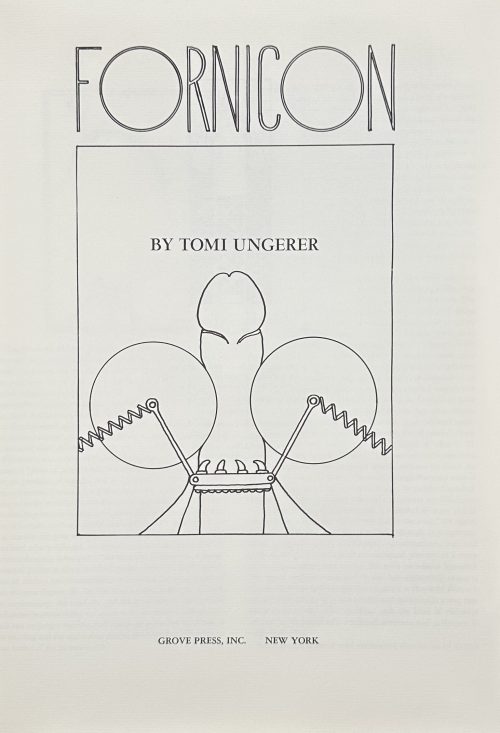 Hardcover, 333 x 247 mm, black cloth with gilt facsimile to front board and gilt lettering to spine, aubergine dust jacket with white lettering and red facsimile over black panel to front and back, crimson endpapers, laid paper, unpaginated; pp.: [4] h.t./blank, t.p./imprint, [2] text by John Hollander, 61 leaves of plates; originally published in 1969 by Rhinoceros Press, New York, as a limited-edition portfolio with slipcase. Title-page: Fornicon | (in frame) BY TOMI UNGERER | GROVE PRESS NEW YORK || Jean-Thomas [Tomi] Ungerer (French,1931 – 2019) John Hollander (American, 1929 – 2013)
Hardcover, 333 x 247 mm, black cloth with gilt facsimile to front board and gilt lettering to spine, aubergine dust jacket with white lettering and red facsimile over black panel to front and back, crimson endpapers, laid paper, unpaginated; pp.: [4] h.t./blank, t.p./imprint, [2] text by John Hollander, 61 leaves of plates; originally published in 1969 by Rhinoceros Press, New York, as a limited-edition portfolio with slipcase. Title-page: Fornicon | (in frame) BY TOMI UNGERER | GROVE PRESS NEW YORK || Jean-Thomas [Tomi] Ungerer (French,1931 – 2019) John Hollander (American, 1929 – 2013) -
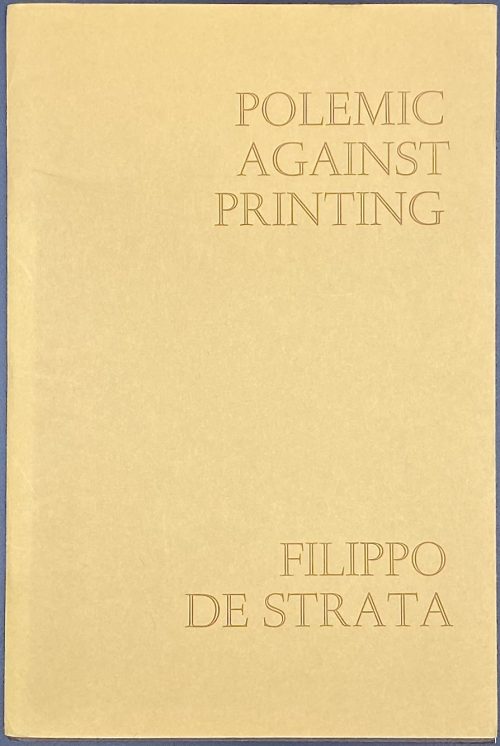 POLEMIC AGAINST PRINTING | by | FILIPPO DE STRATA | Translated by SHELAGH GRIER | Edited and | Introduced by MARTIN LOWRY | University of Warwick | The Hayloft Press | 1986 || Publisher’s mustard wrappers w/ lettering, 18.5 x 12.5 cm, 20 unnumbered pages of parallel Latin text and English translation with English introduction; limited edition of 350 copies, 100 for private circulation and 250 numbered copies for sale of which this is №3, with ink inscription to the last page: To Beryl | on her birthday, 1986 | with love from | David ||
POLEMIC AGAINST PRINTING | by | FILIPPO DE STRATA | Translated by SHELAGH GRIER | Edited and | Introduced by MARTIN LOWRY | University of Warwick | The Hayloft Press | 1986 || Publisher’s mustard wrappers w/ lettering, 18.5 x 12.5 cm, 20 unnumbered pages of parallel Latin text and English translation with English introduction; limited edition of 350 copies, 100 for private circulation and 250 numbered copies for sale of which this is №3, with ink inscription to the last page: To Beryl | on her birthday, 1986 | with love from | David || -
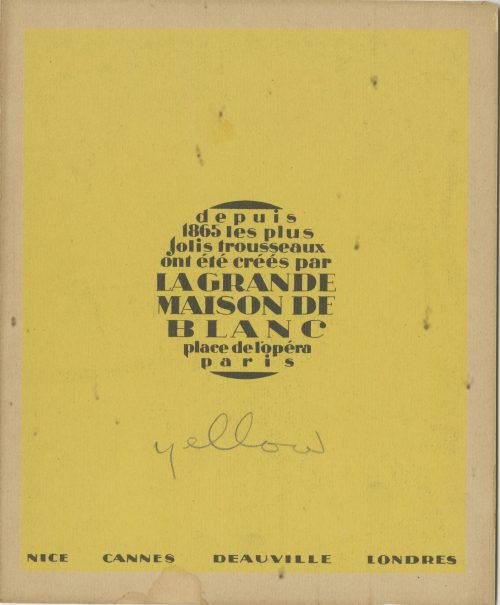 Four chromolithographic plates, each sheet 180 x 150 mm; image 16 x 12.5 cm after Feodor Rojankovsky, signed “Rojan”, titles printed on the back on red (à la chasse), blue (en voyage), green (aux courses), and yellow (depuis | 1865 les plus | jolis trousseaux | ont été créés par | LA GRANDE | MAISON DE | BLANC | place de l’opera | Paris | NICE CANNES DEAUVILLE LONDRES) background. Contributors: Feodor Rojankovsky [Rojan, Фёдор Степанович Рожанковский] (Russian-American, 1891 – 1970) – artist.
Four chromolithographic plates, each sheet 180 x 150 mm; image 16 x 12.5 cm after Feodor Rojankovsky, signed “Rojan”, titles printed on the back on red (à la chasse), blue (en voyage), green (aux courses), and yellow (depuis | 1865 les plus | jolis trousseaux | ont été créés par | LA GRANDE | MAISON DE | BLANC | place de l’opera | Paris | NICE CANNES DEAUVILLE LONDRES) background. Contributors: Feodor Rojankovsky [Rojan, Фёдор Степанович Рожанковский] (Russian-American, 1891 – 1970) – artist. -
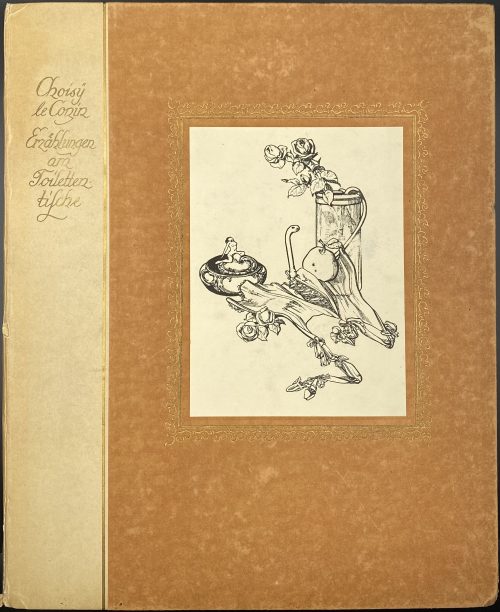 Publisher's flapped portfolio 32.8 x 26.8 cm, gilt-ruled and gilt-lettered quarter faux-parchment waxed paper over brown paper boards with pasted illustration after von Bayros within gilt arabesque frame. Possibly published in Vienna by Heinrich Conrad in 1905 or 1908. The portfolio contains the title page with a vignette and 15 loose wove paper sheets 32 x 26.2 cm of collotype reproductions after drawings by Franz von Bayros. Cover gilt lettering: Choisÿ | le Conin | Erzählungen | am | Toiletten- | tische || Title-page: Erzählungen | am Toilettentische | von | CHOISY LE CONIN | {vignette} || Title-page verso: Inhalt: | 1. Die Tabaksdose | 2. Viola de Gamba | 3. Der Bote | 4. Nicht drängeln, Kinder! | 5. Die blaue Feder | 6. O what a pretty like-place! | 7. Die Sonnenuhr |8. Der Temel der der Cotÿs | 9. Der Fetischist | 10. Jupiter und Europa | 11. Die Witwe | 12. Paroxÿsme-erotique | 13. Der Rivale | 14. Die rote Lehrerin | 15. Tantalus | Nicht im Handel. || Catalogue raisonné: The amorous drawings of the Marquis von Bayros / Part I and II. — NY: Cythera Press, 1968; pp. 95-111 [LIB-2246.2019]
Publisher's flapped portfolio 32.8 x 26.8 cm, gilt-ruled and gilt-lettered quarter faux-parchment waxed paper over brown paper boards with pasted illustration after von Bayros within gilt arabesque frame. Possibly published in Vienna by Heinrich Conrad in 1905 or 1908. The portfolio contains the title page with a vignette and 15 loose wove paper sheets 32 x 26.2 cm of collotype reproductions after drawings by Franz von Bayros. Cover gilt lettering: Choisÿ | le Conin | Erzählungen | am | Toiletten- | tische || Title-page: Erzählungen | am Toilettentische | von | CHOISY LE CONIN | {vignette} || Title-page verso: Inhalt: | 1. Die Tabaksdose | 2. Viola de Gamba | 3. Der Bote | 4. Nicht drängeln, Kinder! | 5. Die blaue Feder | 6. O what a pretty like-place! | 7. Die Sonnenuhr |8. Der Temel der der Cotÿs | 9. Der Fetischist | 10. Jupiter und Europa | 11. Die Witwe | 12. Paroxÿsme-erotique | 13. Der Rivale | 14. Die rote Lehrerin | 15. Tantalus | Nicht im Handel. || Catalogue raisonné: The amorous drawings of the Marquis von Bayros / Part I and II. — NY: Cythera Press, 1968; pp. 95-111 [LIB-2246.2019] -
 Title page: ACROSS THE RIVER | AND | INTO THE TREES | BY | ERNEST HEMINGWAY | CHARLES SCRIBNER'S SONS | NEW YORK | 1950 || Pagination: [12] 1-308; total 160 leaves. Binding: black cloth, gilt Hemingway's fac-simile to front board, lettering to spine, pictorial dust jacket designed by A. Ivancich; $3.00 price clipped from top of front flap. Bookplate of Feodor Rojankovsky to front pastedown. Size: 21.5 x 15 cm. Edition: 1st edition, 1st printing; DJ with yellow on spine (later copies have orange); letter “A” and the Scribner’s device to copyright page. Provenance: Rojankovsky, Feodor [Rojan; Рожанковский, Фёдор Степанович] (Russian-American, 1891 – 1970) Contributors: Ernest Hemingway (American, 1899 – 1961) – author. Adriana Ivancich (Italian, 1930 – 1983) – artist of the dust jacket (Ivancich inspired the figure of Renata in the novel). Charles Scribner's Sons – publisher.
Title page: ACROSS THE RIVER | AND | INTO THE TREES | BY | ERNEST HEMINGWAY | CHARLES SCRIBNER'S SONS | NEW YORK | 1950 || Pagination: [12] 1-308; total 160 leaves. Binding: black cloth, gilt Hemingway's fac-simile to front board, lettering to spine, pictorial dust jacket designed by A. Ivancich; $3.00 price clipped from top of front flap. Bookplate of Feodor Rojankovsky to front pastedown. Size: 21.5 x 15 cm. Edition: 1st edition, 1st printing; DJ with yellow on spine (later copies have orange); letter “A” and the Scribner’s device to copyright page. Provenance: Rojankovsky, Feodor [Rojan; Рожанковский, Фёдор Степанович] (Russian-American, 1891 – 1970) Contributors: Ernest Hemingway (American, 1899 – 1961) – author. Adriana Ivancich (Italian, 1930 – 1983) – artist of the dust jacket (Ivancich inspired the figure of Renata in the novel). Charles Scribner's Sons – publisher. -
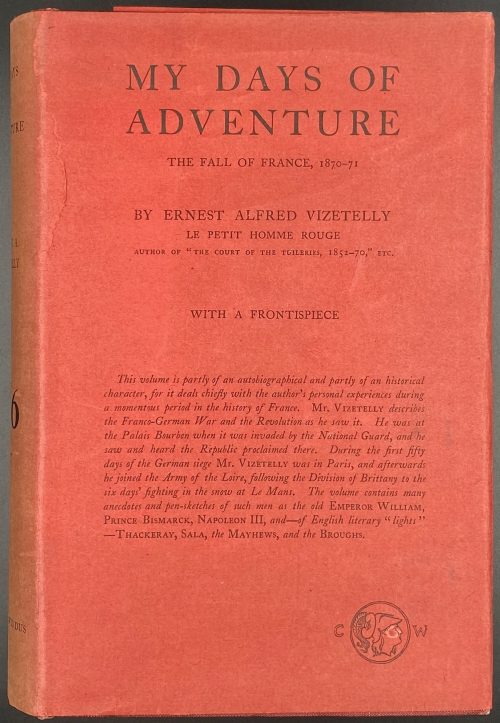 Description: Hardcover volume bound in red cloth with black lettering to front cover and spine, in a red dustjacket with black lettered, bookplate to front pastedown “ from the library of | DAVID. D. LEVINE | Militaria” in triple fillet frame, bookseller’s label to front fep “CHAS. E. LAURIAT CO. | IMPORTERS & BOOKSELLERS | 385 Wash’n St. Boston”. Title-page in red and black: MY DAYS OF ADVENTURE | THE FALL OF FRANCE, 1870-71 | BY ERNEST ALFRED VIZETELLY | LE PETIT HOMME ROUGE | AUTHOR OF “THE COURT OF THE TUILERIES 1852-70” ETC. | {publisher’s device} | WITH A FRONTISPIECE | LONDON | CHATTO & WINDUS | 1914 || Pagination: [2] advert., [i-vii] viii-xi [xii] [2] contents/blank, [1] 2-337 [338] [2], 340 pages total plus photo frontis. Collation: [A8] B-Y8 Z2, 170 leaves total plus one leaf of plates. Provenance: David D. Levine Contributors: Ernest Alfred Vizetelly (British, 1853 – 1922) – author. Charles E. Lauriat Company, Booksellers and Importers, Boston, Massachusetts. Charles Emelius Lauriat, Jr. (American, 1874 – 1937) – collector of rare books and prints Chatto & Windus (London) – publisher. David Daniel Levine (Australian, 1944 – 2020) – Australian judge and book collector
Description: Hardcover volume bound in red cloth with black lettering to front cover and spine, in a red dustjacket with black lettered, bookplate to front pastedown “ from the library of | DAVID. D. LEVINE | Militaria” in triple fillet frame, bookseller’s label to front fep “CHAS. E. LAURIAT CO. | IMPORTERS & BOOKSELLERS | 385 Wash’n St. Boston”. Title-page in red and black: MY DAYS OF ADVENTURE | THE FALL OF FRANCE, 1870-71 | BY ERNEST ALFRED VIZETELLY | LE PETIT HOMME ROUGE | AUTHOR OF “THE COURT OF THE TUILERIES 1852-70” ETC. | {publisher’s device} | WITH A FRONTISPIECE | LONDON | CHATTO & WINDUS | 1914 || Pagination: [2] advert., [i-vii] viii-xi [xii] [2] contents/blank, [1] 2-337 [338] [2], 340 pages total plus photo frontis. Collation: [A8] B-Y8 Z2, 170 leaves total plus one leaf of plates. Provenance: David D. Levine Contributors: Ernest Alfred Vizetelly (British, 1853 – 1922) – author. Charles E. Lauriat Company, Booksellers and Importers, Boston, Massachusetts. Charles Emelius Lauriat, Jr. (American, 1874 – 1937) – collector of rare books and prints Chatto & Windus (London) – publisher. David Daniel Levine (Australian, 1944 – 2020) – Australian judge and book collector -
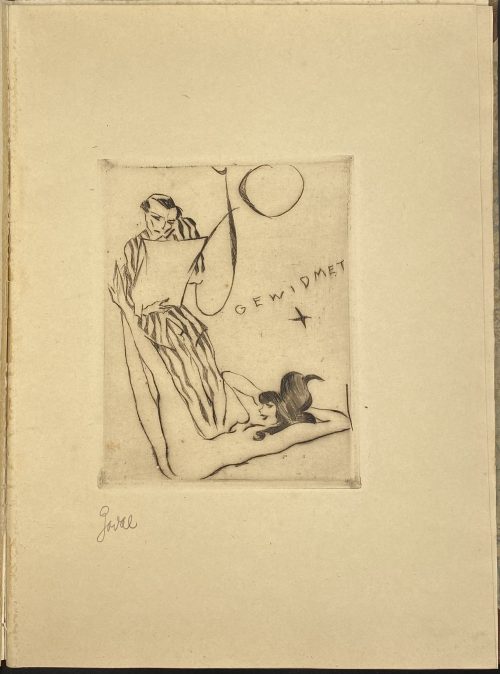 Half calf binding 33.5 x 25 cm, gilt lettering within rules “GODAL | JO”, engraved title-page and 9 etchings printed in sepia on sheets 32.5 x 24 cm of thick wove paper, pencil signed, presumably, by the artist; a newspaper clipping tipped-in. The number of copies is unknown. Ticket to front pastedown: "Haeusgen |8 München 90 | Reinekestrasse 36" According to seller: “Extraordinarily rare series of erotic original etchings. - Cf. Bilderlexikon II, 451 u. Vollmer II, 261 - According to KVK not in any library”. Contributors: Erich Godal [Erich Goldbaum] (German-Jewish, 1899 – 1969) – artist.
Half calf binding 33.5 x 25 cm, gilt lettering within rules “GODAL | JO”, engraved title-page and 9 etchings printed in sepia on sheets 32.5 x 24 cm of thick wove paper, pencil signed, presumably, by the artist; a newspaper clipping tipped-in. The number of copies is unknown. Ticket to front pastedown: "Haeusgen |8 München 90 | Reinekestrasse 36" According to seller: “Extraordinarily rare series of erotic original etchings. - Cf. Bilderlexikon II, 451 u. Vollmer II, 261 - According to KVK not in any library”. Contributors: Erich Godal [Erich Goldbaum] (German-Jewish, 1899 – 1969) – artist. -
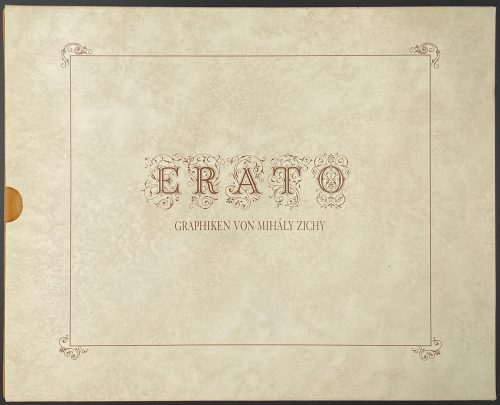 Description: Oblong volume, 19.3 x 24.2 cm, hardcover in velvet with pasted image, in a pictorial slipcase; printed on glossy paper, unpaginated. Title-page (in frame): ERATO | GRAPHIKEN VON MIHÁLY ZICHY || Collation: (2) h.t., t.p., (30) leaves of plates (4) text by Éva Bros, bibliography, colophon; total 36 leaves. The plates are photomechanical offset copies made from the photogravures of 1911 Leipzig private press edition [SVE-0501.2021], which photogravures made from the original watercolours and crayon drawings produced by Zichy in 1874-1879; the original album of 51 compositions was sold at Christie’s sale of Gérard Nordmann collection on December 14-15, 2006 in Paris. See a copy of the Leipzig album № 285 in this collection [SVE-0501.2021].
Description: Oblong volume, 19.3 x 24.2 cm, hardcover in velvet with pasted image, in a pictorial slipcase; printed on glossy paper, unpaginated. Title-page (in frame): ERATO | GRAPHIKEN VON MIHÁLY ZICHY || Collation: (2) h.t., t.p., (30) leaves of plates (4) text by Éva Bros, bibliography, colophon; total 36 leaves. The plates are photomechanical offset copies made from the photogravures of 1911 Leipzig private press edition [SVE-0501.2021], which photogravures made from the original watercolours and crayon drawings produced by Zichy in 1874-1879; the original album of 51 compositions was sold at Christie’s sale of Gérard Nordmann collection on December 14-15, 2006 in Paris. See a copy of the Leipzig album № 285 in this collection [SVE-0501.2021]. -
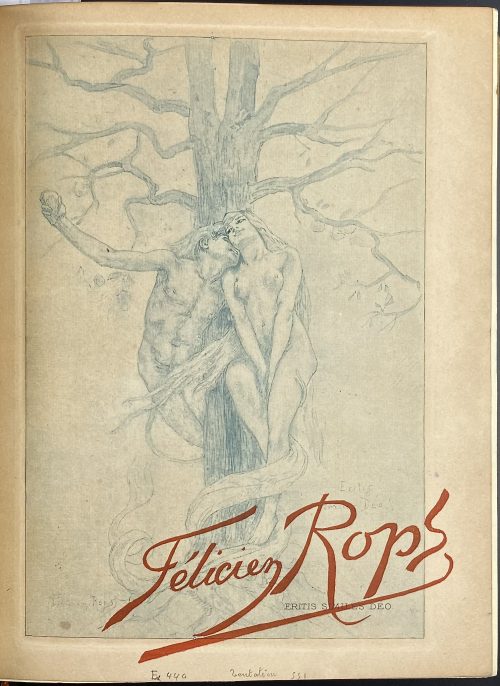 One volume in-4o, 26.5 x 21 x 4.4 cm, bound by Durvand (signed) in yellow ¾ morocco over marbled boards outlined in gilt, spine with raised bands, gilt lettering, vignettes after Félicien Rops in compartments, top margin gilt, marbled endpapers, publisher’s wrappers preserved; enriched with 57 original prints after Félicien Rops and an etched portrait of Félicien Rops by Robert Kastor. Collation: 3 blanks, π4 (orig. front wrapper ‘En souscription…./Etudes sur…’, La tentation…/Érastène Ramiro..., h.t./justification, t.p/blank), 1-274 (paginated 1-215 [216]) χ2 plus 58 leaves of bound-in original prints by various printers on different papers, some on India paper pasted on vergé, with tissue guards, and 1 leave of manuscript ‘Table de gravures dans le texte’; back wrapper with ‘Table des gravures ajoutées’ manuscript to recto, original spine, 2 blanks. Title-page (red and black): Études sur quelques Artistes originaux | — | FÉLICIEN ROPS | par | ÉRASTÈNE RAMIRO | {fleuron} | PARIS | (left): G. PELLET | 51, Rue Le Peletier, 51 | (right): H. FLOURY | 1, Boulevard des Capucines, 1 | 1905 || Limitation: 125 copies, of which 100 copies on Japon à la forme and 25 copies 0n papier de Chine. Photographs here represent the original prints only. Contributors: Eugène Rodrigues-Henriques [Eugène Rodrigues, Erastène Ramiro] (French, 1853 –1928) – author. Félicien Rops (Belgian, 1833 – 1898) – artist. Robert Kastor (French, 1872 – 1935) – artist. Imprimerie Charles Hérissey (Évreux) – printer Gustave Pellet (French, 1859 – 1919) – publisher. Henri Floury (French, 1862 –1961) – publisher. Lucien Durvand (French, 1852 – 1924) – bookbinder.
One volume in-4o, 26.5 x 21 x 4.4 cm, bound by Durvand (signed) in yellow ¾ morocco over marbled boards outlined in gilt, spine with raised bands, gilt lettering, vignettes after Félicien Rops in compartments, top margin gilt, marbled endpapers, publisher’s wrappers preserved; enriched with 57 original prints after Félicien Rops and an etched portrait of Félicien Rops by Robert Kastor. Collation: 3 blanks, π4 (orig. front wrapper ‘En souscription…./Etudes sur…’, La tentation…/Érastène Ramiro..., h.t./justification, t.p/blank), 1-274 (paginated 1-215 [216]) χ2 plus 58 leaves of bound-in original prints by various printers on different papers, some on India paper pasted on vergé, with tissue guards, and 1 leave of manuscript ‘Table de gravures dans le texte’; back wrapper with ‘Table des gravures ajoutées’ manuscript to recto, original spine, 2 blanks. Title-page (red and black): Études sur quelques Artistes originaux | — | FÉLICIEN ROPS | par | ÉRASTÈNE RAMIRO | {fleuron} | PARIS | (left): G. PELLET | 51, Rue Le Peletier, 51 | (right): H. FLOURY | 1, Boulevard des Capucines, 1 | 1905 || Limitation: 125 copies, of which 100 copies on Japon à la forme and 25 copies 0n papier de Chine. Photographs here represent the original prints only. Contributors: Eugène Rodrigues-Henriques [Eugène Rodrigues, Erastène Ramiro] (French, 1853 –1928) – author. Félicien Rops (Belgian, 1833 – 1898) – artist. Robert Kastor (French, 1872 – 1935) – artist. Imprimerie Charles Hérissey (Évreux) – printer Gustave Pellet (French, 1859 – 1919) – publisher. Henri Floury (French, 1862 –1961) – publisher. Lucien Durvand (French, 1852 – 1924) – bookbinder. -
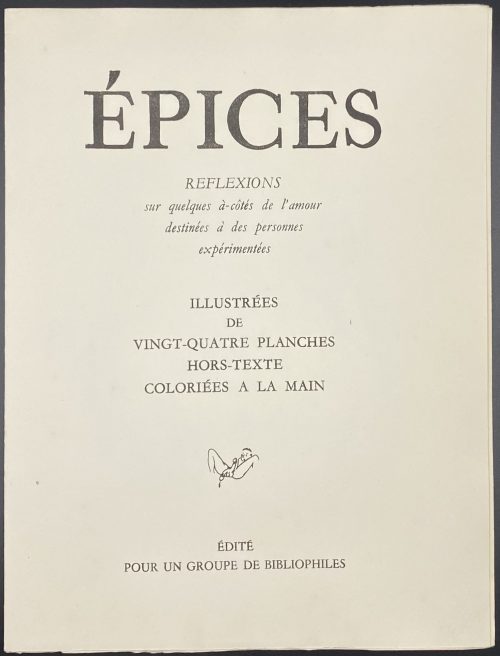 Description: French flapped wrappers, 27 x 20.5 cm, 134 gatherings, plus two leaves (blank, h.t. / limitation) at the beginning (54 leaves total), the first and the last two leaves blank, two pages in each of 12 gatherings (24 total) are hand-painted photogravures after etchings by an anonymous artist, attributed to Santippa, pseudonym of Georges or Gaston Hoffmann, or, possibly, of André Collot; the gatherings are unbound, pp. [1-10] 11-99 [100] [8] (108 pages total). Title-page: ÉPICES | REFLEXIONS | sur quelques à-côtés de l'amour | destinées à des personnes | expérimentées | ILLUSTREES | DE | VINGT-QUATRE PLANCHES | HORS-TEXTE | COLORIÉES A LA MAIN | {vignette} | ÉDITÉ | POUR UN GROUPE DE BIBLIOPHILES || Edition: limited to 500 copies numbered from 1 to 480 + 20 hand-numbered with Roman numbers. This is copy № 273. Enrichment: one original sketch (for Coucou… ou l’erreur de porte), one etching before letters and the same after letters and coloured (Le petit coin tranquille.. 19/20), and a full suite of 24 original etchings in sepia on cream paper, 20 of them on Arches and 4 on BFK Rives) printed for the first 17 copies of the 1950 edition (55 copies were printed then). In addition: one graphite pencil sketch which is not part of the suite. Catalogue raisonné: Dutel 1920 – 1970: № 1490 (for 1950), № 1491 (for 1955).
Description: French flapped wrappers, 27 x 20.5 cm, 134 gatherings, plus two leaves (blank, h.t. / limitation) at the beginning (54 leaves total), the first and the last two leaves blank, two pages in each of 12 gatherings (24 total) are hand-painted photogravures after etchings by an anonymous artist, attributed to Santippa, pseudonym of Georges or Gaston Hoffmann, or, possibly, of André Collot; the gatherings are unbound, pp. [1-10] 11-99 [100] [8] (108 pages total). Title-page: ÉPICES | REFLEXIONS | sur quelques à-côtés de l'amour | destinées à des personnes | expérimentées | ILLUSTREES | DE | VINGT-QUATRE PLANCHES | HORS-TEXTE | COLORIÉES A LA MAIN | {vignette} | ÉDITÉ | POUR UN GROUPE DE BIBLIOPHILES || Edition: limited to 500 copies numbered from 1 to 480 + 20 hand-numbered with Roman numbers. This is copy № 273. Enrichment: one original sketch (for Coucou… ou l’erreur de porte), one etching before letters and the same after letters and coloured (Le petit coin tranquille.. 19/20), and a full suite of 24 original etchings in sepia on cream paper, 20 of them on Arches and 4 on BFK Rives) printed for the first 17 copies of the 1950 edition (55 copies were printed then). In addition: one graphite pencil sketch which is not part of the suite. Catalogue raisonné: Dutel 1920 – 1970: № 1490 (for 1950), № 1491 (for 1955).

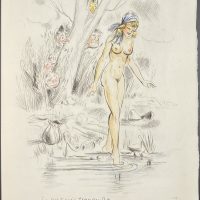
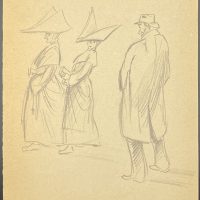
-
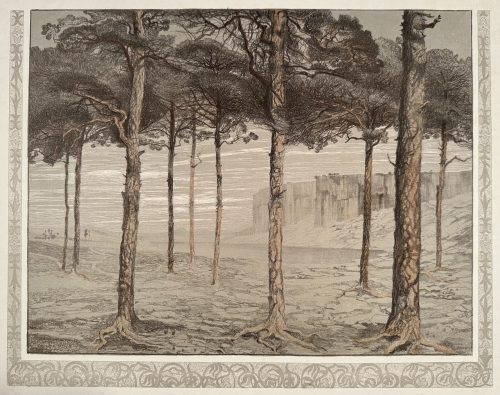 Colour (tone) lithography, image 396 x 508 mm, sheet 532 x 654 mm; before signature, undated; pencil ms inscription: Föhrenhain — E. Pelikan / 200M to the lower-right corner of the sheet. Contributor: Emilie Mediz-Pelikan (Austrian, 1861 – 1908) – artist. Seller's description: Austrian-German painter and graphic artist. Emilie Mediz-Pelikan was born in Vöcklabruck in 1861. She studied at the Vienna Academy and followed her teacher Albert Zimmermann to Salzburg and in 1885 to Munich. In 1891 she married the painter and graphic artist Karl Mediz (1868 - 1945), with whom she lived in Vienna and from 1894 in Dresden. She was in contact with the Dachau Artists' Colony and went on study trips to Paris, Belgium, Hungary and Italy. In the Dachau artists' colony she was friends with Adolf Hölzel and Fritz von Uhde. In 1889 and 1890 she spent time in Paris and in the Belgian artists' colony Knokke. In 1898 she was represented at the first art exhibition of the Vienna Secession, and in 1901 at the International Art Exhibition in Dresden. In 1903 she and her husband had a group exhibition, at the Hagenbund in Vienna. In 1904, she showed graphic works at the Dresden royal court art dealer Richter, and in 1905 and 1906 she exhibited at the Berlin Künstlerhaus. It was not until around 1900 that she achieved her artistic breakthrough with her landscape paintings. Since the estate of the artist, who died prematurely in Dresden in 1908, was lost in the former GDR until the 1980s, it was quite late that the artist was rediscovered and revalued both in Austrian art history and on the art market. In 1986, the first major exhibitions took place at the Upper Austrian State Museum and the University of Applied Arts in Vienna, followed by numerous smaller exhibitions in private galleries in Vienna, Linz and Munich. The artist received recognition during her lifetime from numerous prominent fellow painters as well as from the art critic Ludwig Hevesi. Together with Tina Blau, Herbert Boeckl, Marie Egner, Theodor von Hörmann, Franz Jaschke, Eugen Jettel, Ludwig Heinrich Jungnickel, Rudolf Junk, Gustav Klimt, Oskar Kokoschka, Johann Victor Krämer, Heinrich Kühn, Carl Moll, Rudolf Quittner, Rudolf Ribarz, Emil Jakob Schindler, Max Suppantschitsch, Max Weiler, Olga Wisinger-Florian and Alfred Zoff, she was a protagonist of the reception of Impressionism in Austria. This style went down in Austrian art history under the term "Stimmungsimpressionismus".
Colour (tone) lithography, image 396 x 508 mm, sheet 532 x 654 mm; before signature, undated; pencil ms inscription: Föhrenhain — E. Pelikan / 200M to the lower-right corner of the sheet. Contributor: Emilie Mediz-Pelikan (Austrian, 1861 – 1908) – artist. Seller's description: Austrian-German painter and graphic artist. Emilie Mediz-Pelikan was born in Vöcklabruck in 1861. She studied at the Vienna Academy and followed her teacher Albert Zimmermann to Salzburg and in 1885 to Munich. In 1891 she married the painter and graphic artist Karl Mediz (1868 - 1945), with whom she lived in Vienna and from 1894 in Dresden. She was in contact with the Dachau Artists' Colony and went on study trips to Paris, Belgium, Hungary and Italy. In the Dachau artists' colony she was friends with Adolf Hölzel and Fritz von Uhde. In 1889 and 1890 she spent time in Paris and in the Belgian artists' colony Knokke. In 1898 she was represented at the first art exhibition of the Vienna Secession, and in 1901 at the International Art Exhibition in Dresden. In 1903 she and her husband had a group exhibition, at the Hagenbund in Vienna. In 1904, she showed graphic works at the Dresden royal court art dealer Richter, and in 1905 and 1906 she exhibited at the Berlin Künstlerhaus. It was not until around 1900 that she achieved her artistic breakthrough with her landscape paintings. Since the estate of the artist, who died prematurely in Dresden in 1908, was lost in the former GDR until the 1980s, it was quite late that the artist was rediscovered and revalued both in Austrian art history and on the art market. In 1986, the first major exhibitions took place at the Upper Austrian State Museum and the University of Applied Arts in Vienna, followed by numerous smaller exhibitions in private galleries in Vienna, Linz and Munich. The artist received recognition during her lifetime from numerous prominent fellow painters as well as from the art critic Ludwig Hevesi. Together with Tina Blau, Herbert Boeckl, Marie Egner, Theodor von Hörmann, Franz Jaschke, Eugen Jettel, Ludwig Heinrich Jungnickel, Rudolf Junk, Gustav Klimt, Oskar Kokoschka, Johann Victor Krämer, Heinrich Kühn, Carl Moll, Rudolf Quittner, Rudolf Ribarz, Emil Jakob Schindler, Max Suppantschitsch, Max Weiler, Olga Wisinger-Florian and Alfred Zoff, she was a protagonist of the reception of Impressionism in Austria. This style went down in Austrian art history under the term "Stimmungsimpressionismus". -
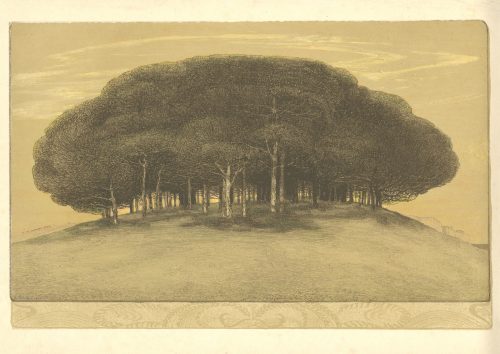 Colour (tone) lithography, image 268 x 410 mm, sheet 317 x 470 mm; signed on bottom-left of the image “Pelikan 1905”, and pencil ms inscription: E. Pelikan to the lower-right corner of the sheet. Contributor: Emilie Mediz-Pelikan (Austrian, 1861 – 1908) – artist. Seller's description: Austrian-German painter and graphic artist. Emilie Mediz-Pelikan was born in Vöcklabruck in 1861. She studied at the Vienna Academy and followed her teacher Albert Zimmermann to Salzburg and in 1885 to Munich. In 1891 she married the painter and graphic artist Karl Mediz (1868 - 1945), with whom she lived in Vienna and from 1894 in Dresden. She was in contact with the Dachau Artists' Colony and went on study trips to Paris, Belgium, Hungary and Italy. In the Dachau artists' colony she was friends with Adolf Hölzel and Fritz von Uhde. In 1889 and 1890 she spent time in Paris and in the Belgian artists' colony Knokke. In 1898 she was represented at the first art exhibition of the Vienna Secession, and in 1901 at the International Art Exhibition in Dresden. In 1903 she and her husband had a group exhibition, at the Hagenbund in Vienna. In 1904, she showed graphic works at the Dresden royal court art dealer Richter, and in 1905 and 1906 she exhibited at the Berlin Künstlerhaus. It was not until around 1900 that she achieved her artistic breakthrough with her landscape paintings. Since the estate of the artist, who died prematurely in Dresden in 1908, was lost in the former GDR until the 1980s, it was quite late that the artist was rediscovered and revalued both in Austrian art history and on the art market. In 1986, the first major exhibitions took place at the Upper Austrian State Museum and the University of Applied Arts in Vienna, followed by numerous smaller exhibitions in private galleries in Vienna, Linz and Munich. The artist received recognition during her lifetime from numerous prominent fellow painters as well as from the art critic Ludwig Hevesi. Together with Tina Blau, Herbert Boeckl, Marie Egner, Theodor von Hörmann, Franz Jaschke, Eugen Jettel, Ludwig Heinrich Jungnickel, Rudolf Junk, Gustav Klimt, Oskar Kokoschka, Johann Victor Krämer, Heinrich Kühn, Carl Moll, Rudolf Quittner, Rudolf Ribarz, Emil Jakob Schindler, Max Suppantschitsch, Max Weiler, Olga Wisinger-Florian and Alfred Zoff, she was a protagonist of the reception of Impressionism in Austria. This style went down in Austrian art history under the term "Stimmungsimpressionismus".
Colour (tone) lithography, image 268 x 410 mm, sheet 317 x 470 mm; signed on bottom-left of the image “Pelikan 1905”, and pencil ms inscription: E. Pelikan to the lower-right corner of the sheet. Contributor: Emilie Mediz-Pelikan (Austrian, 1861 – 1908) – artist. Seller's description: Austrian-German painter and graphic artist. Emilie Mediz-Pelikan was born in Vöcklabruck in 1861. She studied at the Vienna Academy and followed her teacher Albert Zimmermann to Salzburg and in 1885 to Munich. In 1891 she married the painter and graphic artist Karl Mediz (1868 - 1945), with whom she lived in Vienna and from 1894 in Dresden. She was in contact with the Dachau Artists' Colony and went on study trips to Paris, Belgium, Hungary and Italy. In the Dachau artists' colony she was friends with Adolf Hölzel and Fritz von Uhde. In 1889 and 1890 she spent time in Paris and in the Belgian artists' colony Knokke. In 1898 she was represented at the first art exhibition of the Vienna Secession, and in 1901 at the International Art Exhibition in Dresden. In 1903 she and her husband had a group exhibition, at the Hagenbund in Vienna. In 1904, she showed graphic works at the Dresden royal court art dealer Richter, and in 1905 and 1906 she exhibited at the Berlin Künstlerhaus. It was not until around 1900 that she achieved her artistic breakthrough with her landscape paintings. Since the estate of the artist, who died prematurely in Dresden in 1908, was lost in the former GDR until the 1980s, it was quite late that the artist was rediscovered and revalued both in Austrian art history and on the art market. In 1986, the first major exhibitions took place at the Upper Austrian State Museum and the University of Applied Arts in Vienna, followed by numerous smaller exhibitions in private galleries in Vienna, Linz and Munich. The artist received recognition during her lifetime from numerous prominent fellow painters as well as from the art critic Ludwig Hevesi. Together with Tina Blau, Herbert Boeckl, Marie Egner, Theodor von Hörmann, Franz Jaschke, Eugen Jettel, Ludwig Heinrich Jungnickel, Rudolf Junk, Gustav Klimt, Oskar Kokoschka, Johann Victor Krämer, Heinrich Kühn, Carl Moll, Rudolf Quittner, Rudolf Ribarz, Emil Jakob Schindler, Max Suppantschitsch, Max Weiler, Olga Wisinger-Florian and Alfred Zoff, she was a protagonist of the reception of Impressionism in Austria. This style went down in Austrian art history under the term "Stimmungsimpressionismus". -
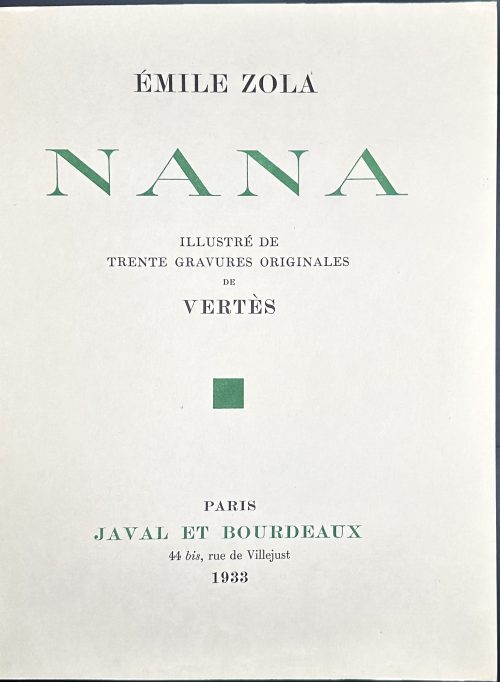 Publisher’s olive French flapped wrappers, in-4to, 33 x 25.3 x 6 cm, green and black lettering to front and spine, in a glassine dust jacket, in a marbled double slipcase 34.5 x 25.5 cm, unbound; pp.: [8] 1-436 [4], plus 30 colour plates with guard tissue, extraneous to collation; edition enriched with a set of 30 uncoloured etchings with guard tissue in a lettered paper folder. Title-page: ÉMILE ZOLA | NANA | ILLUSTRÉ DE | TRENTE GRAVURES ORIGINALES | DE | VERTÈS |◾| PARIS | JAVAL ET BOURDEAUX | 44 bis, rue de Villejust | 1933 || Justification du tirage: il a été tiré de «Nana » d'Émile Zola. Soixante exemplaires sur japon impérial, numérotés de 1 a 60, avec un état en couleurs colorié a la main et un état en noir des trente gravures originales de Vertès. [Edition limited to 60 copies, this is copy № 54]. Colophon: « NANA », D'ÉMILE ZOLA, ÉTÉ ACHEVÉ D'IMPRIMER LE TRENTE AVRIL MIL NEUF CENT TRENTE-TROIS, EN CARACTÈRES ROMAIN ANGLAIS DU CORPS 16, SUR LES PRESSES DU MAITRE IMPRIMEUR COULOUMA, À ARGENTEUIL, H. BARTHÉLEMY, DIRECTEUR. LES COMPOSITIONS DE VERTÈS ONT ÉTÉ REPRODUITES EN FAC-SIMILÉ PAR D. JACOMET & Cie. Printed on April 30, 1933 by Coulouma in Argenteuil, H. Barthélemy, director; illustrations reproduced in facsimile by D. Jacomet & Co. Catalogue raisonné: Vokaer 30. Contributors: Émile Zola (French, 1840 – 1902) – author. Marcel Vertès [Marcell Vértes] (Jewish-Hungarian-French, 1895 – 1961) – artist. Javal et Bourdeaux – publisher. Daniel Jacomet (French, 1894 – 1966) – printer. Seller's description: Nana. Paris, Javal et Bourdeaux, 1933. 2 volumes in-4, en feuilles, non coupé, non rogné, chemise et étui. Ouvrage illustré de 30 gravures originales en couleurs de Marcel Vertès. Tirage à 60 exemplaires sur japon impérial contenant un état des illustrations coloriées à la main en couleurs et un état en noir. Chemise et emboîtage insolés.
Publisher’s olive French flapped wrappers, in-4to, 33 x 25.3 x 6 cm, green and black lettering to front and spine, in a glassine dust jacket, in a marbled double slipcase 34.5 x 25.5 cm, unbound; pp.: [8] 1-436 [4], plus 30 colour plates with guard tissue, extraneous to collation; edition enriched with a set of 30 uncoloured etchings with guard tissue in a lettered paper folder. Title-page: ÉMILE ZOLA | NANA | ILLUSTRÉ DE | TRENTE GRAVURES ORIGINALES | DE | VERTÈS |◾| PARIS | JAVAL ET BOURDEAUX | 44 bis, rue de Villejust | 1933 || Justification du tirage: il a été tiré de «Nana » d'Émile Zola. Soixante exemplaires sur japon impérial, numérotés de 1 a 60, avec un état en couleurs colorié a la main et un état en noir des trente gravures originales de Vertès. [Edition limited to 60 copies, this is copy № 54]. Colophon: « NANA », D'ÉMILE ZOLA, ÉTÉ ACHEVÉ D'IMPRIMER LE TRENTE AVRIL MIL NEUF CENT TRENTE-TROIS, EN CARACTÈRES ROMAIN ANGLAIS DU CORPS 16, SUR LES PRESSES DU MAITRE IMPRIMEUR COULOUMA, À ARGENTEUIL, H. BARTHÉLEMY, DIRECTEUR. LES COMPOSITIONS DE VERTÈS ONT ÉTÉ REPRODUITES EN FAC-SIMILÉ PAR D. JACOMET & Cie. Printed on April 30, 1933 by Coulouma in Argenteuil, H. Barthélemy, director; illustrations reproduced in facsimile by D. Jacomet & Co. Catalogue raisonné: Vokaer 30. Contributors: Émile Zola (French, 1840 – 1902) – author. Marcel Vertès [Marcell Vértes] (Jewish-Hungarian-French, 1895 – 1961) – artist. Javal et Bourdeaux – publisher. Daniel Jacomet (French, 1894 – 1966) – printer. Seller's description: Nana. Paris, Javal et Bourdeaux, 1933. 2 volumes in-4, en feuilles, non coupé, non rogné, chemise et étui. Ouvrage illustré de 30 gravures originales en couleurs de Marcel Vertès. Tirage à 60 exemplaires sur japon impérial contenant un état des illustrations coloriées à la main en couleurs et un état en noir. Chemise et emboîtage insolés. -
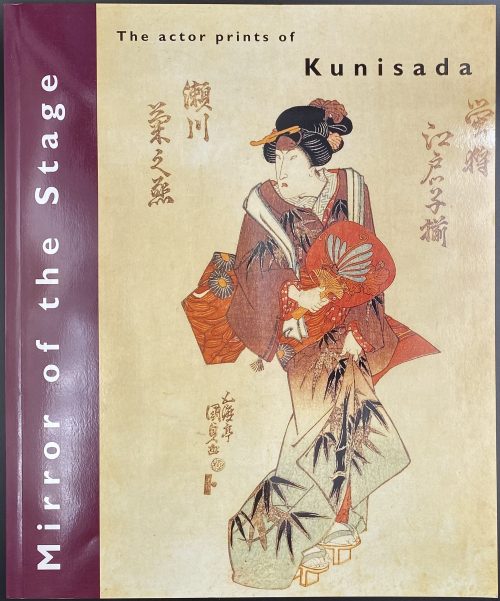 Thin booklet in glossy pictorial wrappers, 29.8 x 24.7 cm, pp.: [1-4] 5-48, 24 leaves total, illustrated. Errata tipped in after the front wrapper. Title-page: Mirror | of the stage | The actor prints of | Kunisada | Ellis Tinios | The University Gallery Leeds || Colophon: Published in March 1996 for the exhibition Mirror of the Stage held at the University Gallery Leeds 24 April-30 May 1996. Introduction: "This book [exhibition catalogue] has been written as an introduction to nineteenth-century Japanese colour woodblock actor prints and to the achievements of the artist Kunisada in that field [as well as to accompany the exhibition of the same name]. It is divided into three sections. In the first, I examine four topics: the social and cultural milieu that gave rise to the production of prints as items of mass consumption; the aesthetic of the actor print; the economics of print production (including consideration of the numbers issued, the prices at which they were sold and their rates of survival); and the process by which prints were produced. The second section consists of sixteen colour plates with commentaries. In the final section, I survey Kunisada's career." Subject: Utagawa, Kunisada, — 1786-1864 — Exhibitions; Ukiyo-e — Exhibitions; Colour prints, Japanese — Edo period, 1600-1868 — Exhibitions. Contributors: Ellis Tinios Utagawa Kunisada [歌川 国貞] a.k.a. Utagawa Toyokuni III [三代歌川豊国] (Japanese, 1786 – 1865). Select illustrations (references in this collection):
Thin booklet in glossy pictorial wrappers, 29.8 x 24.7 cm, pp.: [1-4] 5-48, 24 leaves total, illustrated. Errata tipped in after the front wrapper. Title-page: Mirror | of the stage | The actor prints of | Kunisada | Ellis Tinios | The University Gallery Leeds || Colophon: Published in March 1996 for the exhibition Mirror of the Stage held at the University Gallery Leeds 24 April-30 May 1996. Introduction: "This book [exhibition catalogue] has been written as an introduction to nineteenth-century Japanese colour woodblock actor prints and to the achievements of the artist Kunisada in that field [as well as to accompany the exhibition of the same name]. It is divided into three sections. In the first, I examine four topics: the social and cultural milieu that gave rise to the production of prints as items of mass consumption; the aesthetic of the actor print; the economics of print production (including consideration of the numbers issued, the prices at which they were sold and their rates of survival); and the process by which prints were produced. The second section consists of sixteen colour plates with commentaries. In the final section, I survey Kunisada's career." Subject: Utagawa, Kunisada, — 1786-1864 — Exhibitions; Ukiyo-e — Exhibitions; Colour prints, Japanese — Edo period, 1600-1868 — Exhibitions. Contributors: Ellis Tinios Utagawa Kunisada [歌川 国貞] a.k.a. Utagawa Toyokuni III [三代歌川豊国] (Japanese, 1786 – 1865). Select illustrations (references in this collection):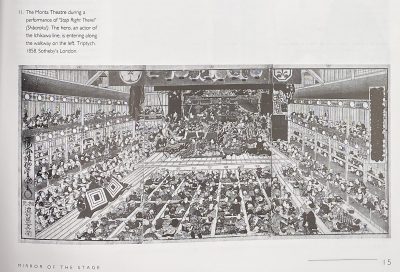
SVJP-0226.2016: Superb Edo pictures illustrating dances, 1858.
-
 Magazine article by Edgar Jepson: The Iron Tsuba of Japan (Section: Oriental Art), published in volume Vol. 70 (September–December) of The Connoisseur: An Illustrated Magazine for Collectors, Vol. 70 (September–December); pp. 143-152 / C. Reginald Grundy [ed.] — London: Published by the Proprietor, W. CLAUSE JOHNSON, at the Editorial and Advertisement Offices of The Connoisseur, 1924. Owner's half black morocco, gilt lettering to spine, blue cloth boards. Two volumes bound together without original covers. Size 28.5 x 22 cm. Vol. 1: The Connoisseur | An Illustrated Magazine | For Collectors | Edited by C. Reginald Grundy | Vol. LXIX. | (MAY—AUGUST, 1924) | LONDON | Published by the Proprietor, W. CLAUSE JOHNSON, at the | Editorial and Advertisement Offices of The Connoisseur, | at 1, Duke Street, St. James's, S.W. 1 | 1924 || Pp.: [i-ii] iii-xviii [xix] [1, 2 - plate] 3-249 [250]. Vol. 2: The Connoisseur | An Illustrated Magazine | For Collectors | Edited by C. Reginald Grundy | Vol. LXX. | (SEPTEMBER—DECEMBER, 1924) | LONDON | Published by the Proprietor, W. CLAUSE JOHNSON, at the | Editorial and Advertisement Offices of The Connoisseur, | at 1, Duke Street, St. James's, S.W. 1 | 1924 || Pp.: [i-ii] iii-xxii [2 blanks] [1, 2 - plate] 3-261 [262]. The Iron Tsuba of Japan by Edgar Jepson The heart of Japan was in the sword. However admirable may be the paintings, the prints, the netsuke, the lacquer, or the bronzes of the Japanese masters, the supreme artistic achievements of Japan were the blades of Masamune, Muramasa, Sadamune, and Rai Kunitsugu. But not a little of the heart of Japan went also in the tsuba, the guard which protected the hand that wielded the blade, into the iron tsuba of the fighting Samurai. Beside the forgers of the iron tsuba of Japan the ironsmiths of the rest of the world have been mere children. The earliest tsuba were of bronze or copper, often gilded. It is probable that they were replaced by iron tsuba during the Kamakura period, the great fighting era, which lasted from A.D. 1185 to 1333. During the later half of the twelfth century leather tsuba, strengthened by thin iron plates or a metal rim, also replaced the bronze and copper tsuba. It was at this time that a family of armourers of the name of Masuda, and in particular Masuda Munesuke, the founder of the Myochin family, began to forge iron tsuba — thin, round plates of great hardness and density. But it is probable that no tsuba perforated with a view to decorative effects were forged before the end of the fourteenth century. These fourteenth-century tsuba are exceedingly rare in England. I have seen none in the museums, none in the famous collections that have been sold during the last ten years. Those photographed in Herr Oeder's book might easily be the fifteenth century. No. 1 is a curious cup-shape tsuba decorated with a bronze and copper inlay. No. 2, with its edges curiously twisted in the forging, looks like Myochin work. But it is not of the Myochin iron. The Myochin family produced some of the greatest ironsmiths of Japan. Armourers first of all, tsubasmiths, forgers of sake-kettles, articulated reptiles, crustacea, and insects — everything that can be done with iron they did; they pushed their medium to its limit. They were forging iron tsuba in 1160, and they were still forging them in 1860. And it was their own iron, or rather their own steel. They discovered the secret of it early, and they kept that secret in the family for all those hundreds of years. There is no mistaking a Myochin tsuba: balance it on your finger and tap it with a piece of metal, always it gives forth a clear bell-like ring that you get from the work of no other ironsmith, Japanese or European. Always the Myochin tsuba is before everything a protection to the hand of the swordsman; to that everything is, as it should be, subordinated. No. 3 is a Myochin tsuba of the fifteenth century, and probably of the early fifteenth century. No. 4, by Myochin Munetaka, perforated with a grotesque figure, is an example of that twisting and twisting of the iron in the forging till it forms a pattern like the grain of wood. The Myochin smiths invented these wood-grain tsuba, and no other smiths equalled them in their forging. In the sixteenth century, the fighting tsuba was probably at its best. It was a century of great tsubasmiths. Then the first Nobuiye, whose tsuba fetched £100 apiece, circa 1800, in Japan, and the first Kaneiye flourished. No. 5 is a tsuba forged by a great smith, Iyesada of Sotome, in the manner of Nobuiye I, decorated with the karakusa tendrils that Nobuiye delighted in, with lightning and clouds. No. 6 is a guard of Sanada Tembo, the chief smith of the Tembo family, stamped, punning fashion, with the character Tembo. Akin to the Tembo tsuba were those of the Kiami and Hoan smiths. Then also the Heianjo smiths and the Owari smiths, especially those of Nagoya and the Yamakichi family, forged their strongest tsuba. Those of the Yamakichi were tested after the forging by being pounded in iron mortars — at least, so the legend runs. But they were a sternly utilitarian family, and I have never seen a Yamakichi tsuba of any beauty. In the later half of the fifteenth century arose the fashion of decorating tsuba with an inlay, zogan, of bronze. The Heianjo tsuba, forged at Kyoto in the latter half of the fifteenth and the beginning of the sixteenth century, were often thus inlaid. The earliest of them were called "Onin", of which No. 7 is an example. In addition to the bronze inlay around the edge, it is inlaid with a representation, some say, of snow; others say, of the duckweed on a pond. No. 8 is probably a Heianjo tsuba, but I am not quite sure about it. The inlaid acacia branches might be very early Shoami work. But to judge by the iron, it is a fifteenth-century tsuba; and the authorities place the beginning of the Shoami school not later than early in the sixteenth century. No. 10 is an example of the Fushimi-zogan, a flat inlay of a light-coloured bronze. These tsuba took their name from the fact that they were first forged at Fushimi, in Yamashiro, in the sixteenth century. It is of the type known as Mon-zukashi, perforated with crests (mon) à jour. The Yoshiro-zogan tsuba were also first forged at Fushimi by Yoshiro Naomasa. They were distinguished from the Fushimi-zogan by the fact that their inlay was generally a little raised-not always-for the inlay of No. 9, a tsuba forged by a later nineteenth-century Yoshiro, is quite flat. It is an interesting tsuba, for, with its decoration grown florid and excessive, it marks the intermediate stage between the simple and delightful designs of the genuine fighting tsuba and the elaborate pictures in gold and silver on the tsuba of the eighteenth-century smiths of Awa and Kyoto, which have become mere ornaments of the goldsmith. The Gomoku-zogan (No. 11) tsuba were probably first forged earlier than the Fushimi and Yoshiro-zogan tsuba. This inlay, in slight relief, is a representation in a light-coloured bronze and copper of twigs caught in the eddies of streams. The seventeenth century and early eighteenth century were the great periods of perforated tsuba. The designs, and they are often admirable, are for the most part in plain fretwork; but they are also chased. No. 12, a crane under an acacia, is a tsuba of a Higo smith, great forgers of fighting tsuba during this period. These smiths also excelled in nunome zogan, a very thin gold and silver inlay, with which they further decorated their perforated guards. The smiths of the Umetada and Shoami families also forged iron tsuba during this period; but their designs, though sometimes pleasing enough, are rarely fine. The best work of Myoju Umetada is in sentoku, not iron. The Choshu smiths, coming later, surpass the perforated guards of both the Umetada and Shoami smiths in beauty of design. No. 13, a lotus in the round, not only fretwork, but also engraved, is a good example of the admirable balance they so often attained in their designs. It is a sufficiently realistic lotus, but yet of a delightful simplicity. In considerable contrast is No. 14, the dragon by Soheishi Soten — one of the only two authentic tsuba of his forging known — the first forger of hikone-bori tsuba, which were in extraordinary favour in Japan during the eighteenth century, and illustrated every important event in Japanese history. It is on the elaborate side, but fine, strong work, and an excellent guard to the hand, for the lighter and more open part, which gives the design its admirable balance, is on the inside, and not exposed to the full swing of an opponent's blade. A few years ago there was a tendency to decry the Namban tsuba as having sprung too directly from foreign sources. But though the original suggestion may have been Chinese, or, as some say, Portuguese, the Japanese made it entirely their own, as characteristically Japanese as anything can well be, but, it must be admitted, of a decadent period. The school took its rise at the beginning of the seventeenth century, and the early tsuba were forged of a specially hard iron, the Wootz, imported from Southern India. No. 15, the signs of the Zodiac, is an excellent tsuba from the fighting point of view. Both it and No. 16 are of quite charming, if elaborate, design, and both of them, with their delicate scroll-work, so astonishingly undercut, are the very last word in the work of the ironsmith-veritable iron lace. To return to the simpler perforated tsuba, the smiths of Akasaka, a suburb of Tokyo, produced probably the most charming designs. Their style derives considerably from the Higo smiths, and their earlier fighting tsuba are very like the Higo tsuba. But always their work was just a little lighter than that of the Higo smiths, and in the end they moved right away from them and became the forgers of very light guards indeed. No. 17, is a representation of the Hiyokudori, the fabulous double bird, in which were reincarnated the souls of the two lovers, Gompachi and Komurasaki; and No. 18, “the tsuba of a hundred ducks "— there are about forty — are characteristic designs of the school. In the work of the Akasaka smiths the balance, which makes the design of a good tsuba so admirable and delightful, attains its height. This admirable balance seems often to be obtained by a deliberate sacrifice of symmetry. About nine hundred and ninety-nine European ironsmiths out of a thousand would have made the right and left sides of the Hiyoku-dori line by line, and perforation by perforation, exactly alike; he would have cut out exactly as many ducks on the one side of “the tsuba of a hundred ducks” as on the other, and made each duck on the right side correspond exactly in position and attitude with a duck on the left side. By variations the tsubasmith attained a finer balance, almost a higher symmetry. No. 19, often called by collectors the "rose-window" tsuba, but really a stylised chrysanthemum, is a favourite design of the Akasaka smiths, but Hizen work and inlaid in the Hizen manner with gold nunome. No. 20 is a Satsuma tsuba of the middle period. The Satsuma smiths of the nineteenth century produced probably the most ornate of all the iron guards, for the most part calibashes and beans with their leaves and tendrils realistic in the extreme, but of charming design. Few crafts have been carried further than that of the tsubasmith; few crafts working in a difficult medium have handled more subjects with greater feeling for beauty or greater liveliness of fancy. It is interesting to note again and again how school influences school, and smith influences smith. But, as in all the applied arts, the finest tsuba were forged by men who never lost sight of the purpose of a tsuba, that it is before everything a protection to the hand, and never subjected that purpose to a passion for virtuosity. Illustrations: No 1. FOURTEENTH-CENTURY TSUBA, WITH BRONZE AND COPPER INLAY No. 2. FOURTEENTH-CENTURY TSUBA, RESEMBLING MYOCHIN WORK No. 3. MYOCHIN TSUBA, FIFTEENTH CENTURY No. 4. MYOCHIN TSUBA, NINETEENTH CENTURY No. 5. SIXTEENTH-CENTURY TSUBA No. 6. SIXTEENTH-CENTURY TSUBA BY IYESADA OF SOTOME BY SANADA TEMBO No. 7. ONIN TSUBA No. 8. HEIANJO (?) TSUBA No. 9. YOSHIRO TSUBA, NINETEENTH CENTURY No. 10. FUSHIMI-ZOGAN, NINETEENTH CENTURY No. 11.- GOMOKU-ZOGAN, SIXTEENTH CENTURY No. 12. HIGO TSUBA, SEVENTEENTH CENTURY No. 13. CHOSHU TSUBA, SEVENTEENTH CENTURY No. 14. SOTEN TSUBA, SEVENTEENTH CENTURY No. 15. NAMBAN TSUBA, EIGHTEENTH CENTURY No. 16. NAMBAN TSUBA, NINETEENTH CENTURY Nos. 17. AND 18. AKASAKA TSUBA, EIGHTEENTH CENTURY No. 19. HIZEN TSUBA, EIGHTEENTH CENTURY No. 20. SATSUMA TSUBA, EIGHTEENTH CENTURY
Magazine article by Edgar Jepson: The Iron Tsuba of Japan (Section: Oriental Art), published in volume Vol. 70 (September–December) of The Connoisseur: An Illustrated Magazine for Collectors, Vol. 70 (September–December); pp. 143-152 / C. Reginald Grundy [ed.] — London: Published by the Proprietor, W. CLAUSE JOHNSON, at the Editorial and Advertisement Offices of The Connoisseur, 1924. Owner's half black morocco, gilt lettering to spine, blue cloth boards. Two volumes bound together without original covers. Size 28.5 x 22 cm. Vol. 1: The Connoisseur | An Illustrated Magazine | For Collectors | Edited by C. Reginald Grundy | Vol. LXIX. | (MAY—AUGUST, 1924) | LONDON | Published by the Proprietor, W. CLAUSE JOHNSON, at the | Editorial and Advertisement Offices of The Connoisseur, | at 1, Duke Street, St. James's, S.W. 1 | 1924 || Pp.: [i-ii] iii-xviii [xix] [1, 2 - plate] 3-249 [250]. Vol. 2: The Connoisseur | An Illustrated Magazine | For Collectors | Edited by C. Reginald Grundy | Vol. LXX. | (SEPTEMBER—DECEMBER, 1924) | LONDON | Published by the Proprietor, W. CLAUSE JOHNSON, at the | Editorial and Advertisement Offices of The Connoisseur, | at 1, Duke Street, St. James's, S.W. 1 | 1924 || Pp.: [i-ii] iii-xxii [2 blanks] [1, 2 - plate] 3-261 [262]. The Iron Tsuba of Japan by Edgar Jepson The heart of Japan was in the sword. However admirable may be the paintings, the prints, the netsuke, the lacquer, or the bronzes of the Japanese masters, the supreme artistic achievements of Japan were the blades of Masamune, Muramasa, Sadamune, and Rai Kunitsugu. But not a little of the heart of Japan went also in the tsuba, the guard which protected the hand that wielded the blade, into the iron tsuba of the fighting Samurai. Beside the forgers of the iron tsuba of Japan the ironsmiths of the rest of the world have been mere children. The earliest tsuba were of bronze or copper, often gilded. It is probable that they were replaced by iron tsuba during the Kamakura period, the great fighting era, which lasted from A.D. 1185 to 1333. During the later half of the twelfth century leather tsuba, strengthened by thin iron plates or a metal rim, also replaced the bronze and copper tsuba. It was at this time that a family of armourers of the name of Masuda, and in particular Masuda Munesuke, the founder of the Myochin family, began to forge iron tsuba — thin, round plates of great hardness and density. But it is probable that no tsuba perforated with a view to decorative effects were forged before the end of the fourteenth century. These fourteenth-century tsuba are exceedingly rare in England. I have seen none in the museums, none in the famous collections that have been sold during the last ten years. Those photographed in Herr Oeder's book might easily be the fifteenth century. No. 1 is a curious cup-shape tsuba decorated with a bronze and copper inlay. No. 2, with its edges curiously twisted in the forging, looks like Myochin work. But it is not of the Myochin iron. The Myochin family produced some of the greatest ironsmiths of Japan. Armourers first of all, tsubasmiths, forgers of sake-kettles, articulated reptiles, crustacea, and insects — everything that can be done with iron they did; they pushed their medium to its limit. They were forging iron tsuba in 1160, and they were still forging them in 1860. And it was their own iron, or rather their own steel. They discovered the secret of it early, and they kept that secret in the family for all those hundreds of years. There is no mistaking a Myochin tsuba: balance it on your finger and tap it with a piece of metal, always it gives forth a clear bell-like ring that you get from the work of no other ironsmith, Japanese or European. Always the Myochin tsuba is before everything a protection to the hand of the swordsman; to that everything is, as it should be, subordinated. No. 3 is a Myochin tsuba of the fifteenth century, and probably of the early fifteenth century. No. 4, by Myochin Munetaka, perforated with a grotesque figure, is an example of that twisting and twisting of the iron in the forging till it forms a pattern like the grain of wood. The Myochin smiths invented these wood-grain tsuba, and no other smiths equalled them in their forging. In the sixteenth century, the fighting tsuba was probably at its best. It was a century of great tsubasmiths. Then the first Nobuiye, whose tsuba fetched £100 apiece, circa 1800, in Japan, and the first Kaneiye flourished. No. 5 is a tsuba forged by a great smith, Iyesada of Sotome, in the manner of Nobuiye I, decorated with the karakusa tendrils that Nobuiye delighted in, with lightning and clouds. No. 6 is a guard of Sanada Tembo, the chief smith of the Tembo family, stamped, punning fashion, with the character Tembo. Akin to the Tembo tsuba were those of the Kiami and Hoan smiths. Then also the Heianjo smiths and the Owari smiths, especially those of Nagoya and the Yamakichi family, forged their strongest tsuba. Those of the Yamakichi were tested after the forging by being pounded in iron mortars — at least, so the legend runs. But they were a sternly utilitarian family, and I have never seen a Yamakichi tsuba of any beauty. In the later half of the fifteenth century arose the fashion of decorating tsuba with an inlay, zogan, of bronze. The Heianjo tsuba, forged at Kyoto in the latter half of the fifteenth and the beginning of the sixteenth century, were often thus inlaid. The earliest of them were called "Onin", of which No. 7 is an example. In addition to the bronze inlay around the edge, it is inlaid with a representation, some say, of snow; others say, of the duckweed on a pond. No. 8 is probably a Heianjo tsuba, but I am not quite sure about it. The inlaid acacia branches might be very early Shoami work. But to judge by the iron, it is a fifteenth-century tsuba; and the authorities place the beginning of the Shoami school not later than early in the sixteenth century. No. 10 is an example of the Fushimi-zogan, a flat inlay of a light-coloured bronze. These tsuba took their name from the fact that they were first forged at Fushimi, in Yamashiro, in the sixteenth century. It is of the type known as Mon-zukashi, perforated with crests (mon) à jour. The Yoshiro-zogan tsuba were also first forged at Fushimi by Yoshiro Naomasa. They were distinguished from the Fushimi-zogan by the fact that their inlay was generally a little raised-not always-for the inlay of No. 9, a tsuba forged by a later nineteenth-century Yoshiro, is quite flat. It is an interesting tsuba, for, with its decoration grown florid and excessive, it marks the intermediate stage between the simple and delightful designs of the genuine fighting tsuba and the elaborate pictures in gold and silver on the tsuba of the eighteenth-century smiths of Awa and Kyoto, which have become mere ornaments of the goldsmith. The Gomoku-zogan (No. 11) tsuba were probably first forged earlier than the Fushimi and Yoshiro-zogan tsuba. This inlay, in slight relief, is a representation in a light-coloured bronze and copper of twigs caught in the eddies of streams. The seventeenth century and early eighteenth century were the great periods of perforated tsuba. The designs, and they are often admirable, are for the most part in plain fretwork; but they are also chased. No. 12, a crane under an acacia, is a tsuba of a Higo smith, great forgers of fighting tsuba during this period. These smiths also excelled in nunome zogan, a very thin gold and silver inlay, with which they further decorated their perforated guards. The smiths of the Umetada and Shoami families also forged iron tsuba during this period; but their designs, though sometimes pleasing enough, are rarely fine. The best work of Myoju Umetada is in sentoku, not iron. The Choshu smiths, coming later, surpass the perforated guards of both the Umetada and Shoami smiths in beauty of design. No. 13, a lotus in the round, not only fretwork, but also engraved, is a good example of the admirable balance they so often attained in their designs. It is a sufficiently realistic lotus, but yet of a delightful simplicity. In considerable contrast is No. 14, the dragon by Soheishi Soten — one of the only two authentic tsuba of his forging known — the first forger of hikone-bori tsuba, which were in extraordinary favour in Japan during the eighteenth century, and illustrated every important event in Japanese history. It is on the elaborate side, but fine, strong work, and an excellent guard to the hand, for the lighter and more open part, which gives the design its admirable balance, is on the inside, and not exposed to the full swing of an opponent's blade. A few years ago there was a tendency to decry the Namban tsuba as having sprung too directly from foreign sources. But though the original suggestion may have been Chinese, or, as some say, Portuguese, the Japanese made it entirely their own, as characteristically Japanese as anything can well be, but, it must be admitted, of a decadent period. The school took its rise at the beginning of the seventeenth century, and the early tsuba were forged of a specially hard iron, the Wootz, imported from Southern India. No. 15, the signs of the Zodiac, is an excellent tsuba from the fighting point of view. Both it and No. 16 are of quite charming, if elaborate, design, and both of them, with their delicate scroll-work, so astonishingly undercut, are the very last word in the work of the ironsmith-veritable iron lace. To return to the simpler perforated tsuba, the smiths of Akasaka, a suburb of Tokyo, produced probably the most charming designs. Their style derives considerably from the Higo smiths, and their earlier fighting tsuba are very like the Higo tsuba. But always their work was just a little lighter than that of the Higo smiths, and in the end they moved right away from them and became the forgers of very light guards indeed. No. 17, is a representation of the Hiyokudori, the fabulous double bird, in which were reincarnated the souls of the two lovers, Gompachi and Komurasaki; and No. 18, “the tsuba of a hundred ducks "— there are about forty — are characteristic designs of the school. In the work of the Akasaka smiths the balance, which makes the design of a good tsuba so admirable and delightful, attains its height. This admirable balance seems often to be obtained by a deliberate sacrifice of symmetry. About nine hundred and ninety-nine European ironsmiths out of a thousand would have made the right and left sides of the Hiyoku-dori line by line, and perforation by perforation, exactly alike; he would have cut out exactly as many ducks on the one side of “the tsuba of a hundred ducks” as on the other, and made each duck on the right side correspond exactly in position and attitude with a duck on the left side. By variations the tsubasmith attained a finer balance, almost a higher symmetry. No. 19, often called by collectors the "rose-window" tsuba, but really a stylised chrysanthemum, is a favourite design of the Akasaka smiths, but Hizen work and inlaid in the Hizen manner with gold nunome. No. 20 is a Satsuma tsuba of the middle period. The Satsuma smiths of the nineteenth century produced probably the most ornate of all the iron guards, for the most part calibashes and beans with their leaves and tendrils realistic in the extreme, but of charming design. Few crafts have been carried further than that of the tsubasmith; few crafts working in a difficult medium have handled more subjects with greater feeling for beauty or greater liveliness of fancy. It is interesting to note again and again how school influences school, and smith influences smith. But, as in all the applied arts, the finest tsuba were forged by men who never lost sight of the purpose of a tsuba, that it is before everything a protection to the hand, and never subjected that purpose to a passion for virtuosity. Illustrations: No 1. FOURTEENTH-CENTURY TSUBA, WITH BRONZE AND COPPER INLAY No. 2. FOURTEENTH-CENTURY TSUBA, RESEMBLING MYOCHIN WORK No. 3. MYOCHIN TSUBA, FIFTEENTH CENTURY No. 4. MYOCHIN TSUBA, NINETEENTH CENTURY No. 5. SIXTEENTH-CENTURY TSUBA No. 6. SIXTEENTH-CENTURY TSUBA BY IYESADA OF SOTOME BY SANADA TEMBO No. 7. ONIN TSUBA No. 8. HEIANJO (?) TSUBA No. 9. YOSHIRO TSUBA, NINETEENTH CENTURY No. 10. FUSHIMI-ZOGAN, NINETEENTH CENTURY No. 11.- GOMOKU-ZOGAN, SIXTEENTH CENTURY No. 12. HIGO TSUBA, SEVENTEENTH CENTURY No. 13. CHOSHU TSUBA, SEVENTEENTH CENTURY No. 14. SOTEN TSUBA, SEVENTEENTH CENTURY No. 15. NAMBAN TSUBA, EIGHTEENTH CENTURY No. 16. NAMBAN TSUBA, NINETEENTH CENTURY Nos. 17. AND 18. AKASAKA TSUBA, EIGHTEENTH CENTURY No. 19. HIZEN TSUBA, EIGHTEENTH CENTURY No. 20. SATSUMA TSUBA, EIGHTEENTH CENTURY -
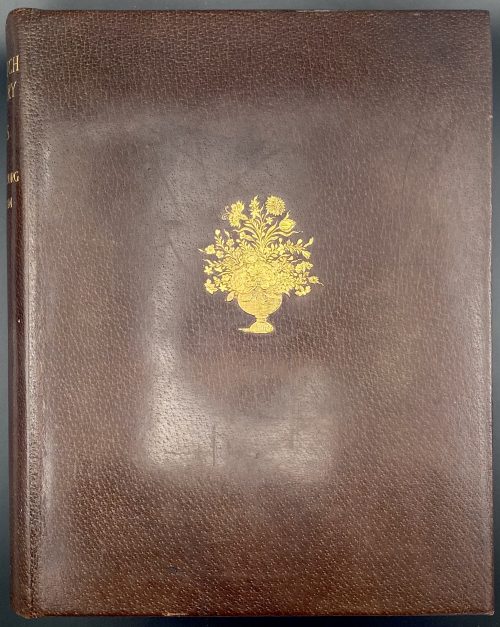 Title: OLD DUTCH | POTTERY AND TILES | BY ELISABETH | NEURDENBURG | LITT. D., READER IN THE HISTORY OF ART AT | THE UNIVERSITY OF GRONINGEN. TRANSLATED | WITH ANNOTATIONS BY | Bernard Rackham | DEPUTY KEEPER, DEPARTMENT | OF CERAMICS, VICTORIA AND | ALBERT MUSEUM | […] | WITH ONE HUNDRED AND TWELVE | ILLUSTRATIONS OF WHICH NINE | ARE IN COLOUR | LONDON: BENN BROTHERS, LIMITED | 8 BOUVERIE STREET, E.C. 4 | 1923 || Verso to half-title: Of this book 100 copies only for sale have been printed on English | hand-made paper, bound in pigskin and signed by the Authoress | and Translator. These copies also contain an extra colour plate. | This in Number “7” (in manuscript) | Two signatures (ink, manuscript) || Pagination: [i, ii] – h.t. / tirage, [iii, iv] – t.p. / imprint, [v, vi] – dedication to Dr. A. Pit / blank, vii-xv [xvi blank] [1, 2] 3-155 [156 blank], frontispiece (colour) and 59 leaves of plates (9 colour) with 112 figures, with lettered protective sheets. Collation: 4to in 8th; [A]8 [B]8 C-K8 L6; frontis., +59 leaves of plates. Binding: 30 x 24 cm, Full dark brown pigskin with gilt ornament to front board and gilt lettering to spine; printed on thick wove paper, top edge gilt, others untrimmed. Contributors: Neurdenburg, Elisabeth (Dutch, 1882 – 1957) – author [autograph]. Rackham, Bernard (British, 1876 – 1964) – translator [autograph]. Brendon, William (British, 1845 – 1928) – printer. Mayflower Press (Plymouth), William Brendon & Son, Ltd. – printer Benn Brothers Ltd. (British company, 1880 – 1987) Benn, Sir John, 1st Baronet (British, 1850 – 1922)
Title: OLD DUTCH | POTTERY AND TILES | BY ELISABETH | NEURDENBURG | LITT. D., READER IN THE HISTORY OF ART AT | THE UNIVERSITY OF GRONINGEN. TRANSLATED | WITH ANNOTATIONS BY | Bernard Rackham | DEPUTY KEEPER, DEPARTMENT | OF CERAMICS, VICTORIA AND | ALBERT MUSEUM | […] | WITH ONE HUNDRED AND TWELVE | ILLUSTRATIONS OF WHICH NINE | ARE IN COLOUR | LONDON: BENN BROTHERS, LIMITED | 8 BOUVERIE STREET, E.C. 4 | 1923 || Verso to half-title: Of this book 100 copies only for sale have been printed on English | hand-made paper, bound in pigskin and signed by the Authoress | and Translator. These copies also contain an extra colour plate. | This in Number “7” (in manuscript) | Two signatures (ink, manuscript) || Pagination: [i, ii] – h.t. / tirage, [iii, iv] – t.p. / imprint, [v, vi] – dedication to Dr. A. Pit / blank, vii-xv [xvi blank] [1, 2] 3-155 [156 blank], frontispiece (colour) and 59 leaves of plates (9 colour) with 112 figures, with lettered protective sheets. Collation: 4to in 8th; [A]8 [B]8 C-K8 L6; frontis., +59 leaves of plates. Binding: 30 x 24 cm, Full dark brown pigskin with gilt ornament to front board and gilt lettering to spine; printed on thick wove paper, top edge gilt, others untrimmed. Contributors: Neurdenburg, Elisabeth (Dutch, 1882 – 1957) – author [autograph]. Rackham, Bernard (British, 1876 – 1964) – translator [autograph]. Brendon, William (British, 1845 – 1928) – printer. Mayflower Press (Plymouth), William Brendon & Son, Ltd. – printer Benn Brothers Ltd. (British company, 1880 – 1987) Benn, Sir John, 1st Baronet (British, 1850 – 1922) -
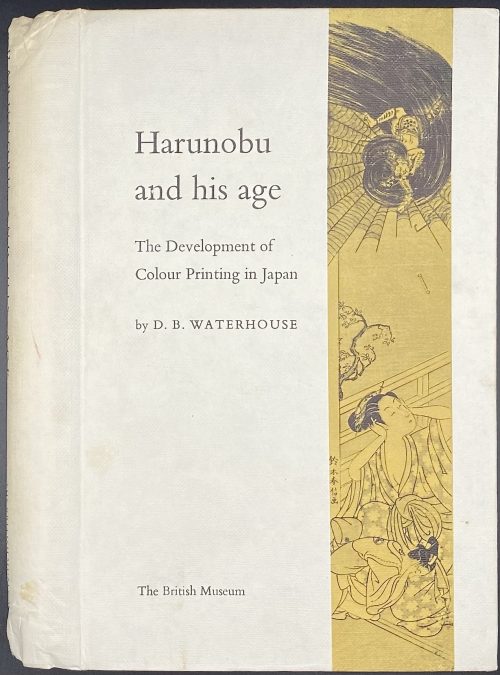
Pictorial cloth boards, spiral-bound, pp.: 3 leaves: h.t., frontis., t.p., 1-326; 123 black & white plates within the pagination.
-
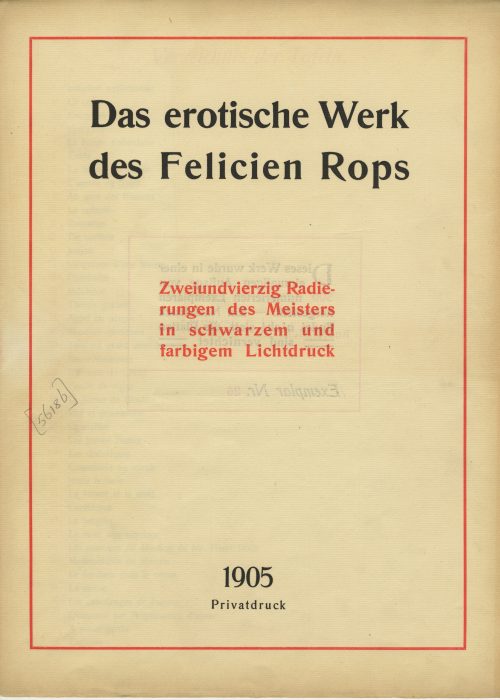
A limited-edition (№26/500) set of 42 etchings and drypoints after Félicien Rops (Belgian, 1833 – 1898), each mounted in a numbered passe-partout, printed posthumously by an anonym in Germany in 1905; in a flapped half faux suede-backed cardboard portfolio with straps, 442 x 335 mm, red embossed lettering to the front cover, bookplate of Richard Teschner (Austrian, 1879 – 1948) pasted inside.
Title-page (in a red frame): Das erotische Werk | des Felicien Rops | Zweiundvierzig Radie- | rungen des Meisters | in schwarzem und | farbigem Lichtdruck | 1905 | Privatdruk ||
Limitation (in a red two-section frame) : Dieses Werk wurde in einer | einmaligen Auflage von | 500 numerierten Exemplaren | hergestellt. — Ein Nachdruck | findet nicht statt, die Platten | == sind vernichtet == | Exemplar Nr. 26 ||
Verzeichnis der Tafeln (Table of Contents): 1. Initiation sentimentale; 2. La croix; 3. Entre-acte; 4. Holocauste; 5. La bonne hollandaise; 6. Étude; 7. La femme au pantin; 8. L’amour de Satan; 9. Au pays des féminies; 10. La volupté; 11. Evocation; 12. De castitate; 13. Joujou; 14. Vengeance d’une femme; 15. Phantasies; 16. Indolence; 17. Théâtre gaillard; 18. Appel au peuple; 19. Masques modernes; 20. Tout est grand chez les rois; 21. Marie-Madeleine; 22. L’amante du Christ; 23. Feuille de vigne; 24. La messe de Guide; 25 Viol et prostitution; 26. Le maillot; 27. Les jeunes France; 28. Les diaboliques; 29. Coquetterie au miroir; 30. Jeune homme; 31. La femme et la mort; 32. Confidence; 33. La bergère; 34. La mère aux satyrions; 35. Les exercices de dévotion de Mr. Henri Roch; 36. Mademoiselle de Maupin; 37. Le bonheur dans le crime; 38. La sirène; 39. Les cabotinages de l’amour; 40. Document sur l’impuissance d’aimer; 41. A cœur perdu; 42. Curieuse.


